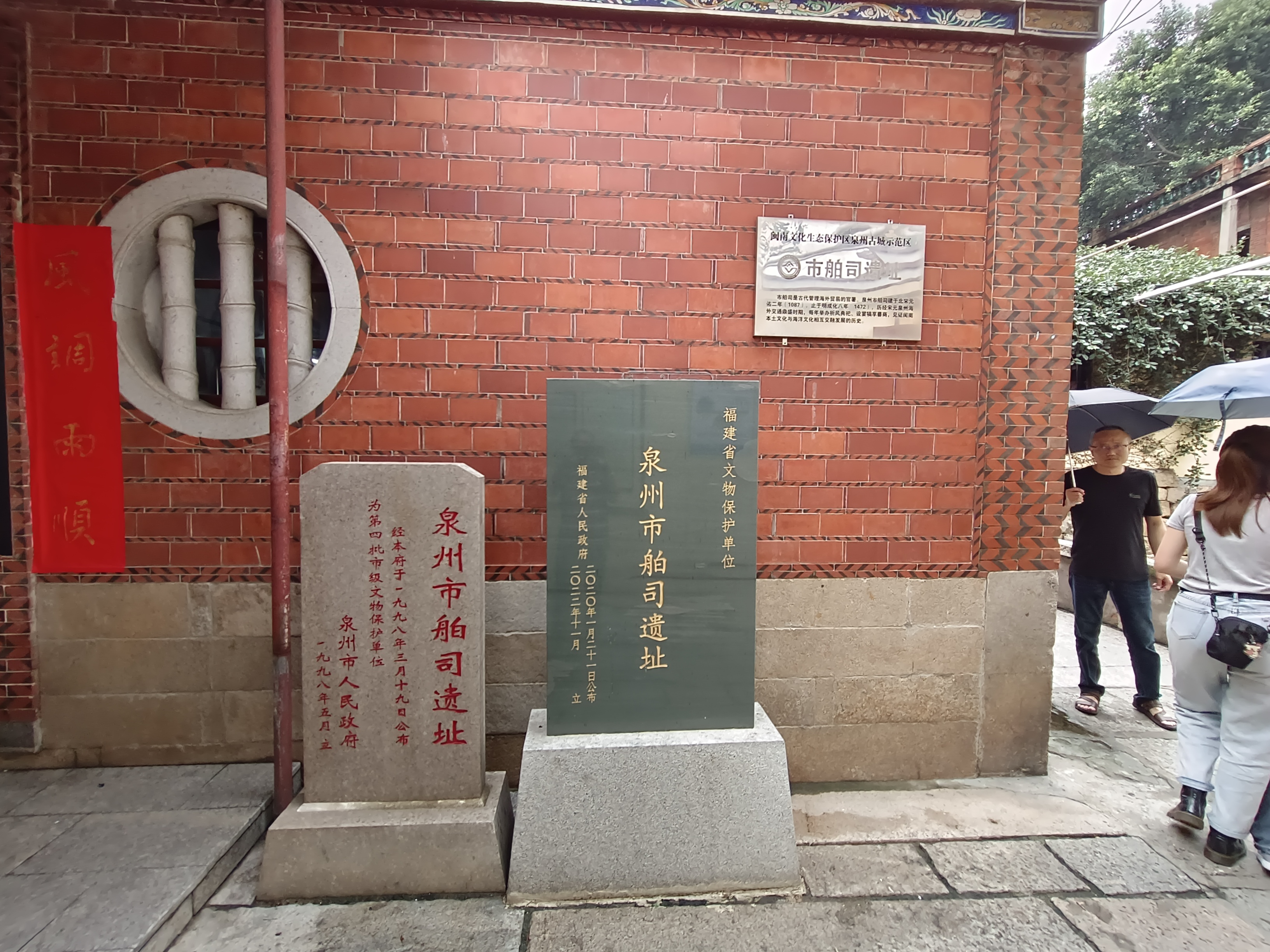
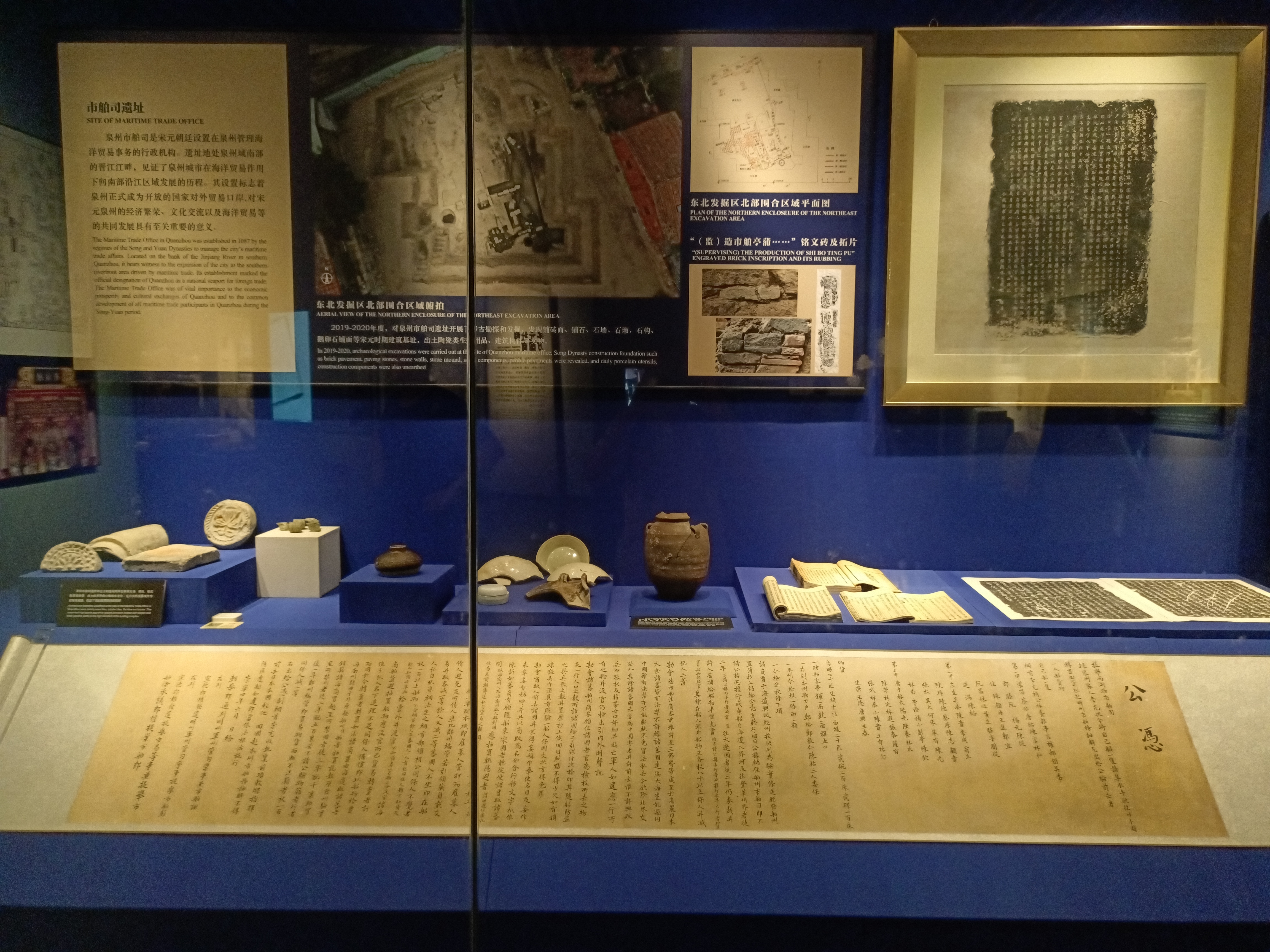
Shi Bosi site and exibits of building parts and trade ceramics fragments excavated from the site.
An overview of Fujian trade Ceramics
During the Tang Dynasty, the ancient maritime trade route became an important avenue of cultural and goods exchange between China and the world. According to the ancient text Akhbar al-Sin wa'l-Hind (An Account of China and India) compiled by Sulayman al-Tajir, Khanfu, ie Guangzhou was the premier port for western trade. Another important reference is "The Book of Roads and Kingdoms", a 9th-century geography text by the Persian geographer Ibn Khordadbeh. It maps and describes the major trade routes of the time within the Muslim world, and discusses distant trading regions including China. It was written around 870 CE, while its author was Director of Posts and Police for the Abbasid province of Djibal. He noted that there were 4 famous ports in China, listed in sequence as al-wakin (Hanoi), Khanfou (Guangzhou), Djanfou and Kantou (江都 )(Yangzhou). Most scholars were in agreement on the interpretation of 3 while Quanzhou and Fuzhou were offered as candidate for Djanfou.
Alhough the port of Quanzhou/Fuzhou had played an important role in the martime trade, it is strange that kilns in Fujian were not notable suppliers of trade ceramics during the Tang/5 Dynasties phase. Based on archaeological and surveys of kilns, ancient habitation/burial sites and cargoes from shipwrecks, Yue and Guandong kilns were the ones that capitalised on their proximity to the port to supply trade ceramics. That situation only started to change after the post of Shi Bosi (市舶使), ie the Superintendent of Maritime Trade was established in Quanzhou in 1087 A.D. during the late Northern Song period. It's role included governing martime boats and trde activitiies, collecting taxes and receiving foreign envoys.
 |
 |
|
Shi Bosi site and exibits of building parts and trade ceramics fragments excavated from the site. |
The introduction of Fujian trade ceramics during the late Northern Song period could be substantiated by recent Chinese marine archaeological surveys in Xisha and also their appearance in the cargo of shipwrecks such as Pulau Buaya, Lingga and the flying fish wrecks. But during the late Northern Song period, Guangzhou was still the most important point of exit for trade with Southeast Asia and the West. Guangdong ceramics was an important component of trade ceramic cargo mix during this phase.
However, the dynamic of trade ceramics took a drastic turn during the Southern song period. Quanzhou was designated as the premier port for trade with Southeast Asia and the West. Undoubtedly, it heralded in a golden period for the coastal kilns in Southern Fujian, known as Minnan (闽南) in Chinese. Fujian trade ceramics , especially green glaze and qingbai/white wares were huge in number and dwarfed that from famous kilns such as Longquan and Jingdezhen.
According to Song period Zhao Rugua's work "zhufanzhi" (赵汝适《诸番志》)(1225), 46 countries (including Annam, Cambodia, Srivijaya, Malay peninsula, Borneo, Java, Estern Indies, the Philippines and even Zanzibar) were listed as China's trading partners and the Yuan period "Daoyi zhilue" by Wang Dayan ( 汪大淵 《岛夷志略》) listed at least 58 countries.
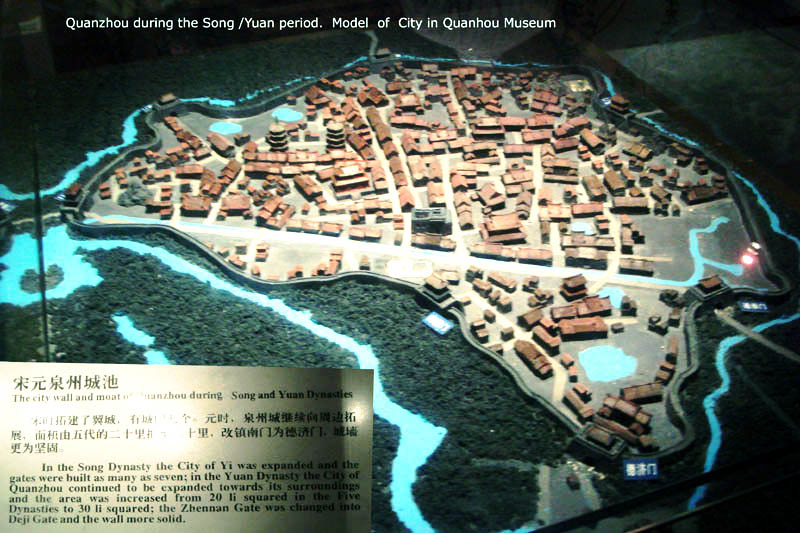
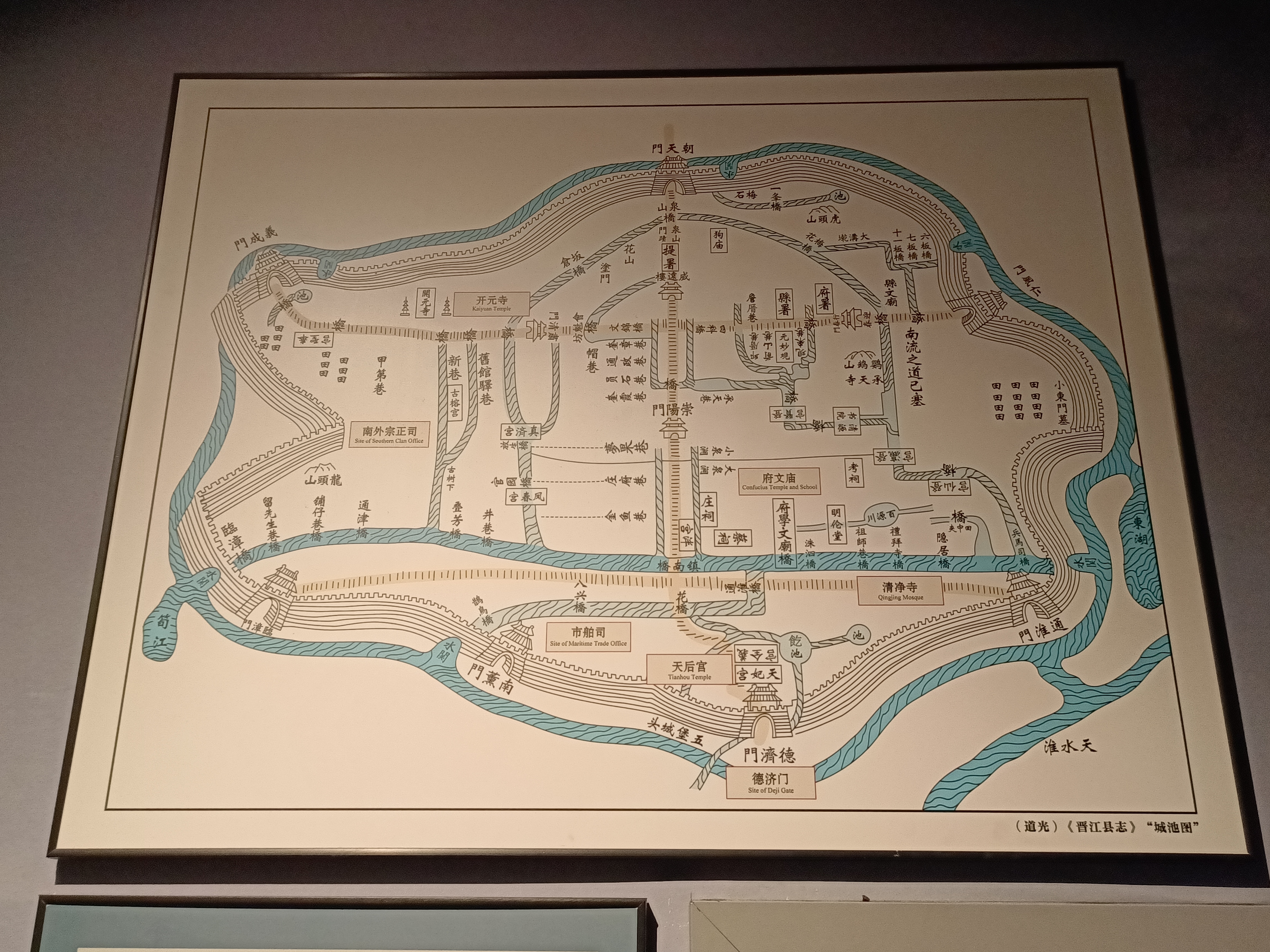
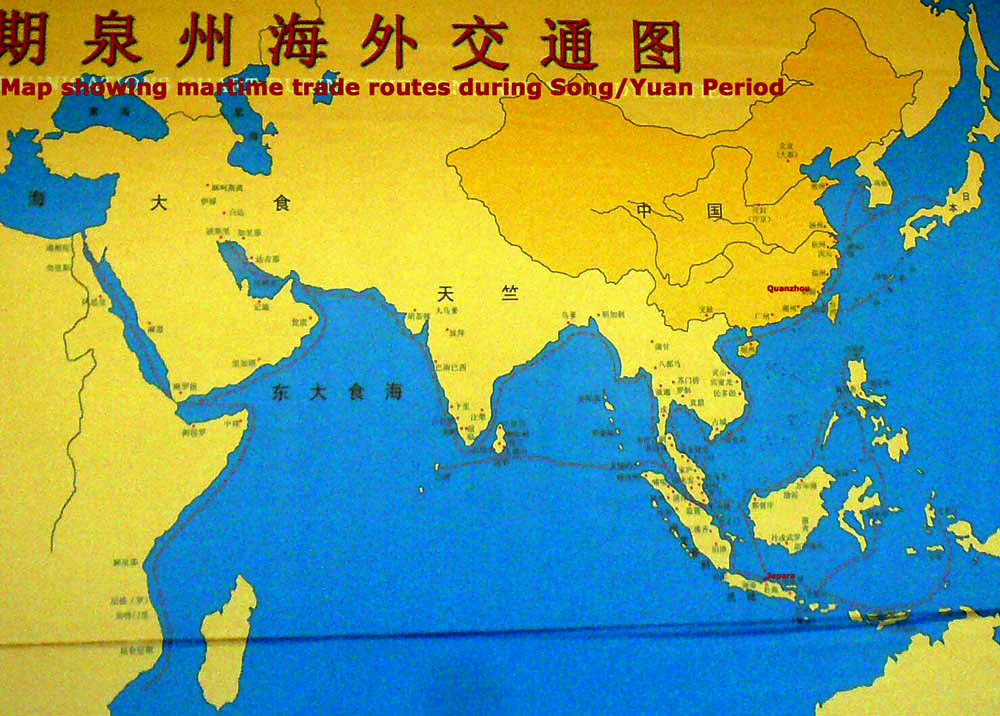
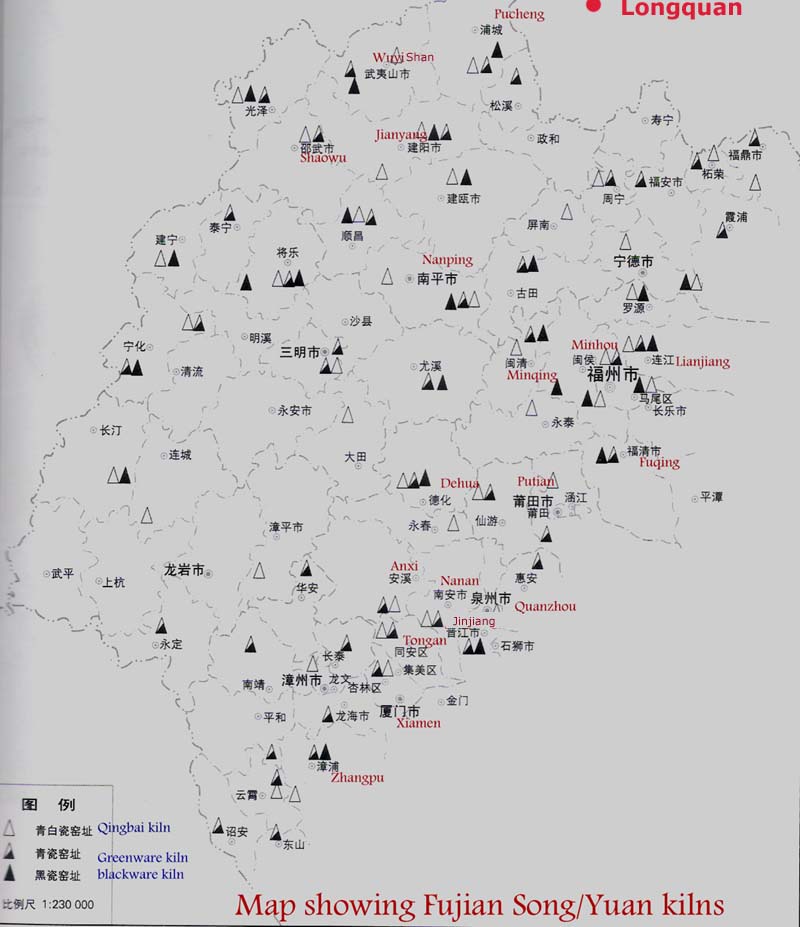
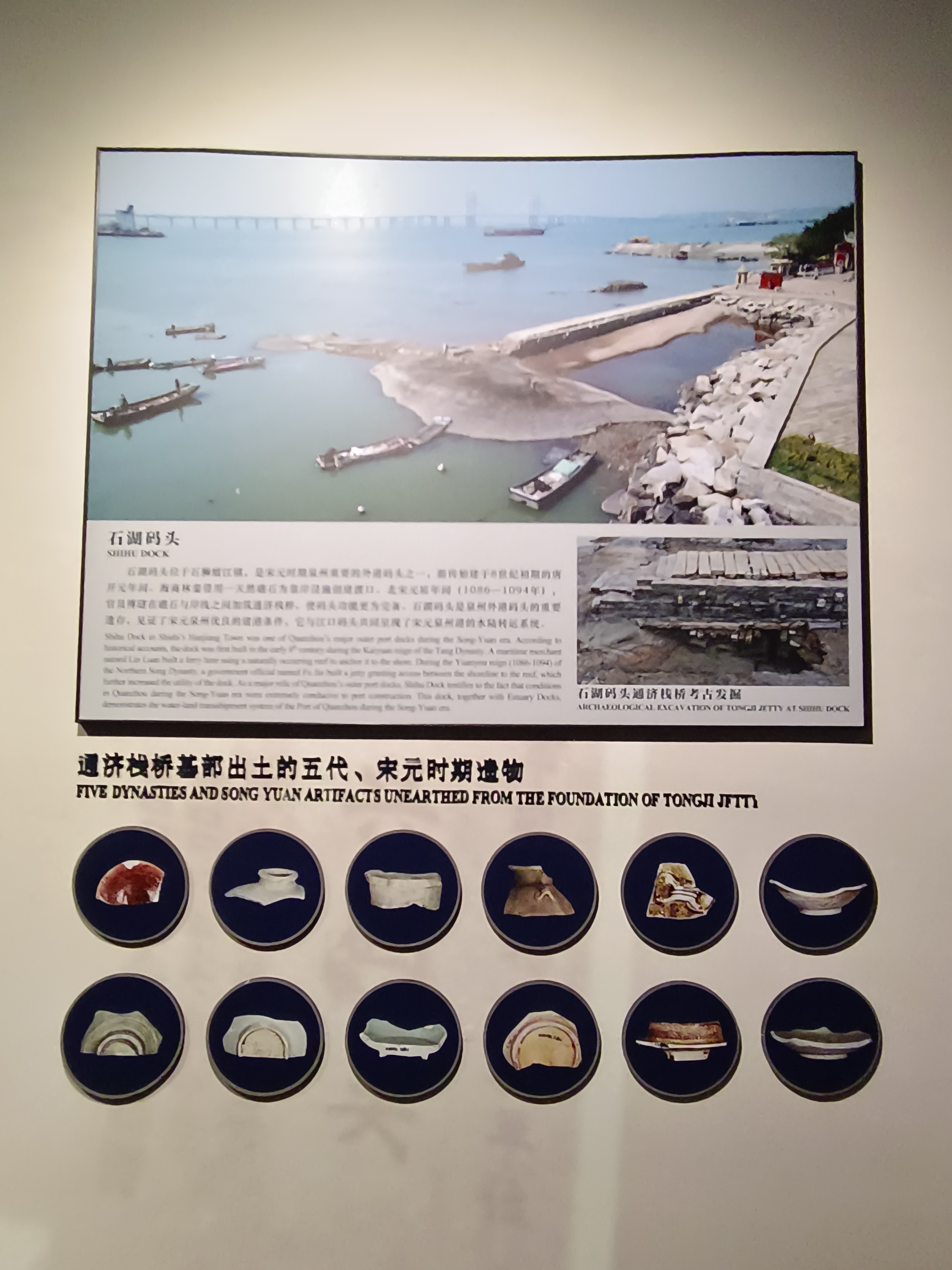 |
 |
| Quanzhou port consisted of network of harbours along Gulf of Quanzhou and wharfs along Jinjiang River. Cargoes from ships docked at he coastal harbours were transported by smaller boats to the wharfs in Jinjiang river and from there made their way to the city. Representative examples include Shihu Matou (a coastal harbour site) and Jiangkou Matou (wharf site along Jinjiang river) were excavated and export ceramics fragments were found. |
But during Yuan period, Longquan and Jingdezhen became the dominant suppliers although Fujian ceramics were still found in significant number. By the Ming/Qing period, Jingdezhen became the undisputed porcelain production centre in China. Fujian kiln operators were still able to capture a niche market, copying the Jingdezhen products but competing base on cheaper pricing.
Song Fujian trade ceramics
Greenware (celadon)
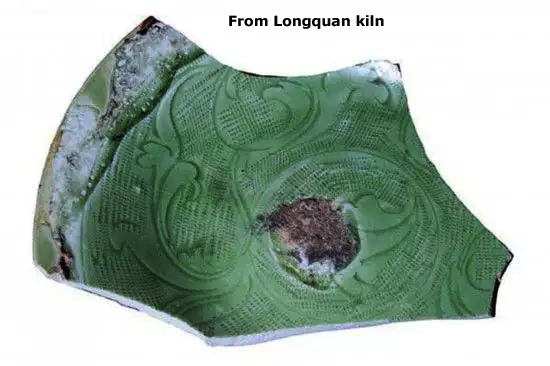 |
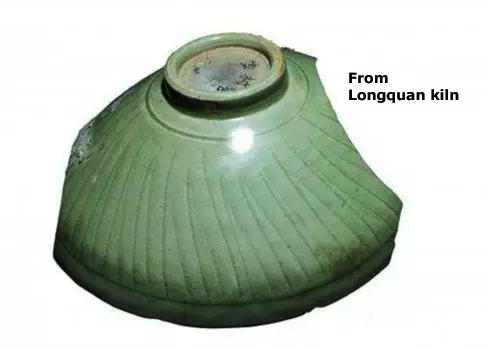 |
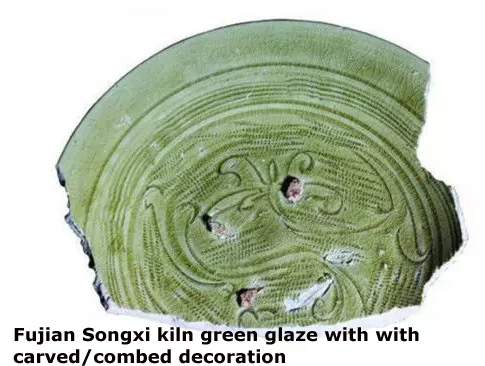 |
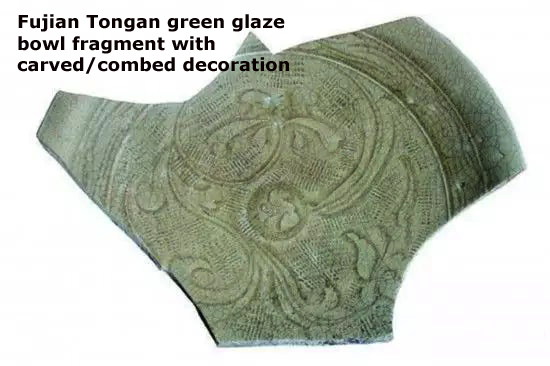 |
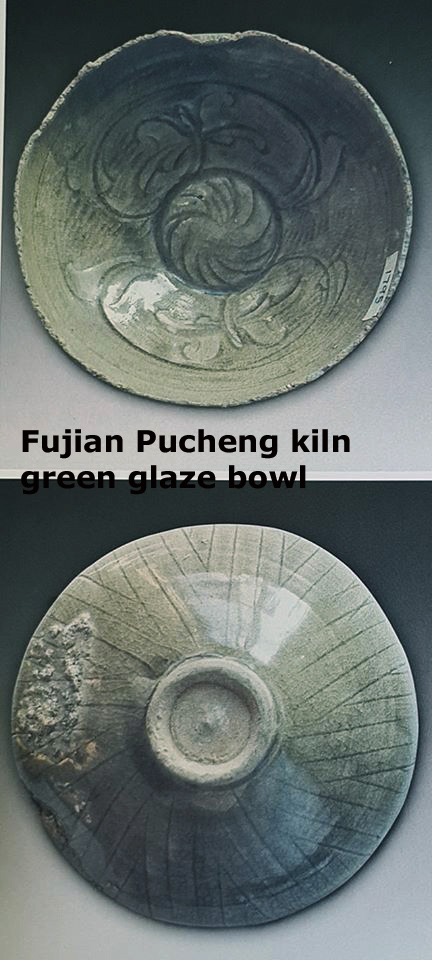
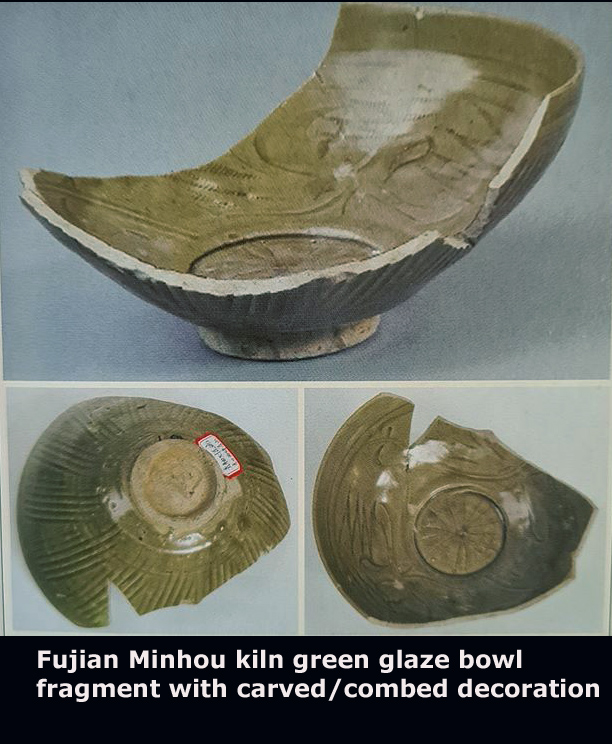
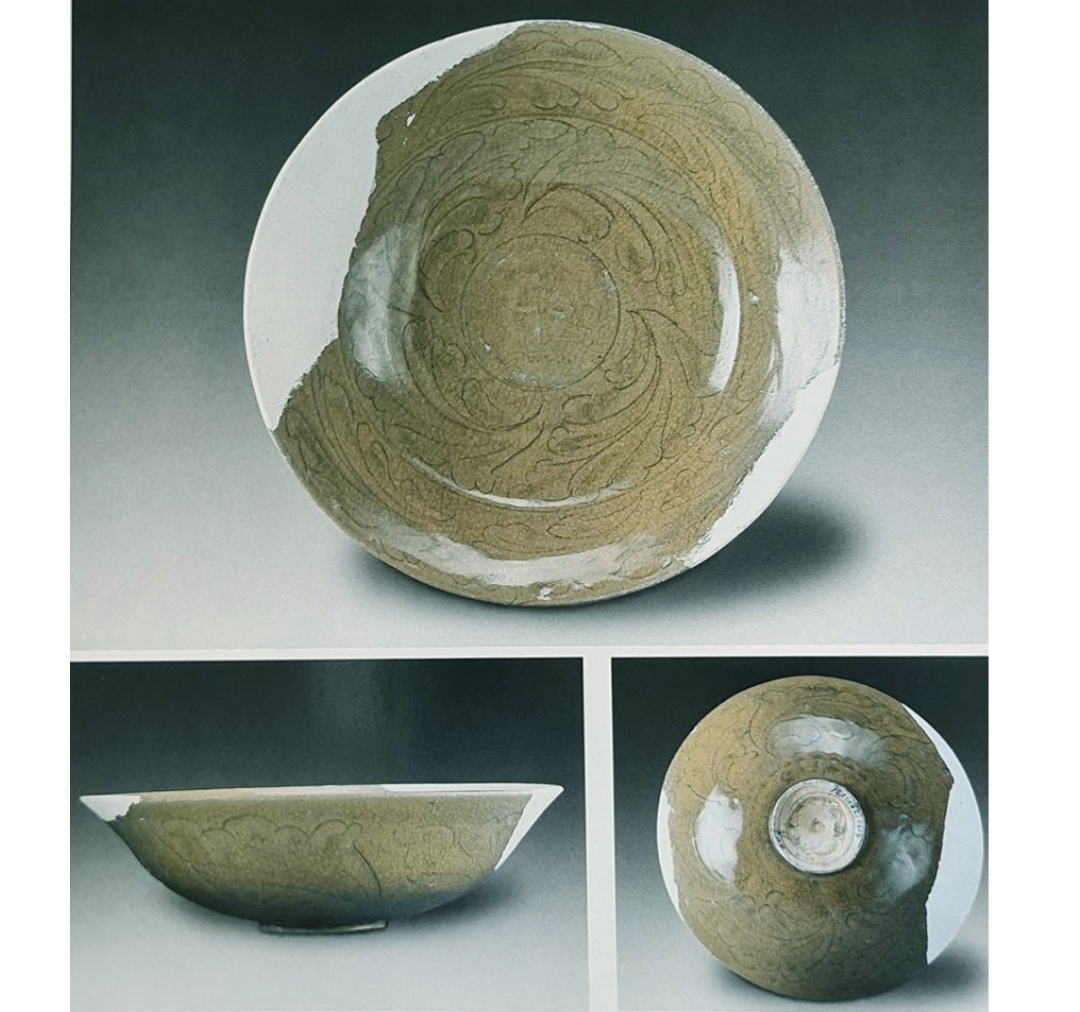 |
| Fujian Southern song Songxi kiln bowl salvaged from the sea near Xisha Islands |
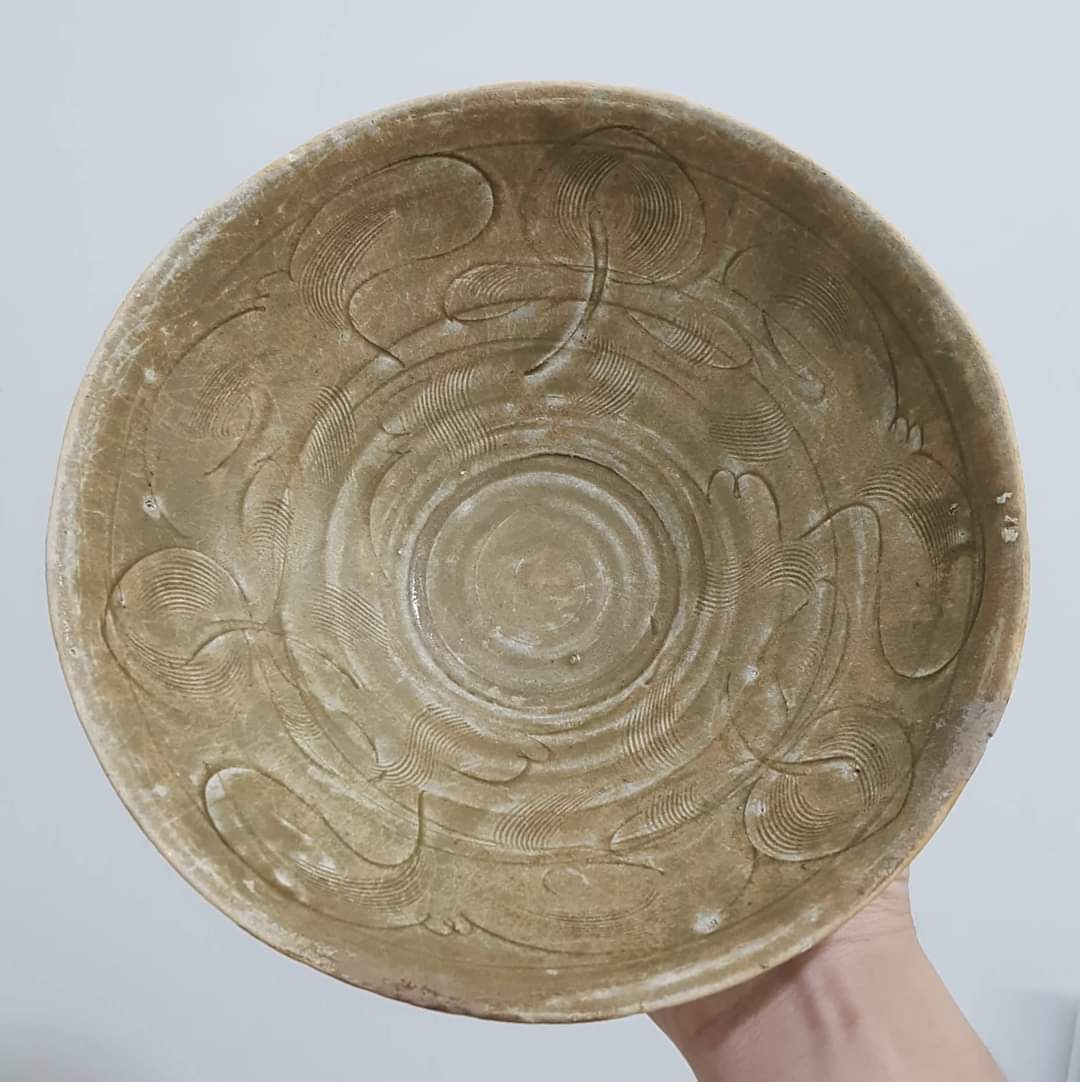 |
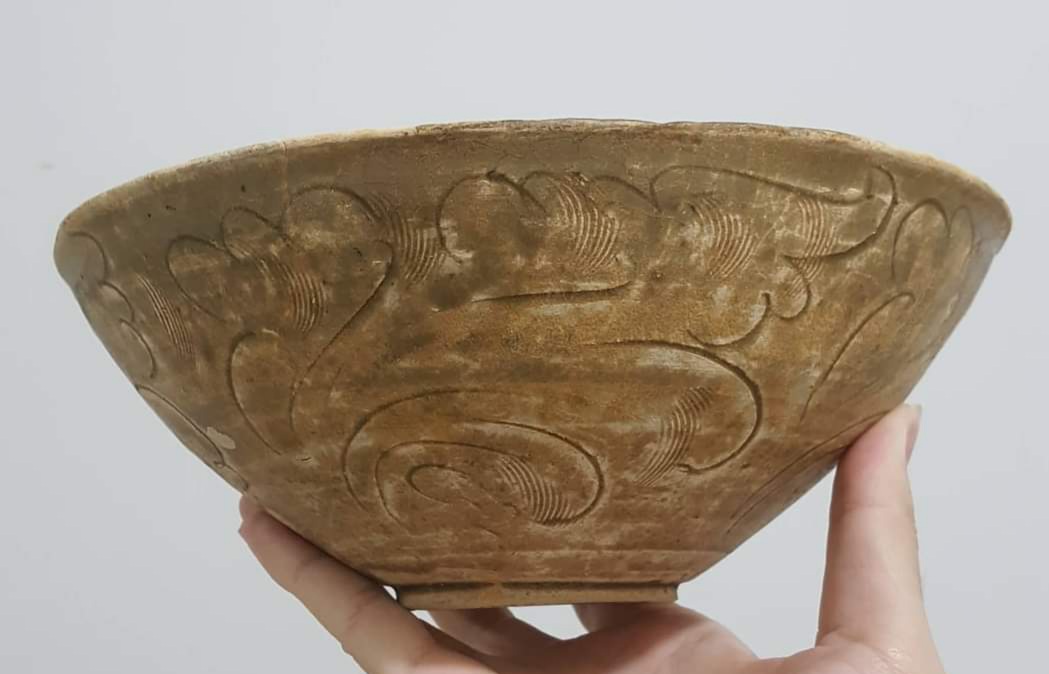 |
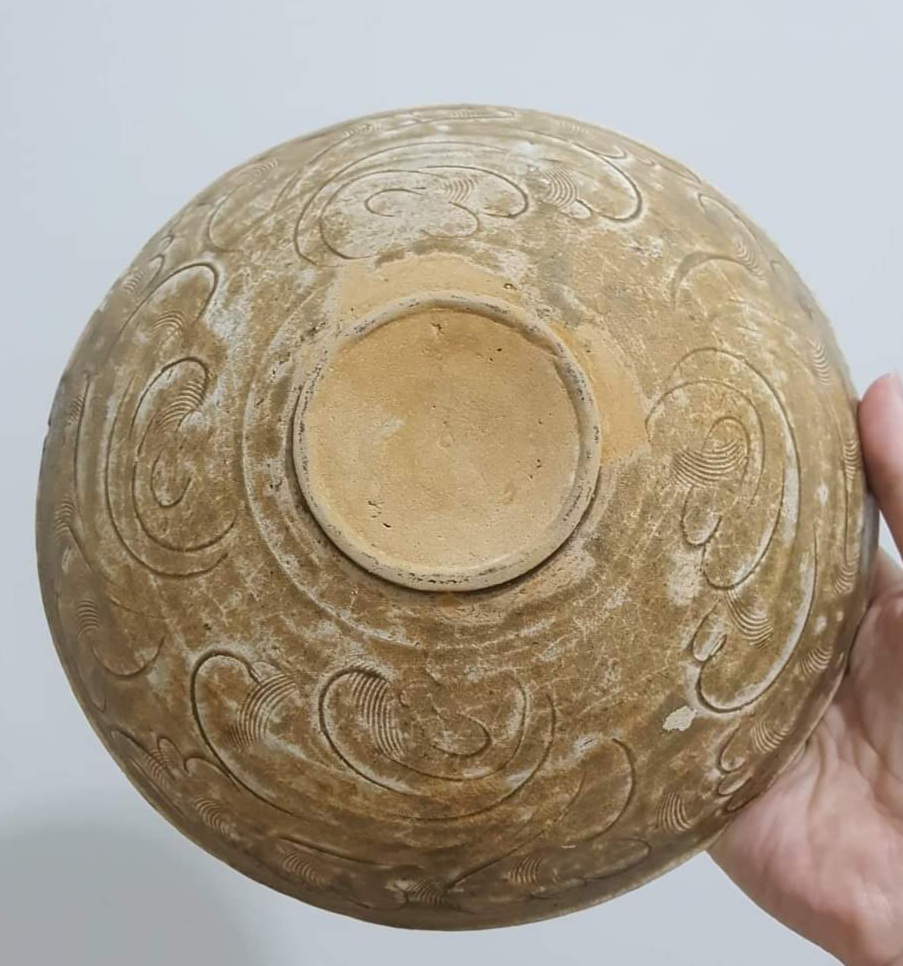 |
| Southern Song Fujian Songxi kiln green glaze big bowl recovered from a wreck near Belitung. Similar examples were found in the Java wreck. |
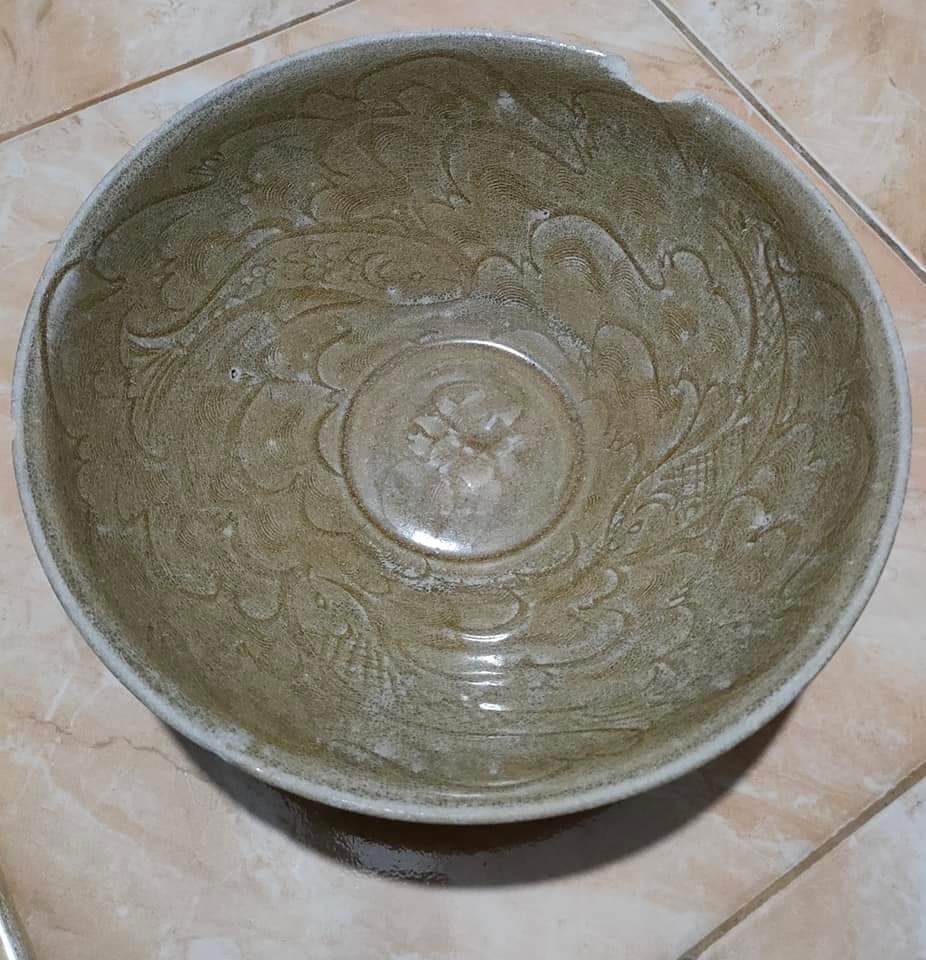 |
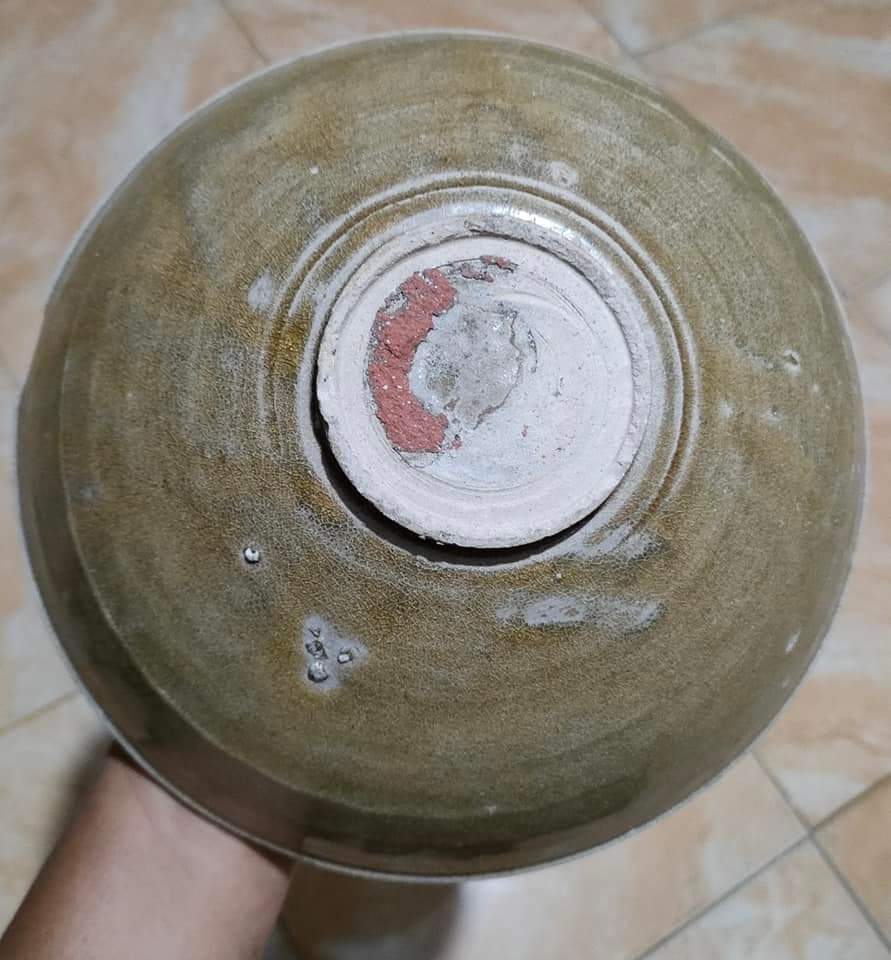 |
| An interesting Songxi kiln example with carved fishes decoration found in Sumatra |
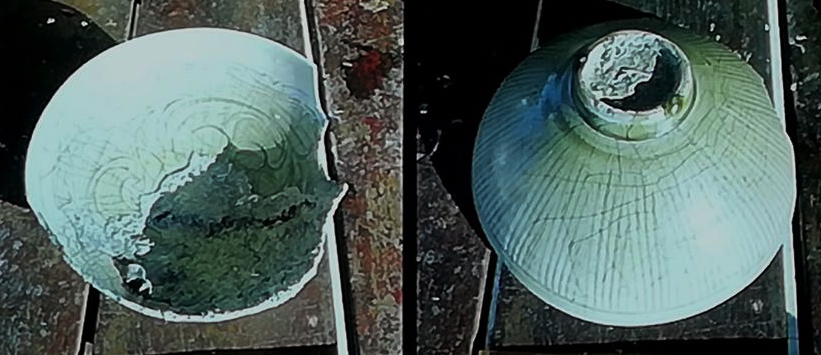 |
| Possibly from the Longquan Kiln |
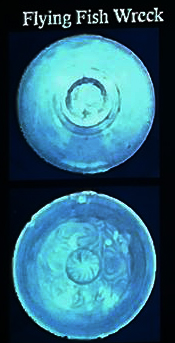 |
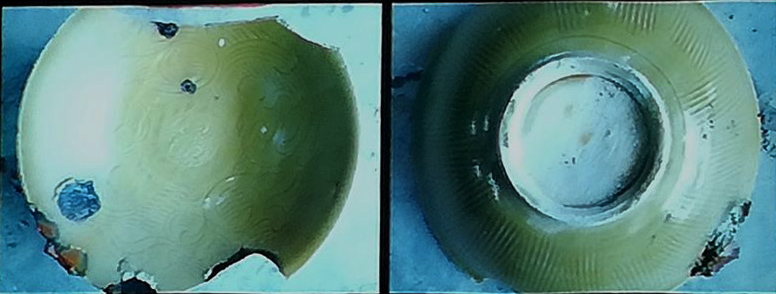 |
| Two Examples of uncertain origin |
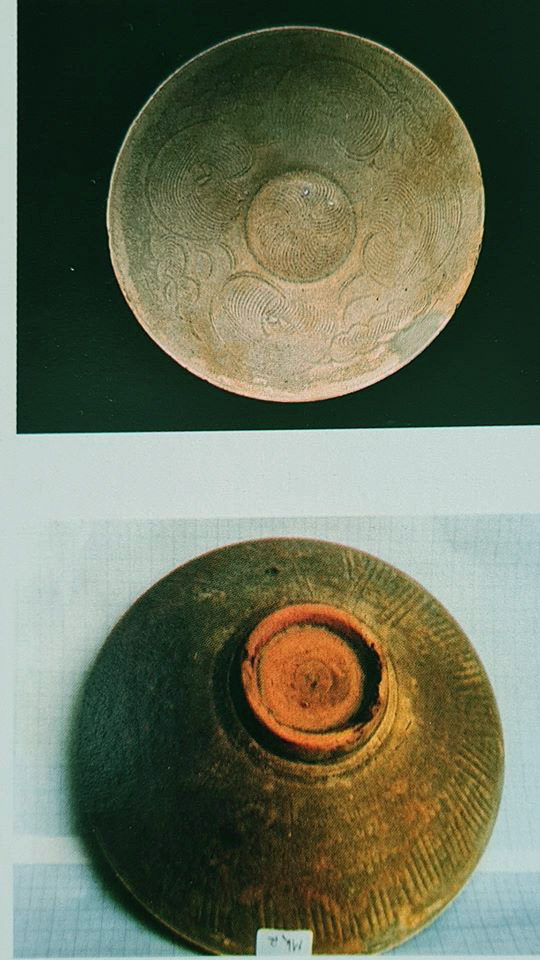 |
|
| An example of green glaze with carved/combed decoration from the Pulau Buaya wreck |
Example of carved/combed motif from Jepara wreck
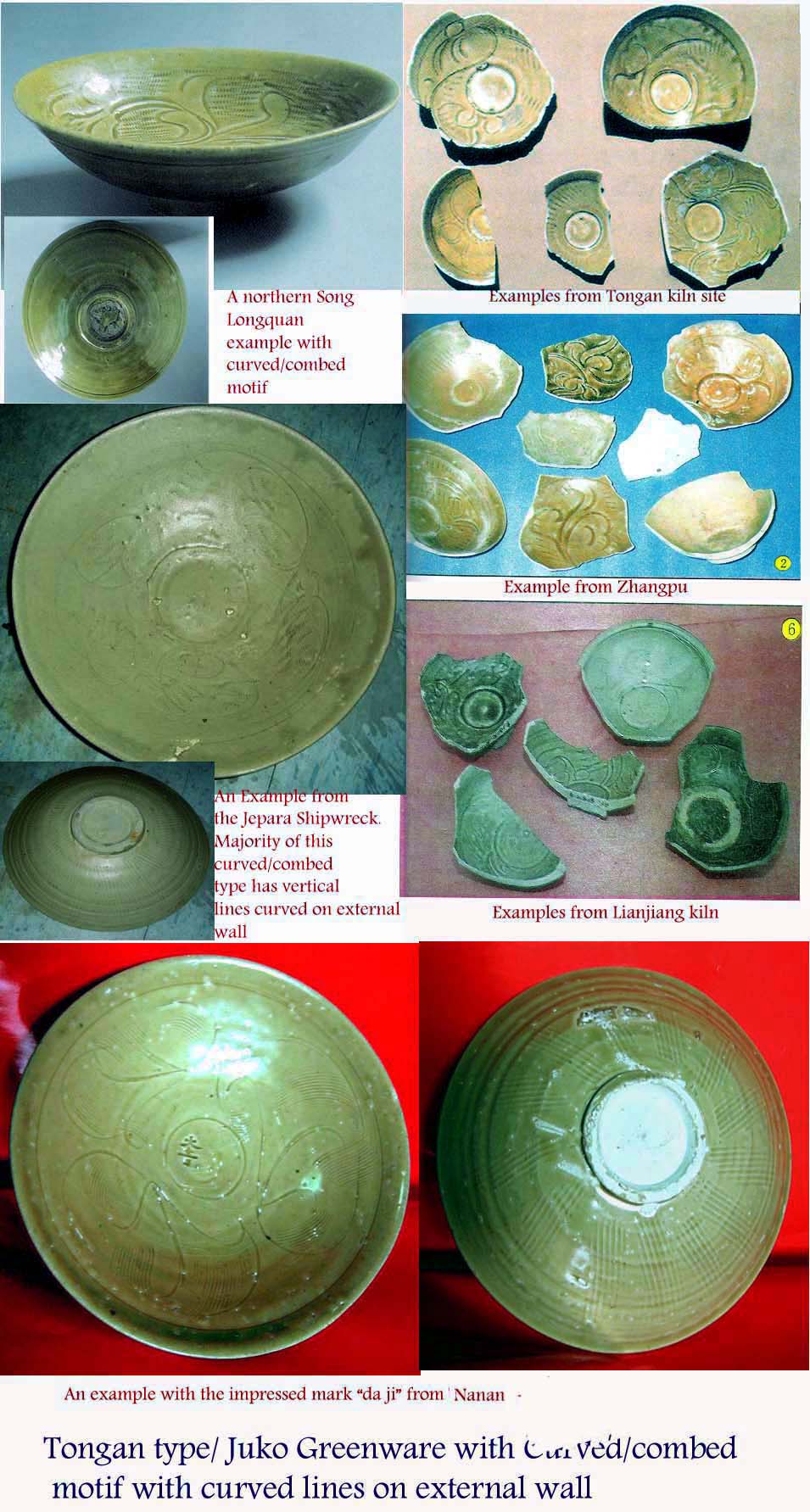
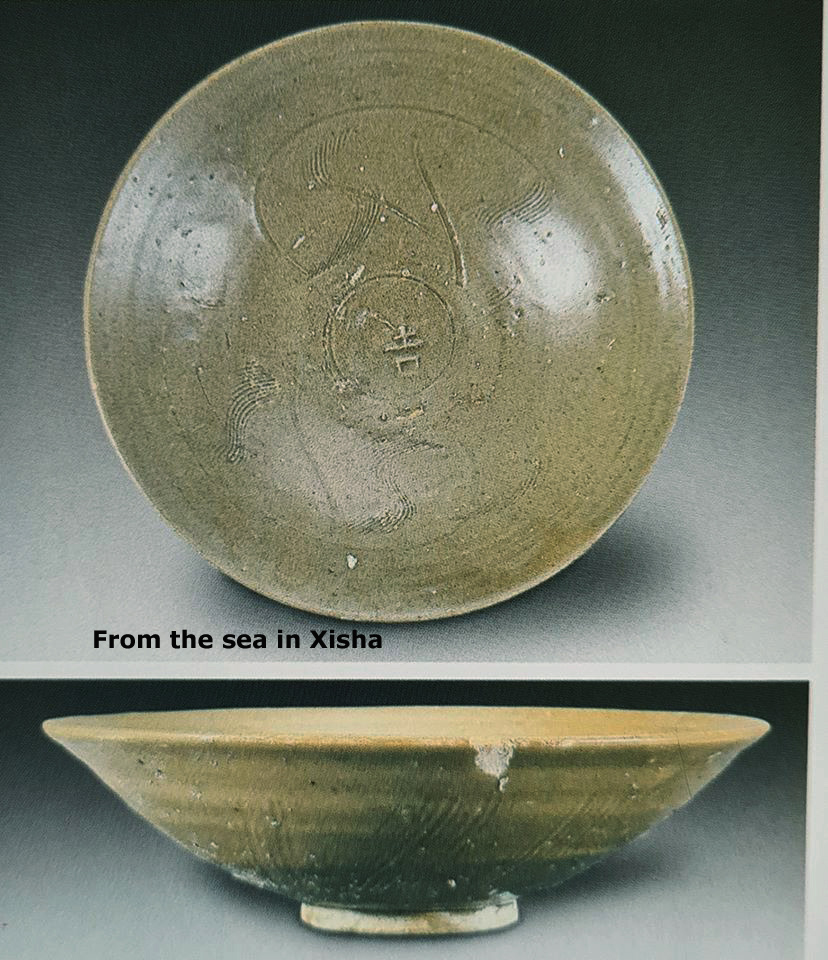
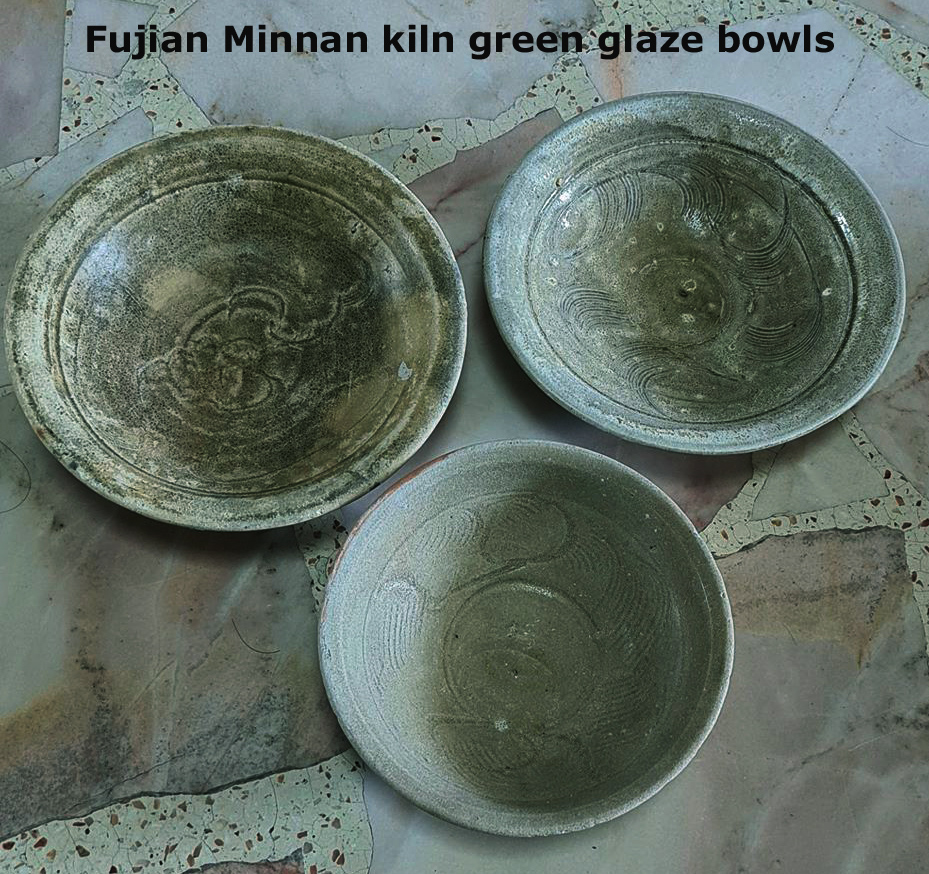
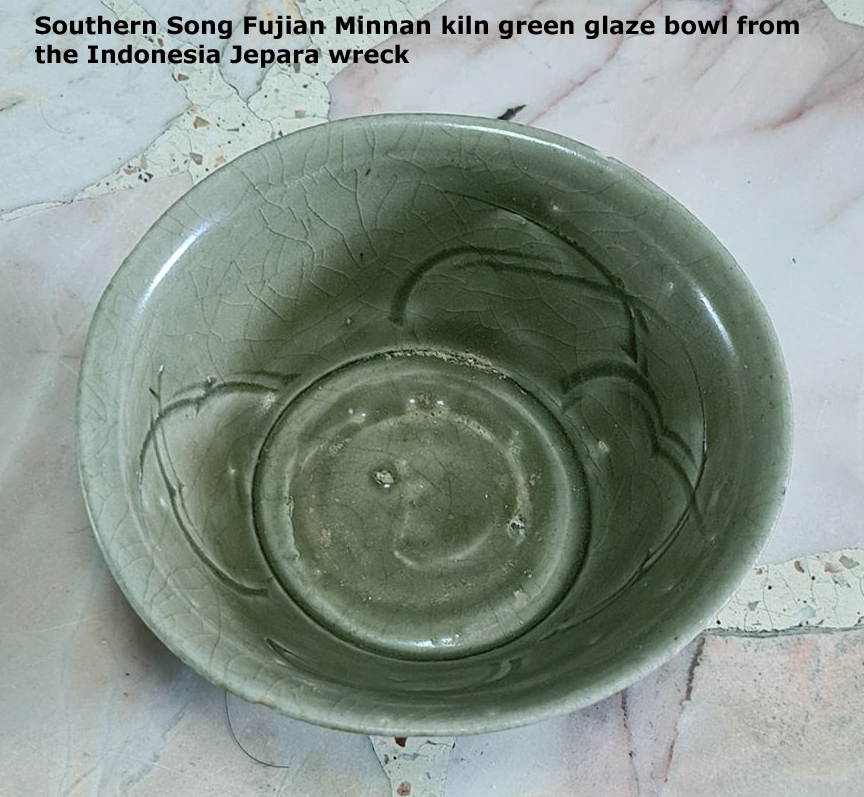
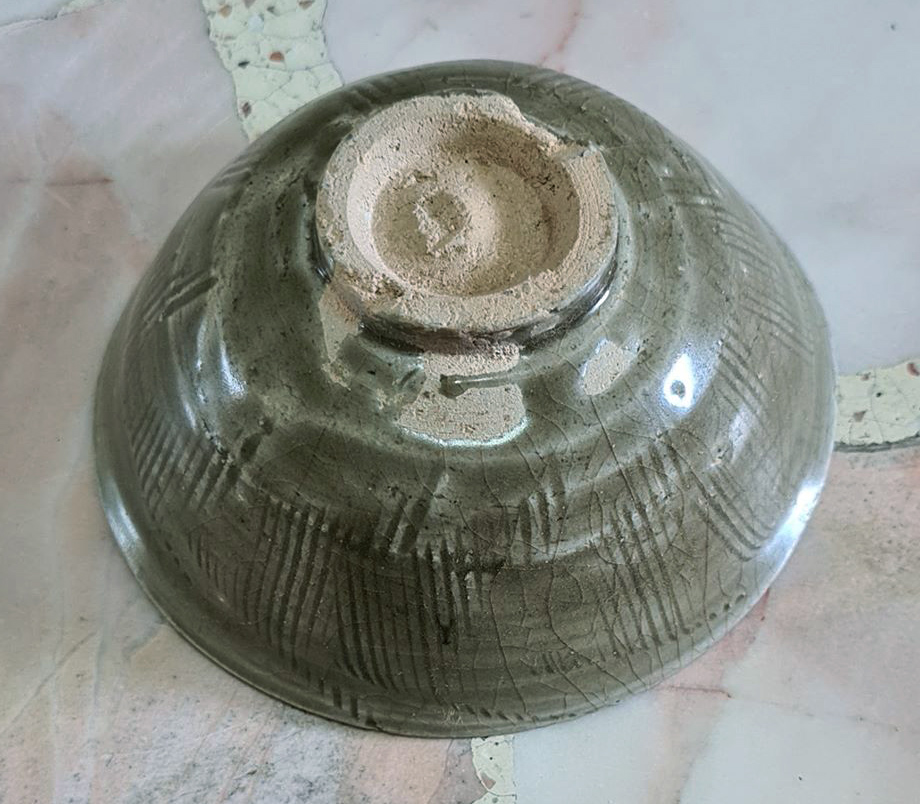
Longquan bowls with carved lotus was a popular motif that had a long product life cycle, which lasted from Northern Song to Yuan period. Longquan potters were the first to introduce them. This type was first introduced earliest by late Northern Song and gained immense popularity by the early Southern Song period. The Northern Song version has typical carved vertical striations on external wall. Although a small number still have this decorative feature during early Southern Song, subsequently it was abandoned and external wall of the bowl left undecorated. Due to poor control of kiln atmosphere, green glaze bowls from the Minnan kilns displayed a wide range of colour tone, light bluish green, grayish green to yellowish green.
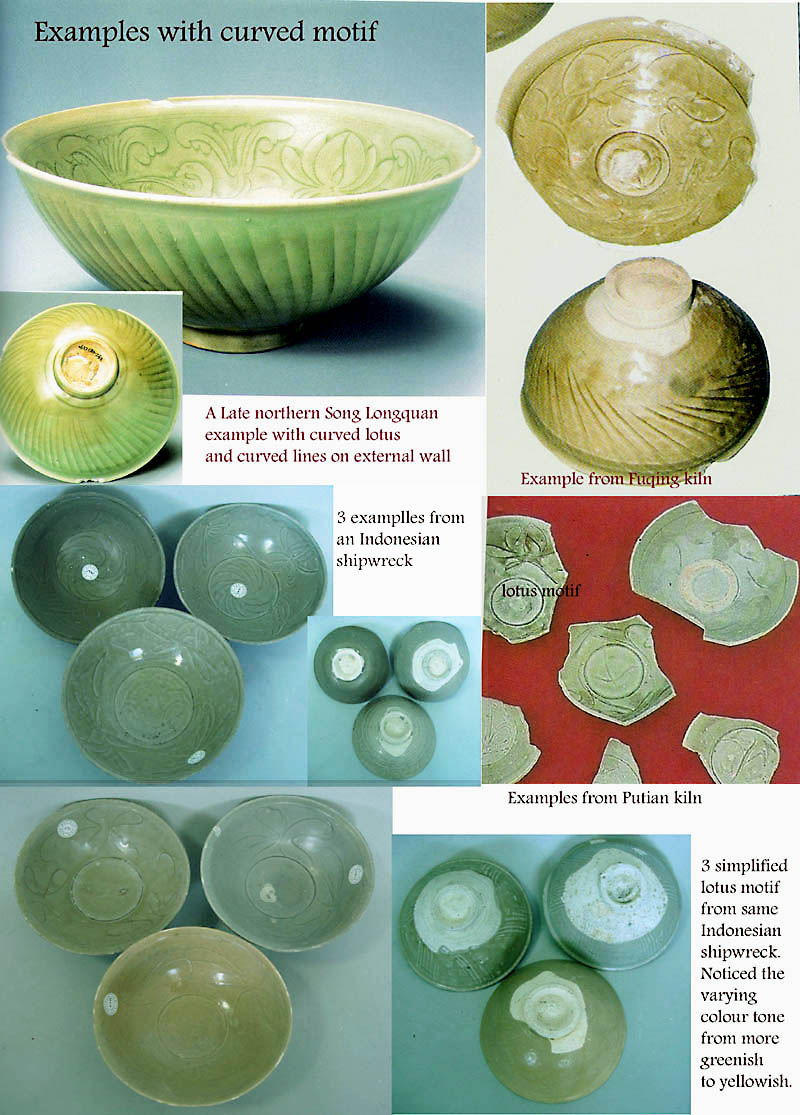
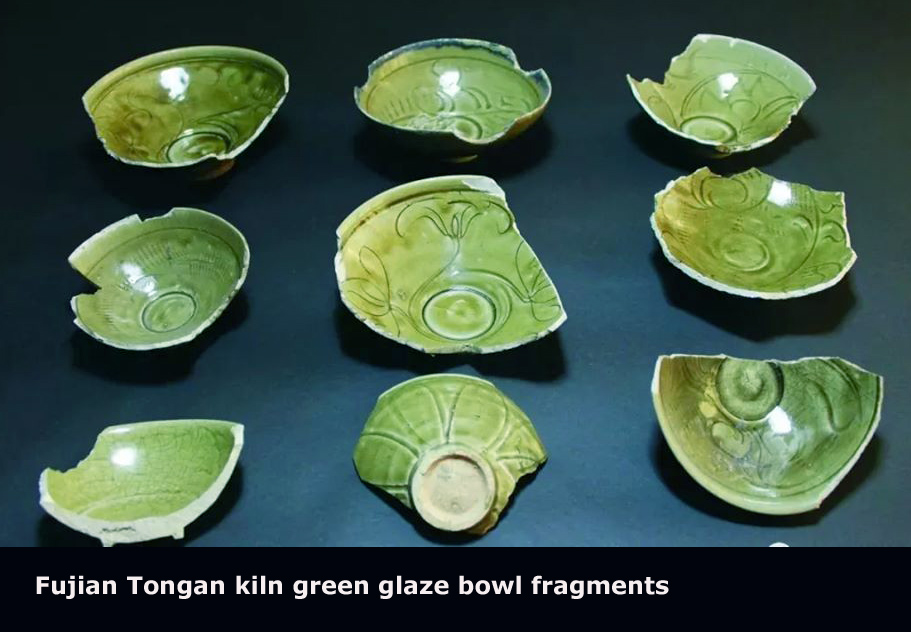
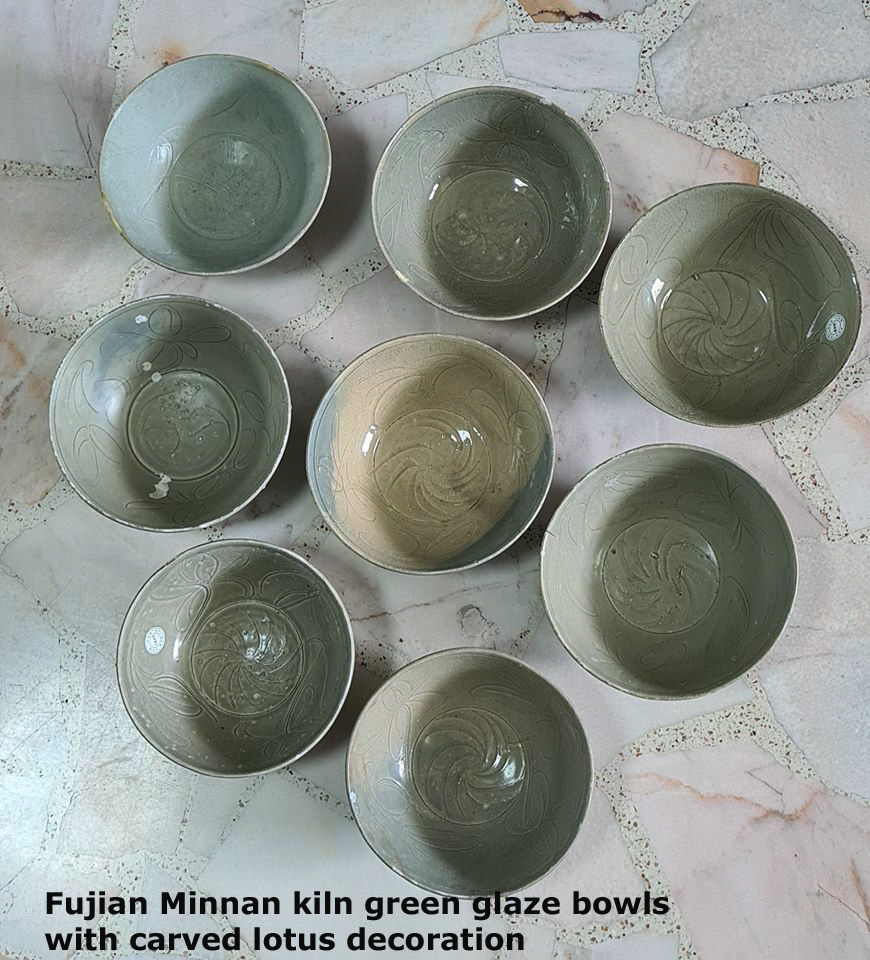
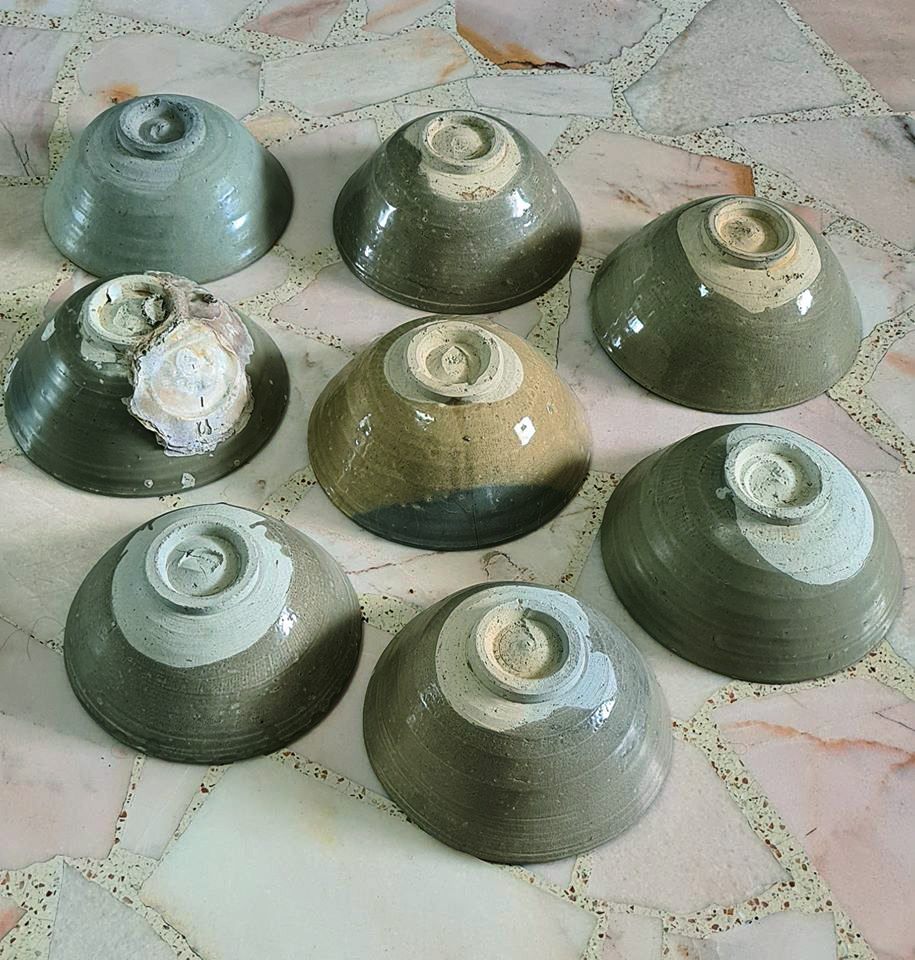
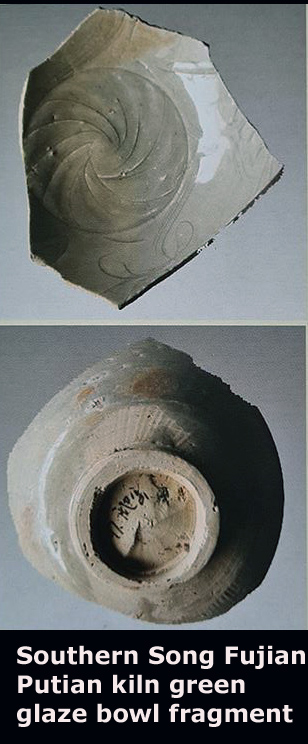
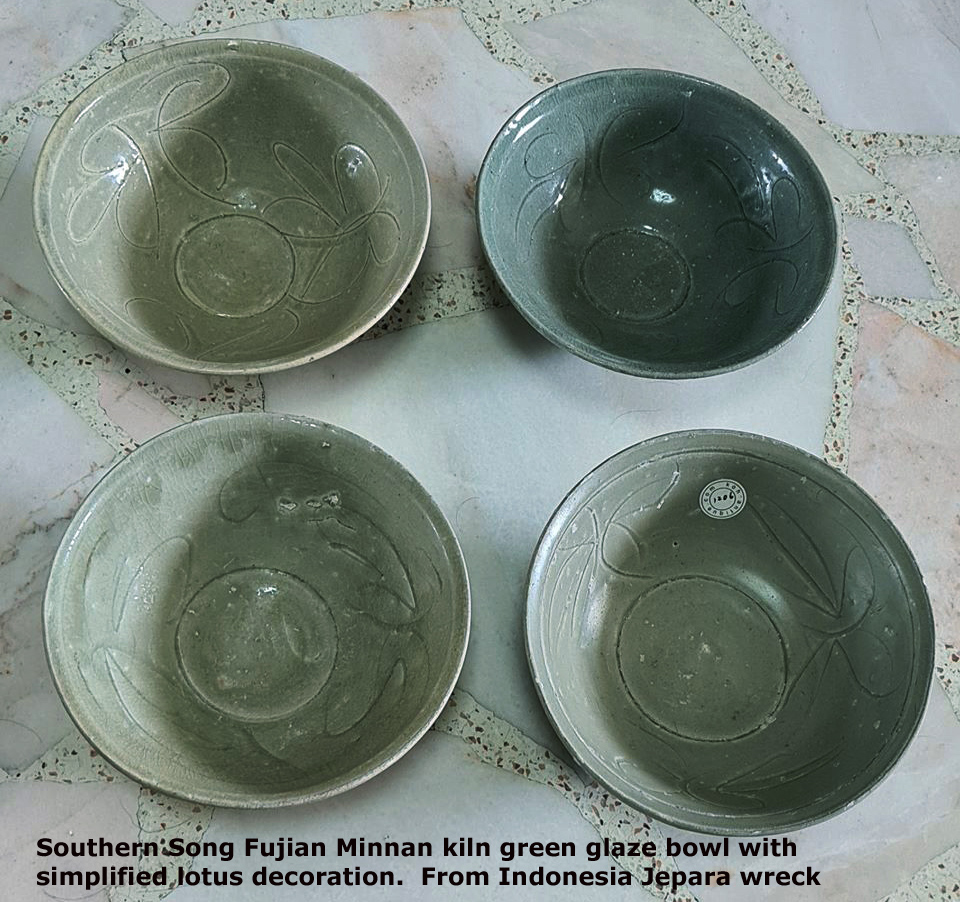
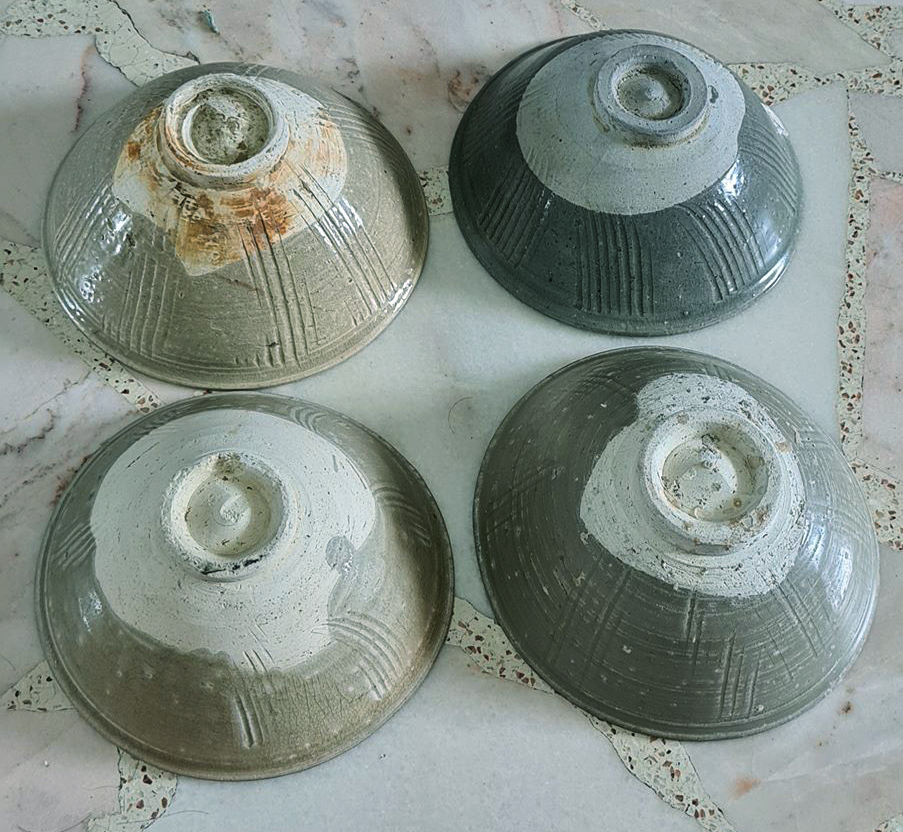
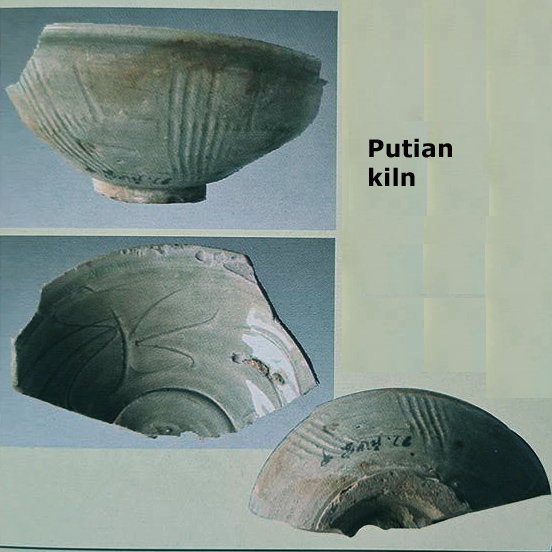
| Many of the Jepara wreck bowls with carved lotus decoration could be from the Putian kiln. The foot is usually more crudely cut as compared with those from other Minnan kiln. |
Another popular category of green glaze bowls were those decorated with carved abstract cloud motif. Minnan Lianjiang Pukou kiln has been identified as the most important production site. Those from the Jepara wreck displayed distinct common features if compared to the samples from this kiln.
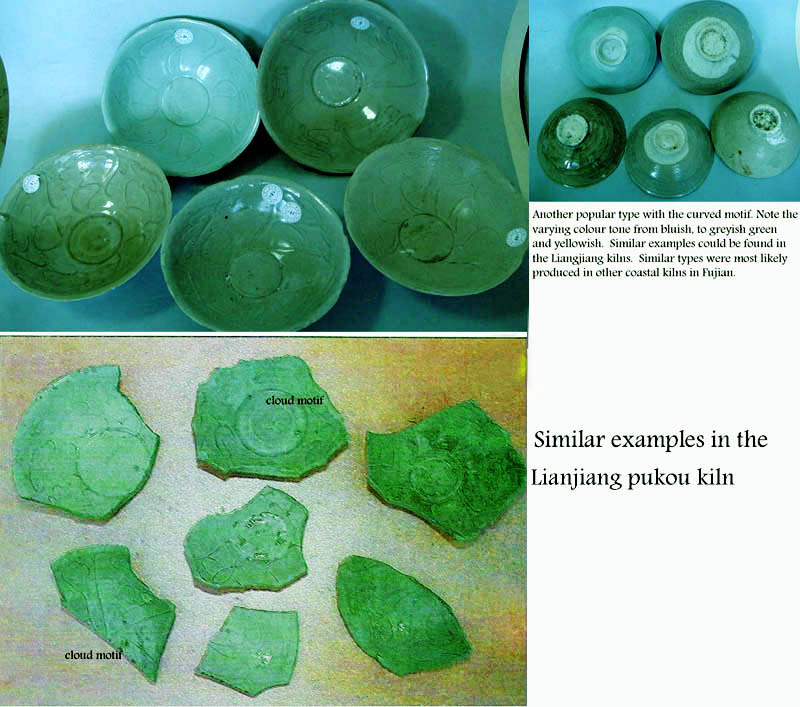
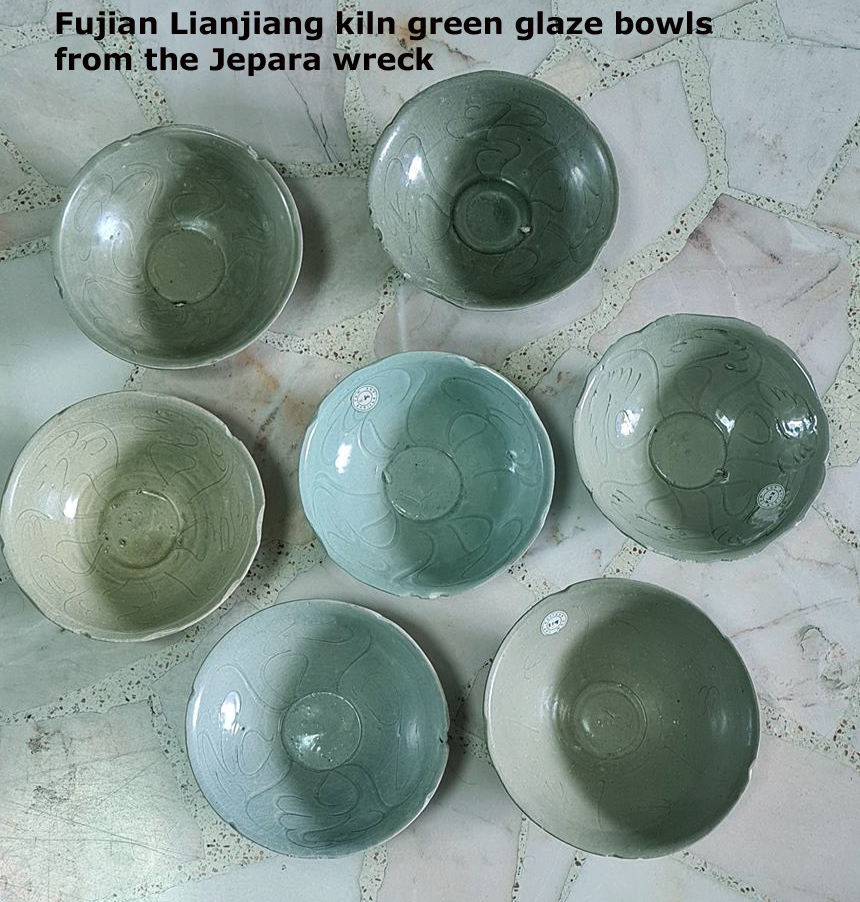
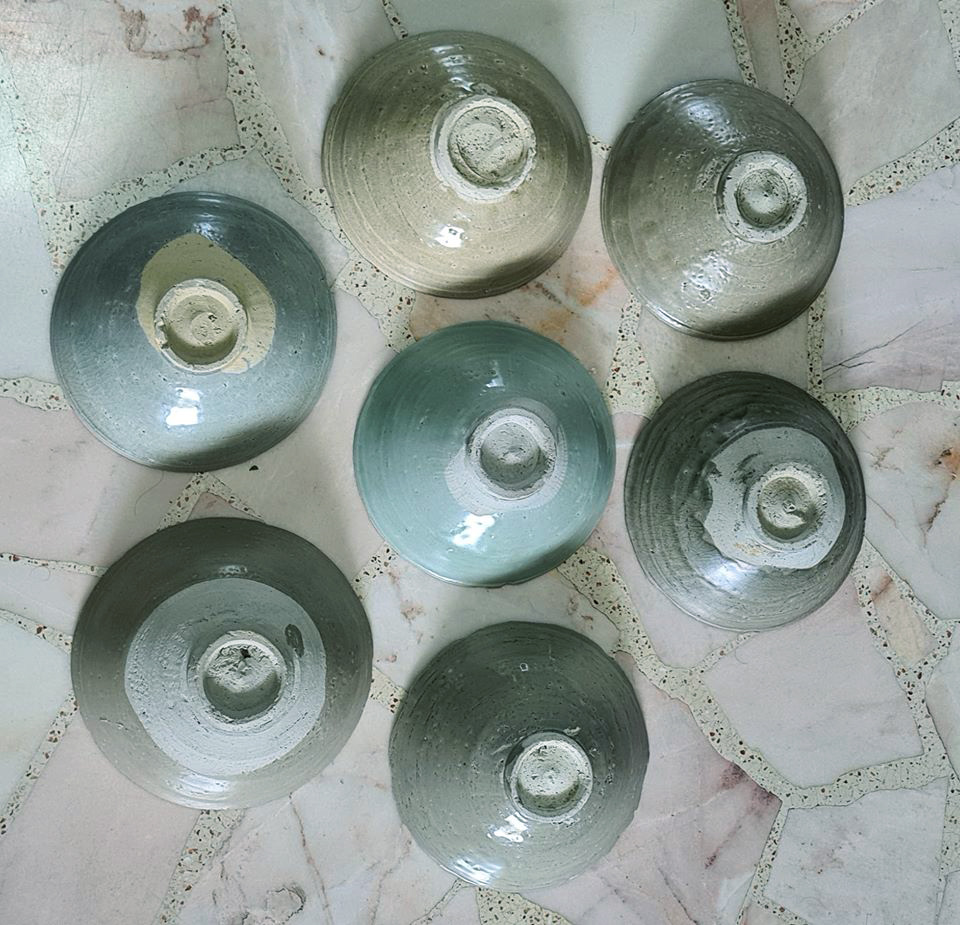
Besides bowls which constituted the bulk of the export, other green glaze vessels exported included ewers, jars,cover boxes and etc.
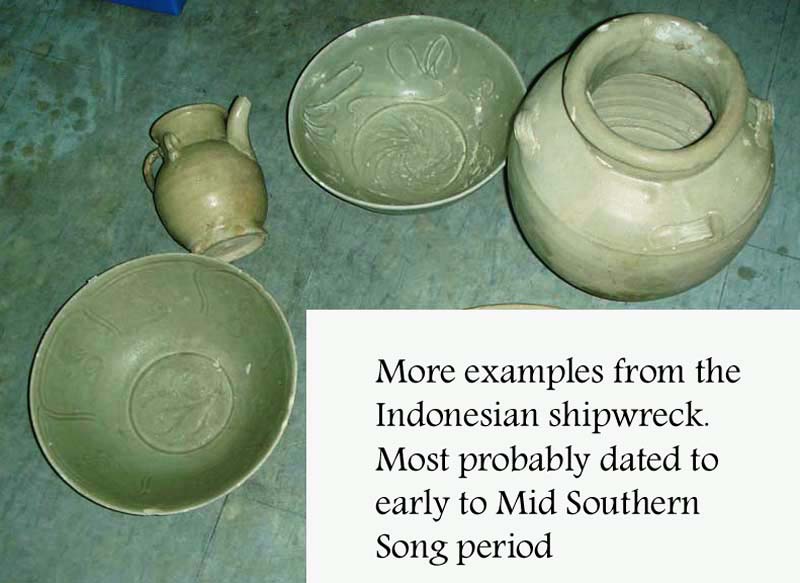
Jepara wreck celadon, top 3 from Fujian kiln and bottom left from Longquan
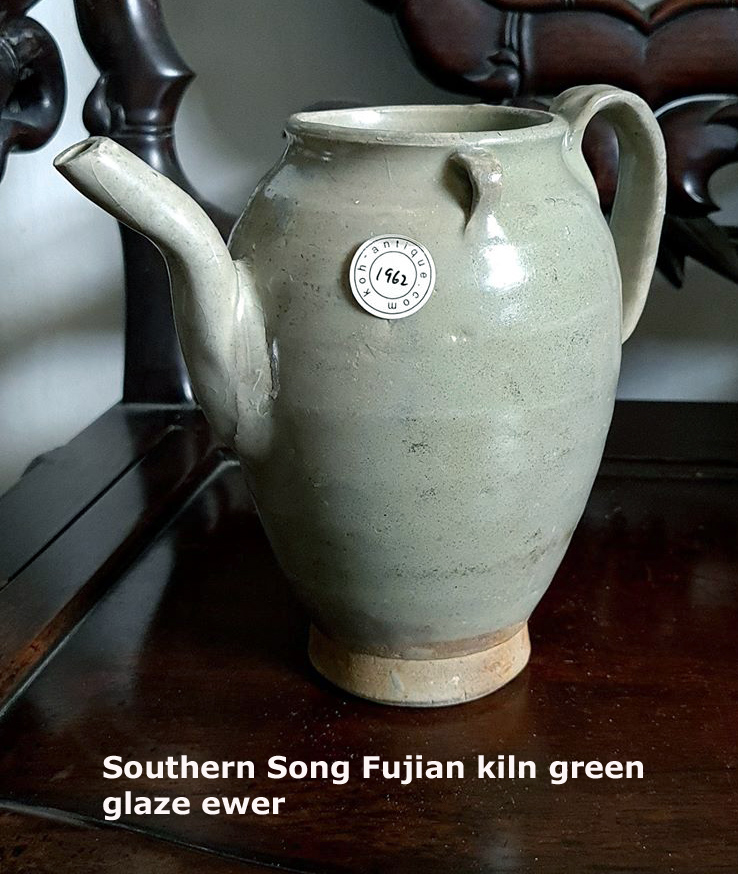
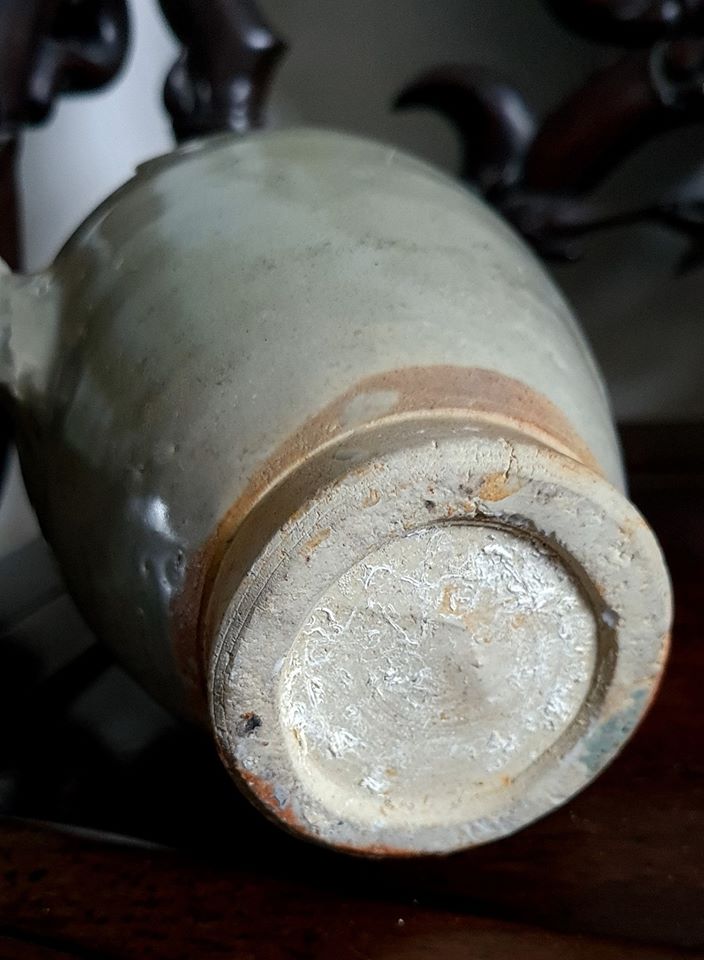
White/Qingbai ware
|
|
|
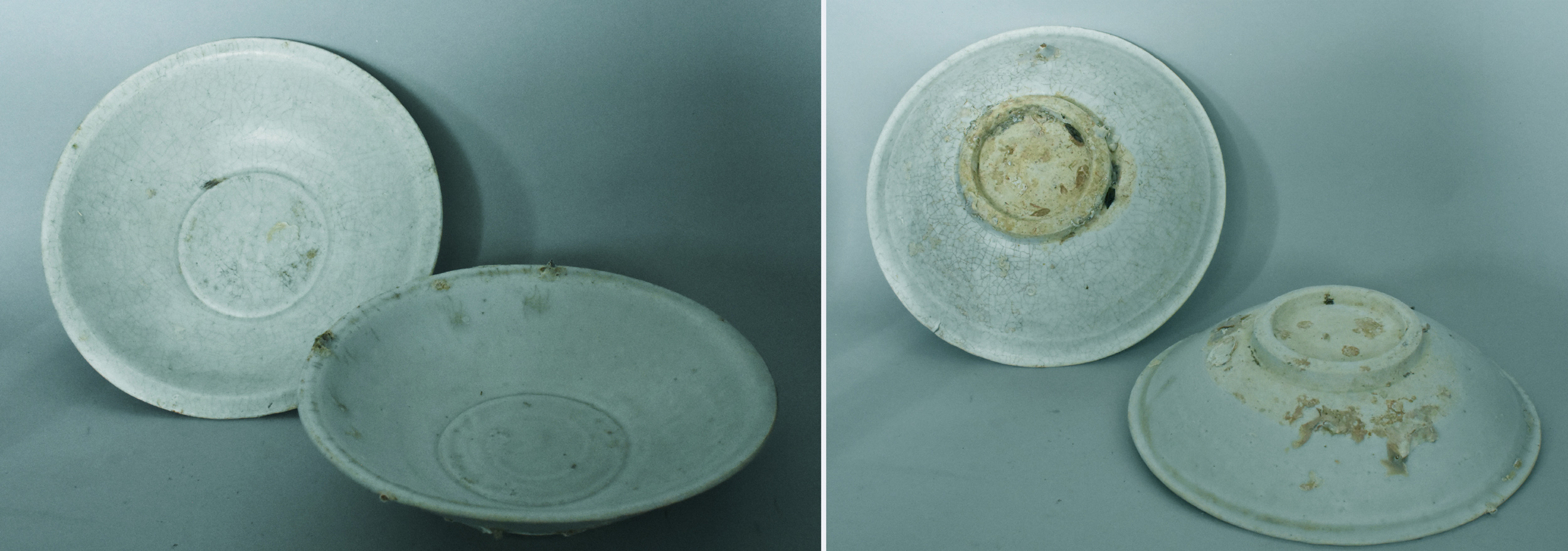 |
|
| White bowls from the Lingga wreck which are likely from Fujian Nanan kiln | |
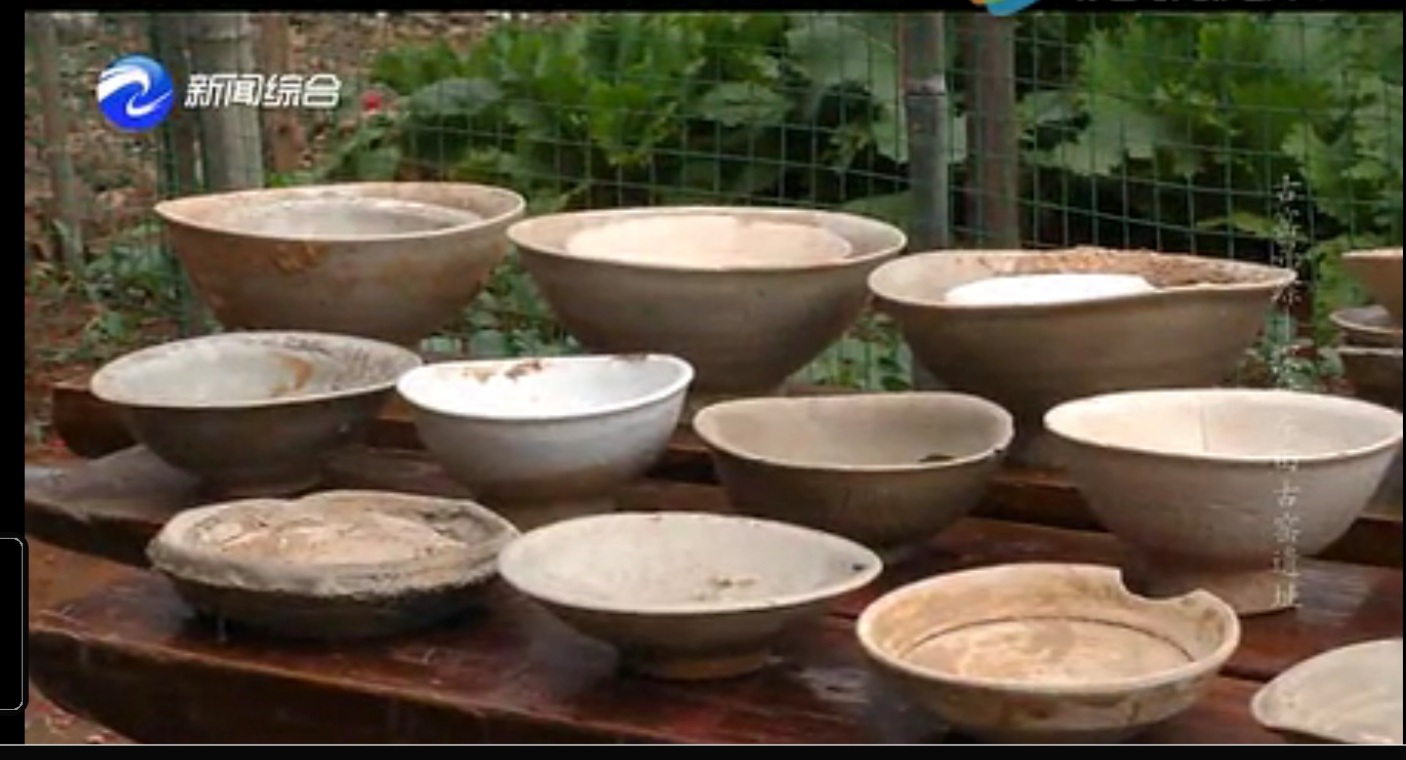 |
|
| Examples recovered from Nanan kiln | |
Nanan kilns also produced a range of cover boxes and small vases with ribbed neck. Without careful examination, they may be mistaken as from Chaozhou Bijiashan kiln.
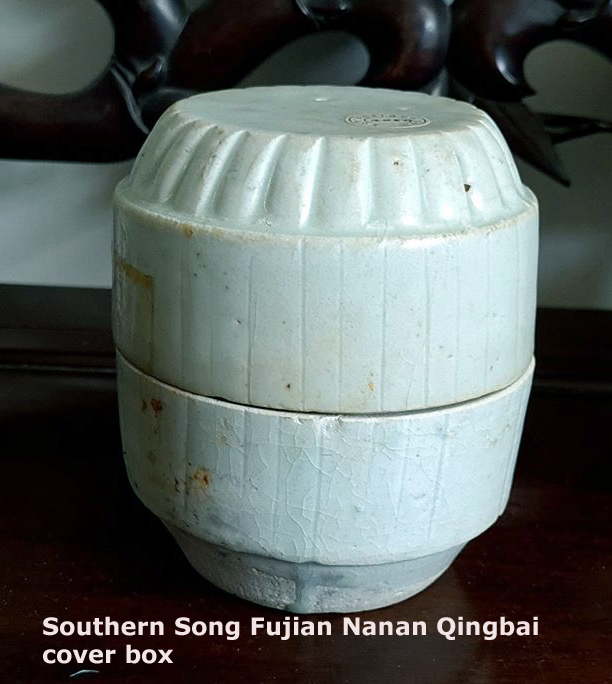 |
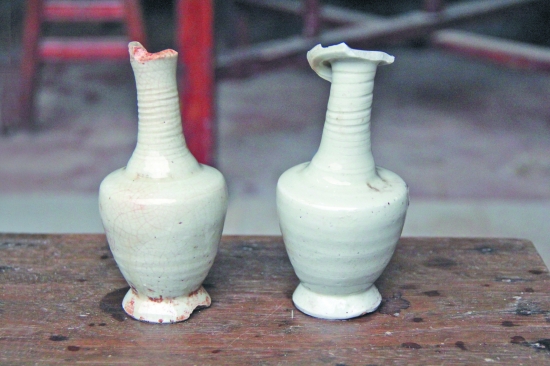 |
| Examples of Northern Song Nanan small vases with ribbed neck. |
A substantial amount of qingbai/white wares from the Pulau Buaya wreck are also likely products of Fujian Zhangpu or Zhangping kilns. For more details, please read this article.
Based on findings from shipwreck ceramic cargoes, Dehua kilns probably contributed the largest export of Qingbai/white wares during the Song/Yuan period. The oldest Dehua kiln at Wanpinglun (盖德碗坪崙)possibly dated to the late Northern Song period. Those kilns at Qudougong (屈斗宫)started production during the late Southern Song period. The most common export Dehua products were dishes ,boxes, vases and kendis. Two wrecks are useful reference for studying the range of Dehua products are the Jepara and Nanhai 1 shipwreck. The Jepara wreck (1150 - 1175 A.D), is likely dated a couple of decades earlier than the Nanhai 1 wreck ( 1175-1200 A.D).
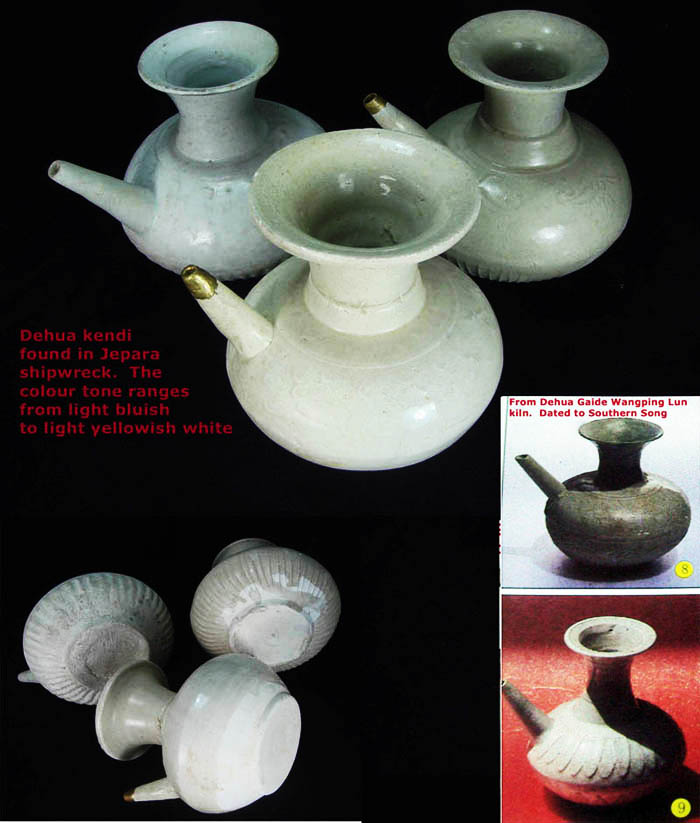
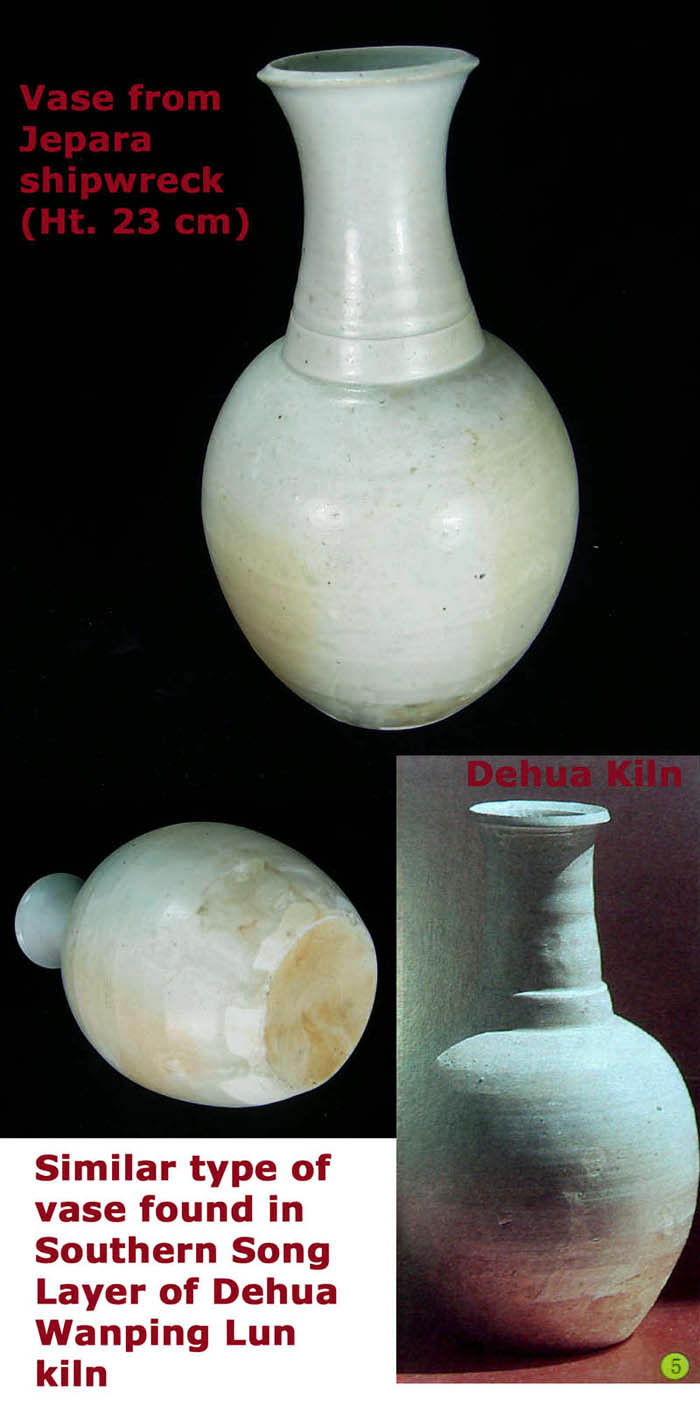
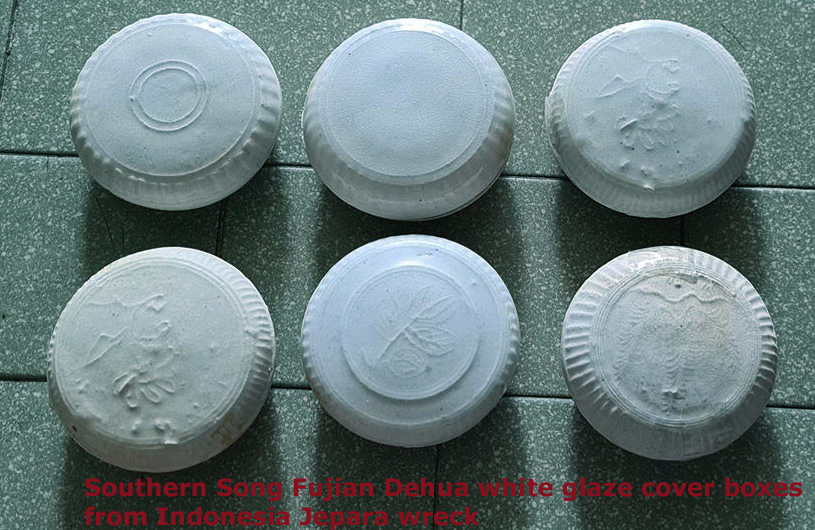
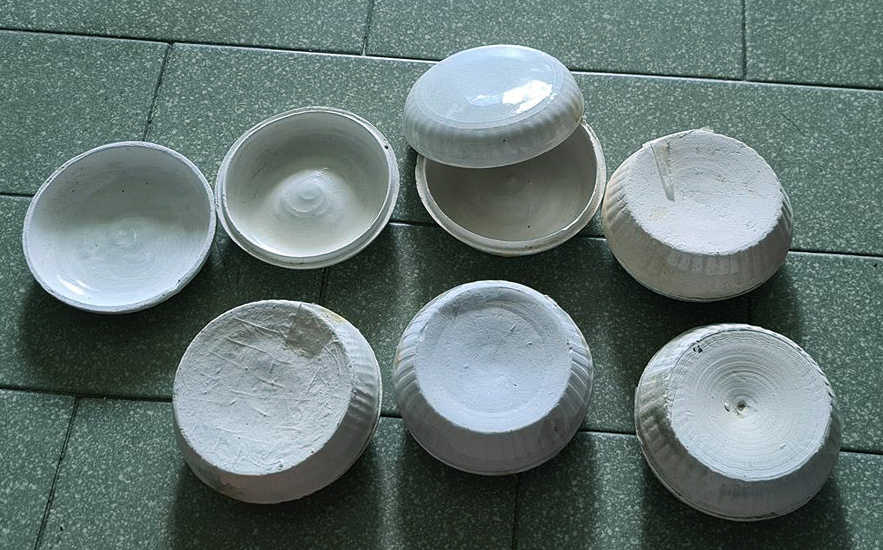
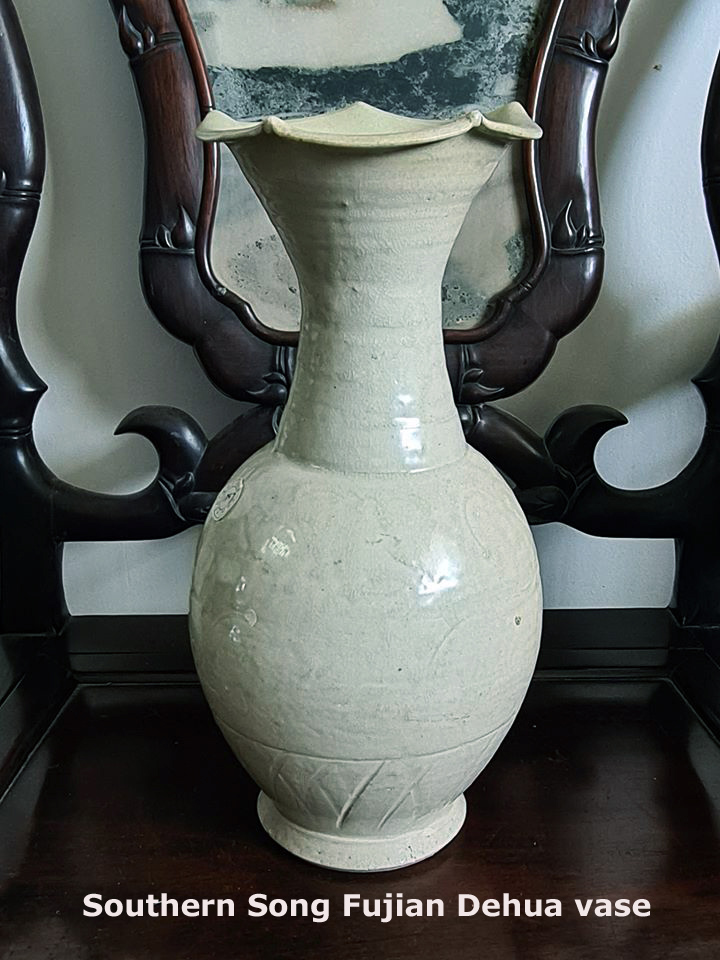
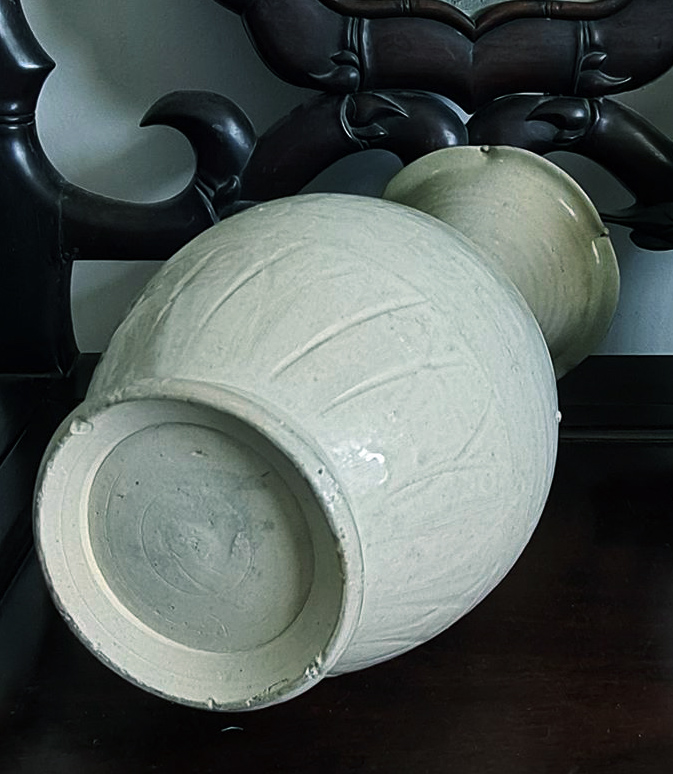
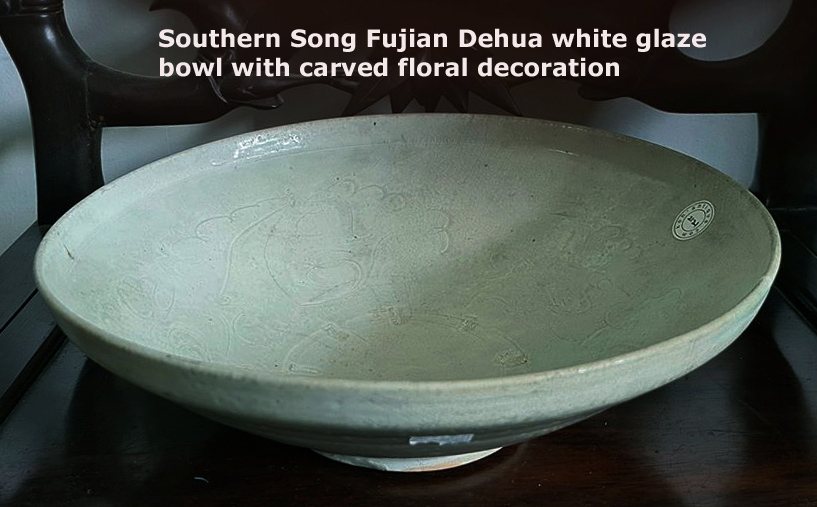
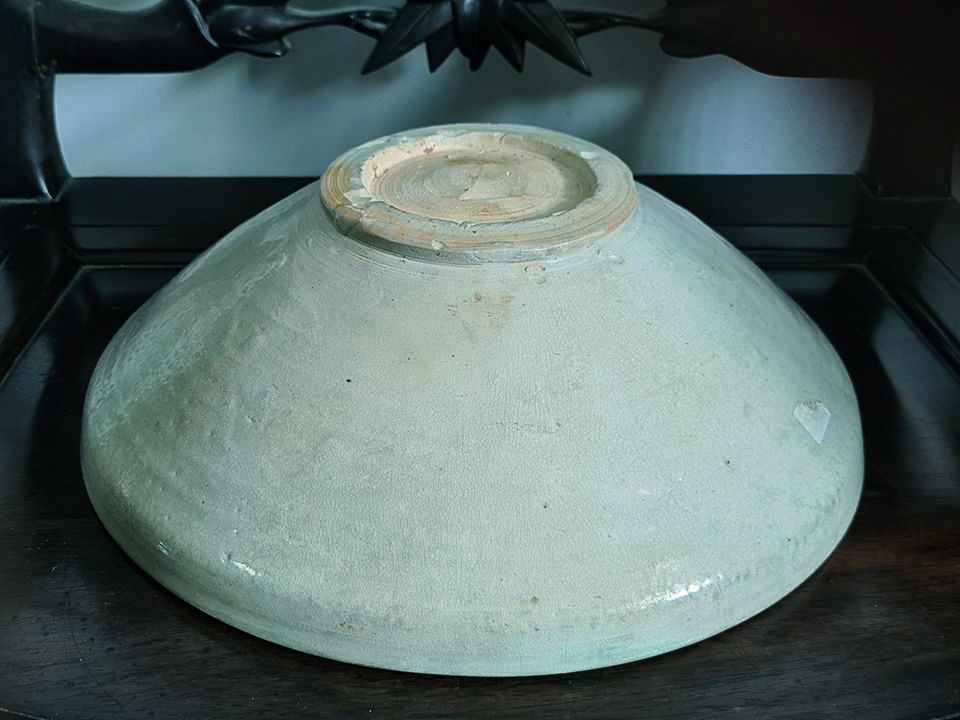
Compared to the Jepara wreck, the Dehua wares in the Nanhai wreck generally have better fired and more tightly fused glaze. There are also more variety of cover boxes, especially those with hexagonal shape which were not found in the Jepara wreck. There ware also interesting range of small jarlets and small vases with impressed decoration.
Dehua Qingbai/white wares from Nanhai 1 shipwreck
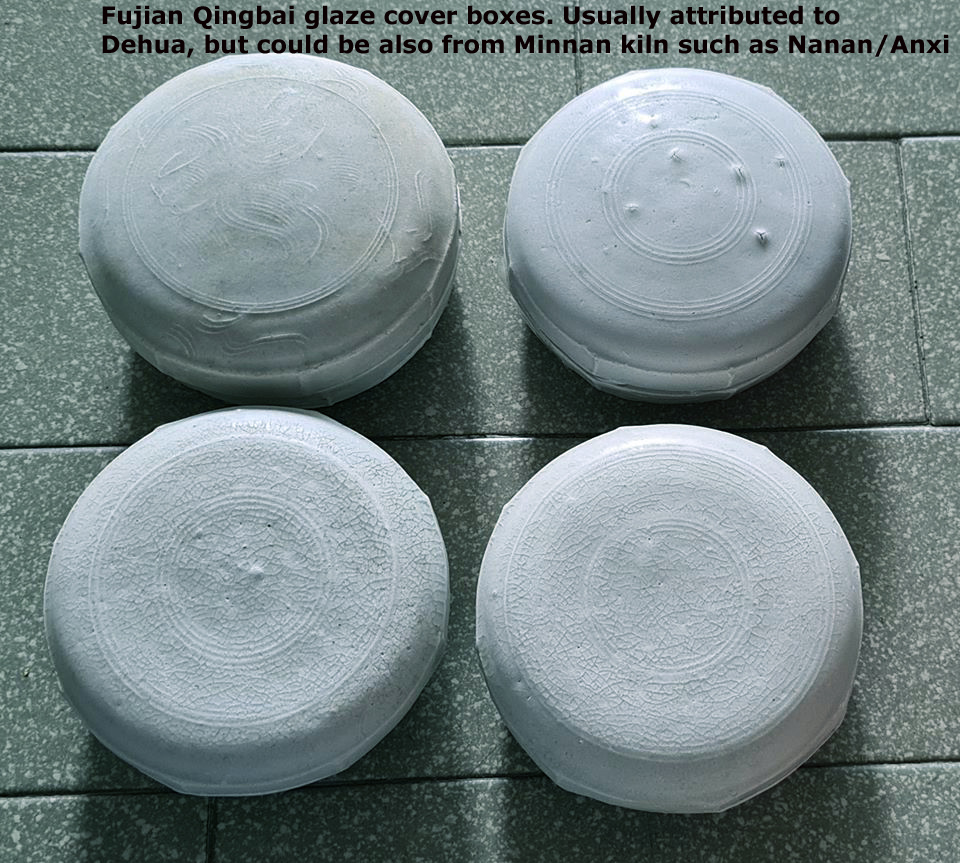
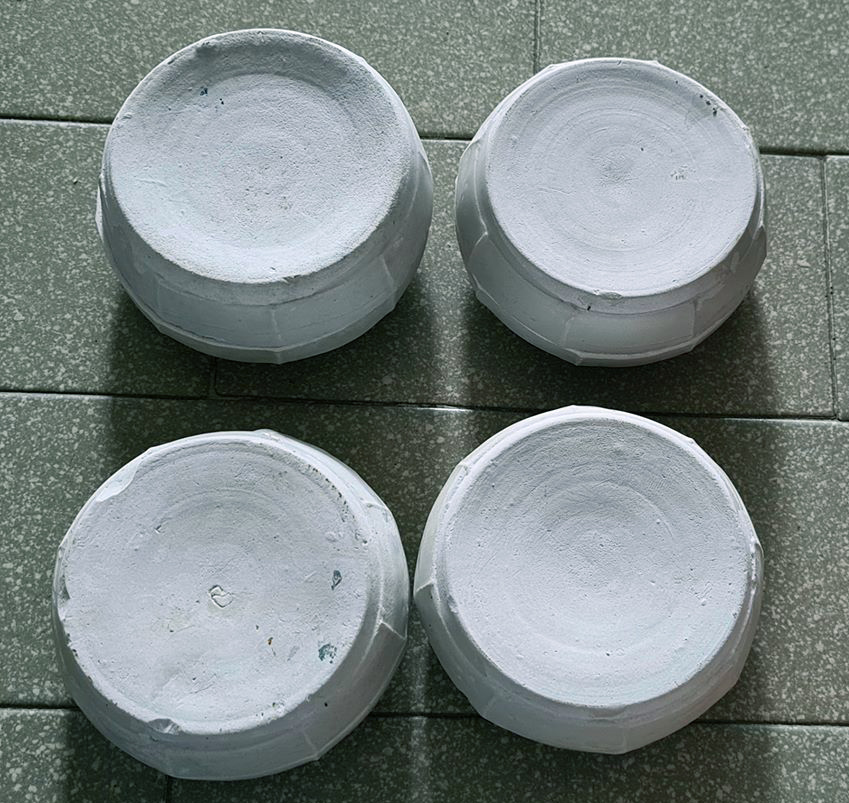
| Some Qingbai cover boxes from an unknown Indonesia wreck. They are similar to that found i the Nanhai 1 and Java Sea wreck |
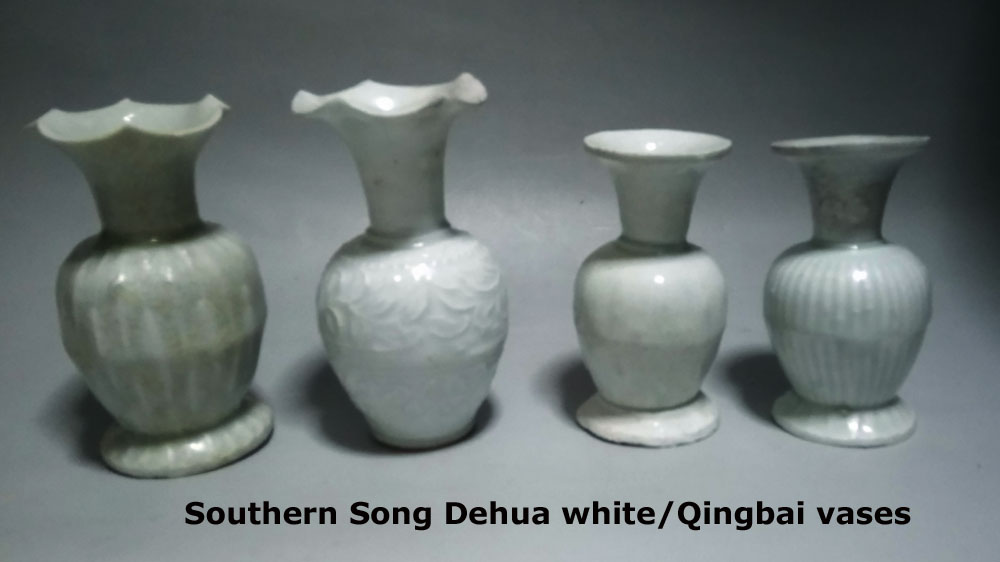
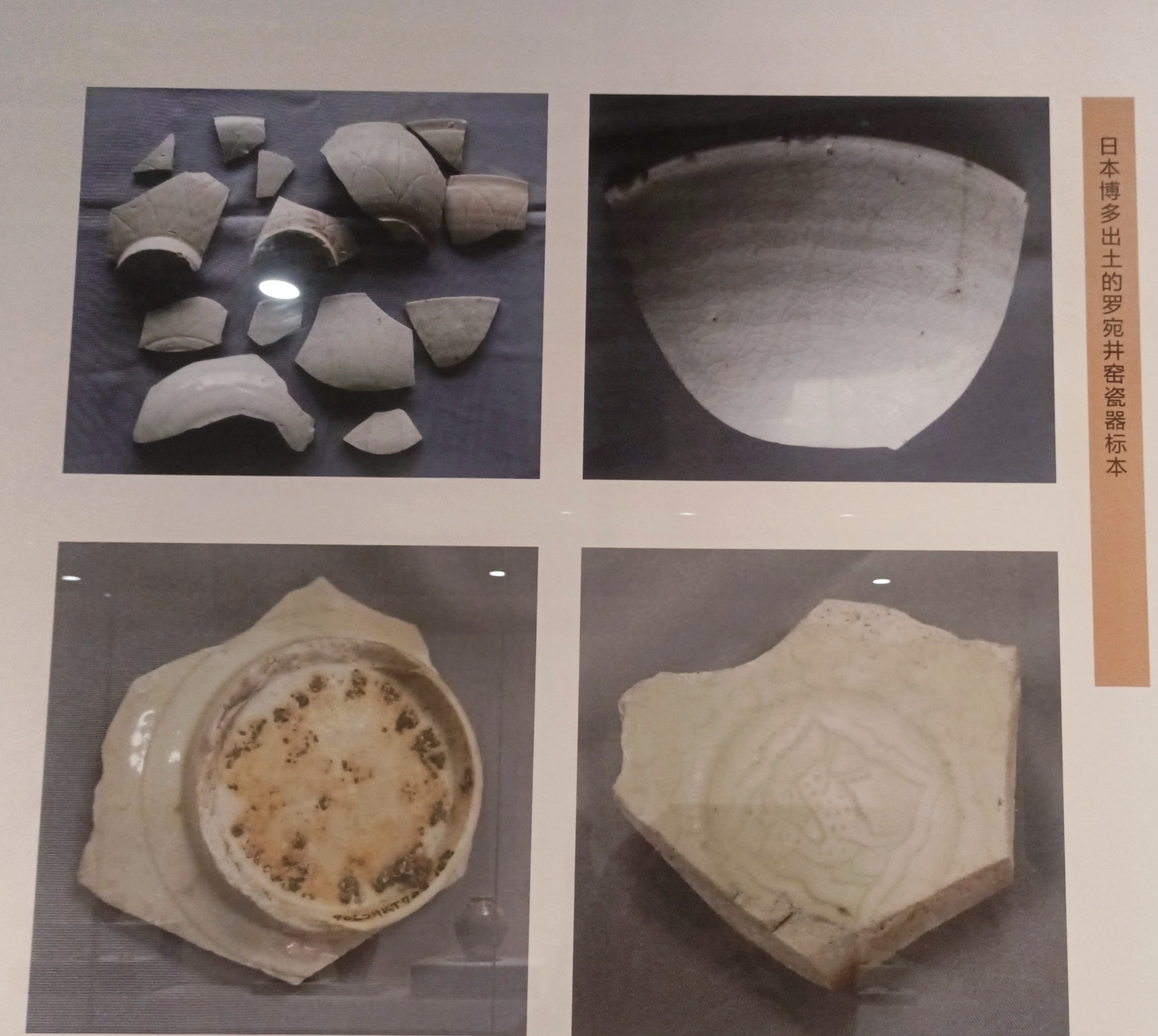 |
| Fujian Zhangpu kiln qingbai wares found in Japan |
 |
| Fujian Zhangpu kiln qingbai example found in Eygpt Fustat |
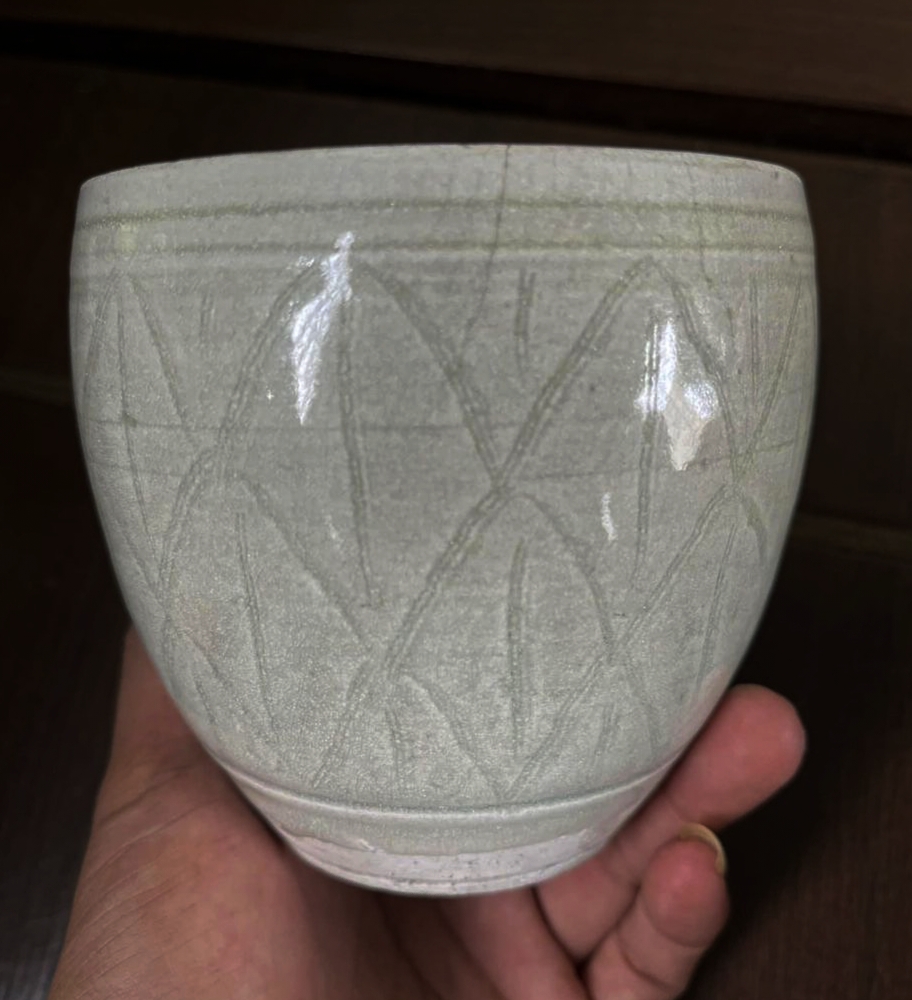 |
 |
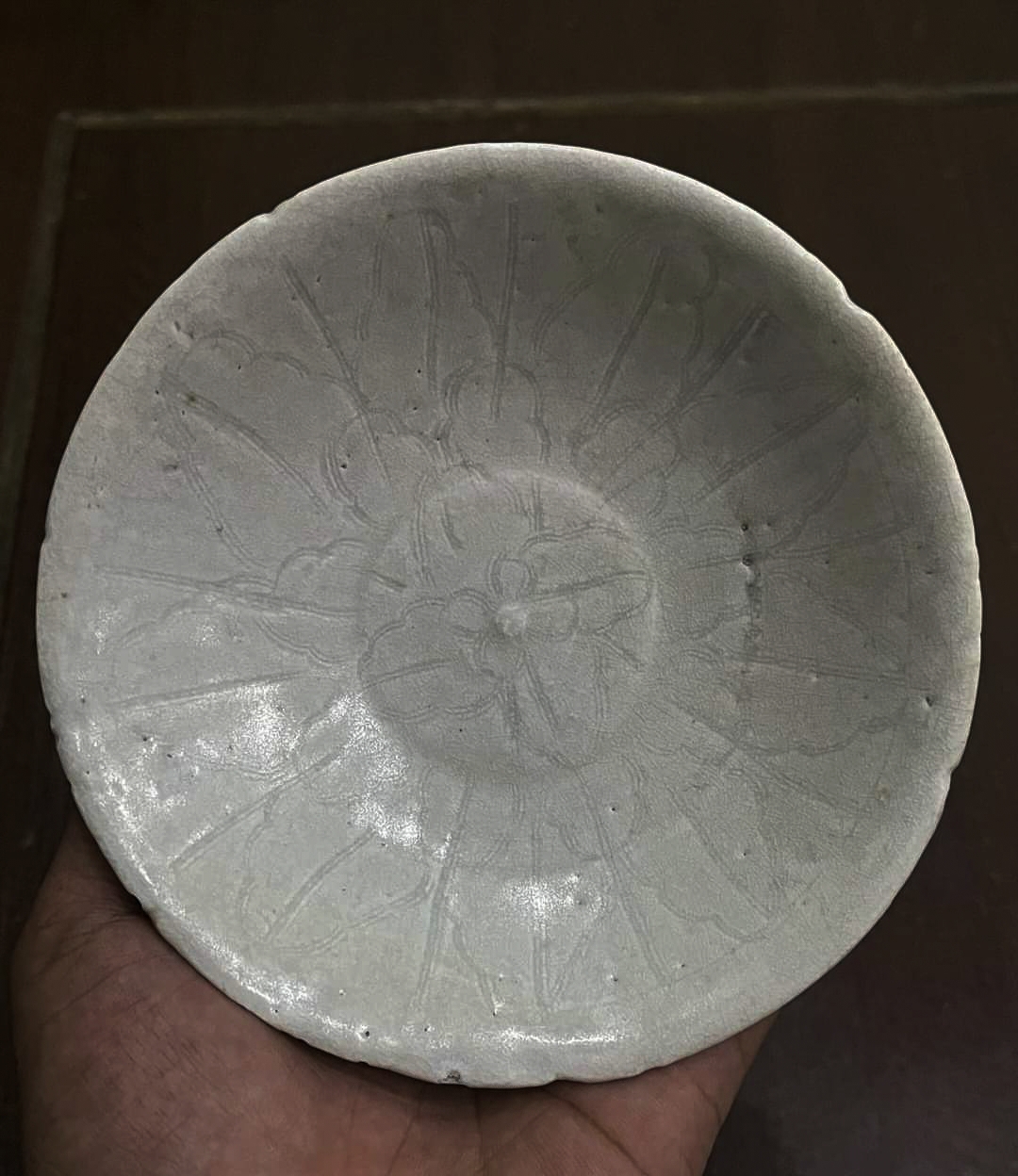 |
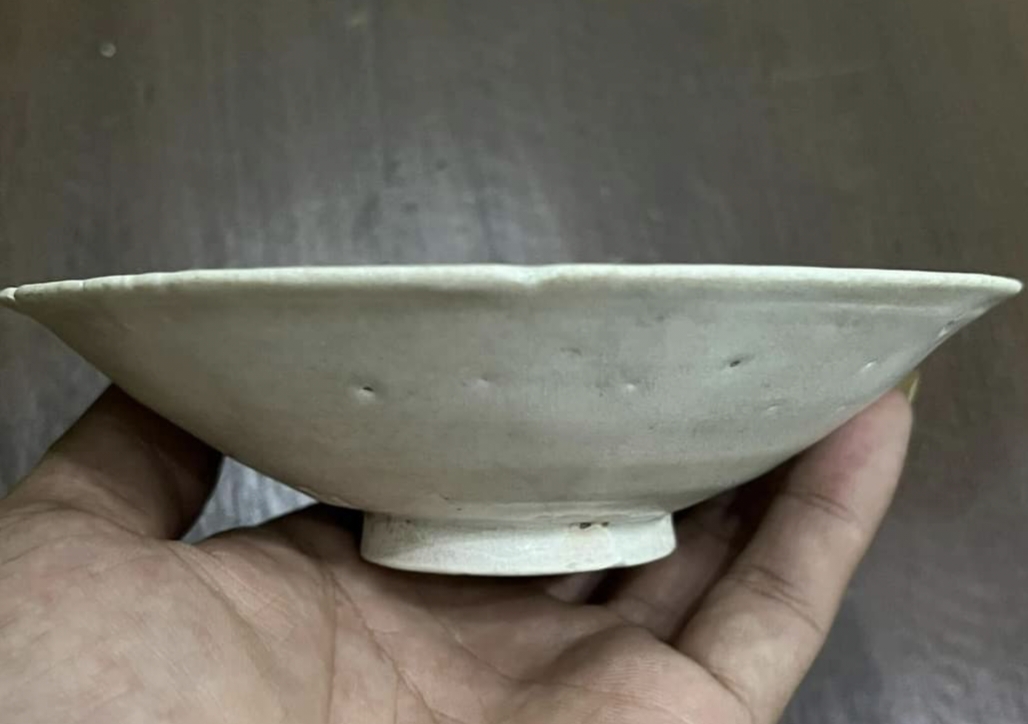 |
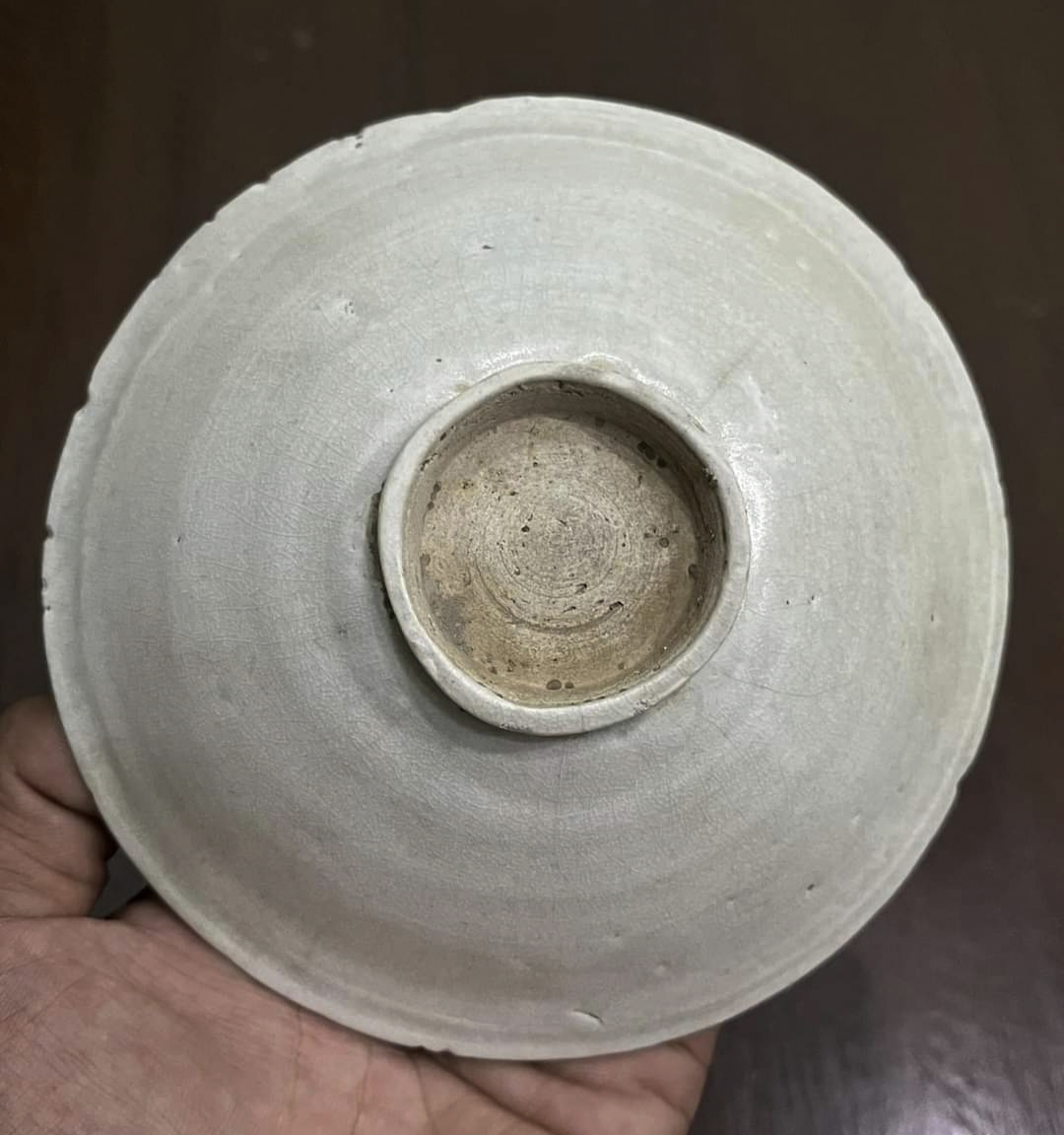 |
| Northern Song Fujian Zhangpu kiln qingbai examples found in Sumatra Jambi |
Among the Fujian Qingbai , there is an interesting group of thinly potted bowls with more elaborate carved/combed floral or waves motif. They usually have a straw colour or grayish white glaze and characterised by pooling of glaze near the inner and outer rim and sometime even the inner and outer wall. Personally, I think the glaze is intended to imitate the ivory Ding glaze with the typical pooling of teardrop-like glaze effect. Minqing Yi kiln (闽清义窑) has been identified as the major kilns that produced such bowls. Substantial quantity were recovered from the Nanhai 1, Indonesian Java wreck and Philippines Breaker Shoal wreck.
Mingqing Yi kiln greyish straw colour bowl with carved motif from the Nanhai 1 wreck
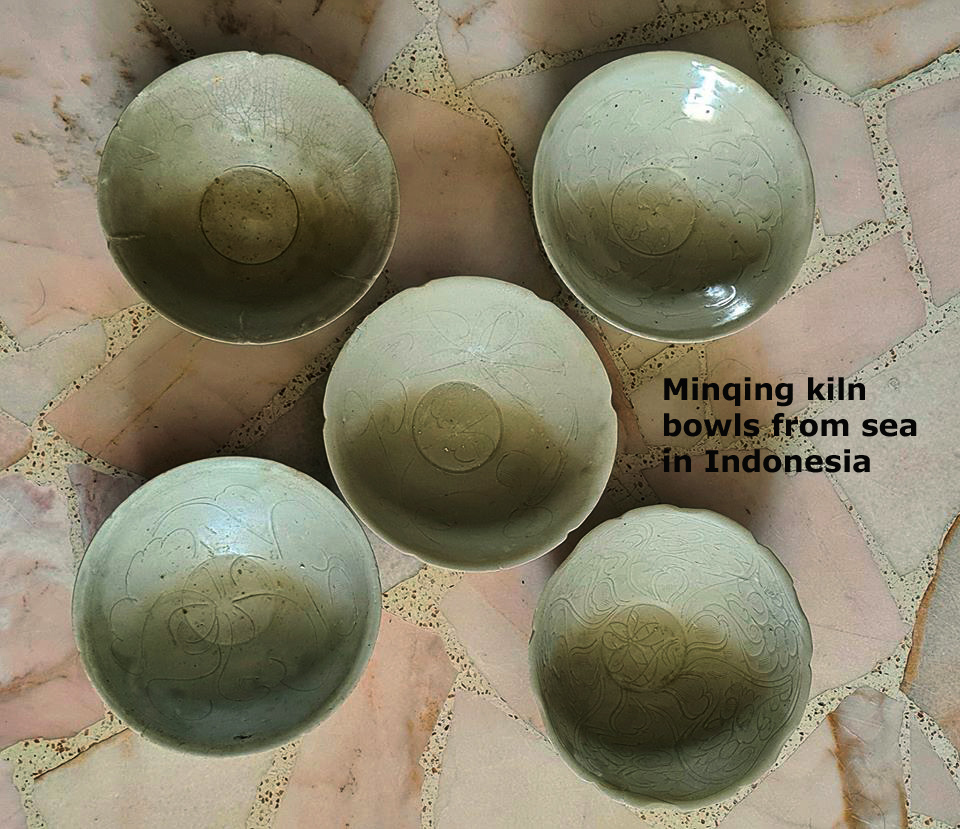
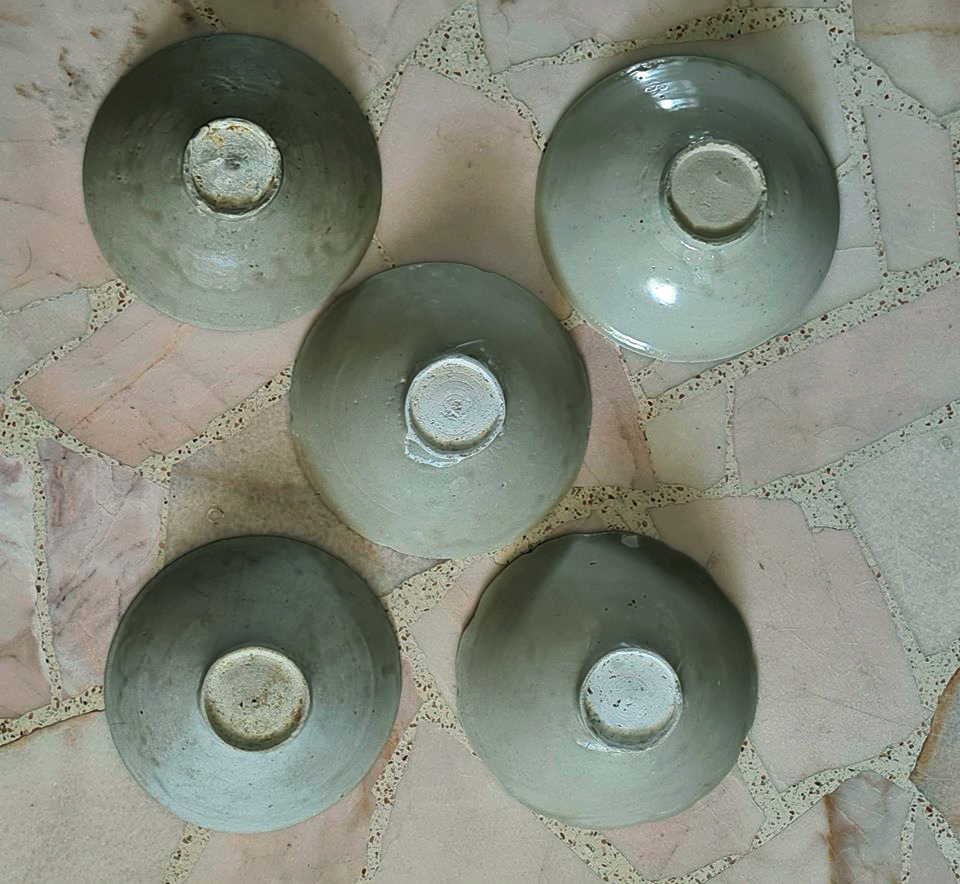
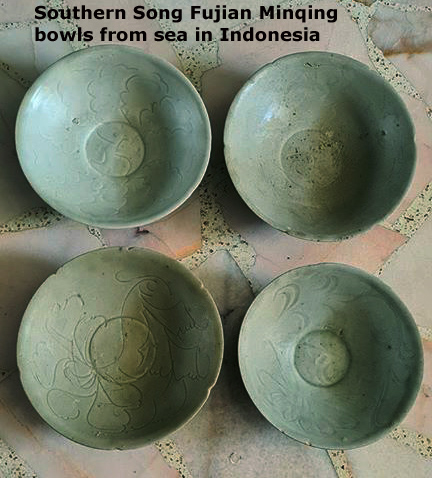
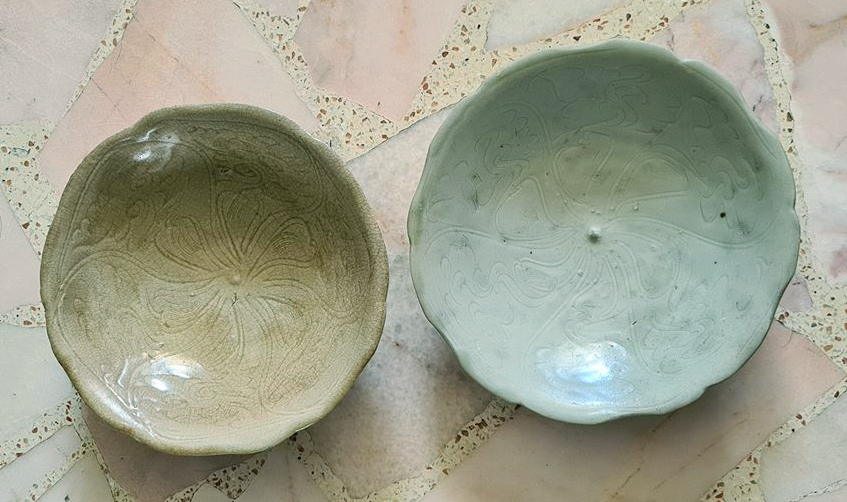
More samples of Mingqing bowls
There are other Minnan kilns that produced Qingbai wares. The good ones have beautiful light bluish glaze. But there are many with more grayish white or grayish yellow colour tone. Sometime they may be confused with the Fujian green ware. But as a whole it is still able to tell apart by the relatively thinner potting.
| These ewers (likely made in same kiln) from the Jepara wreck show the wide variation of colour tone ,the two on the left have light bluish glaze but that on the right appears grayish white. |
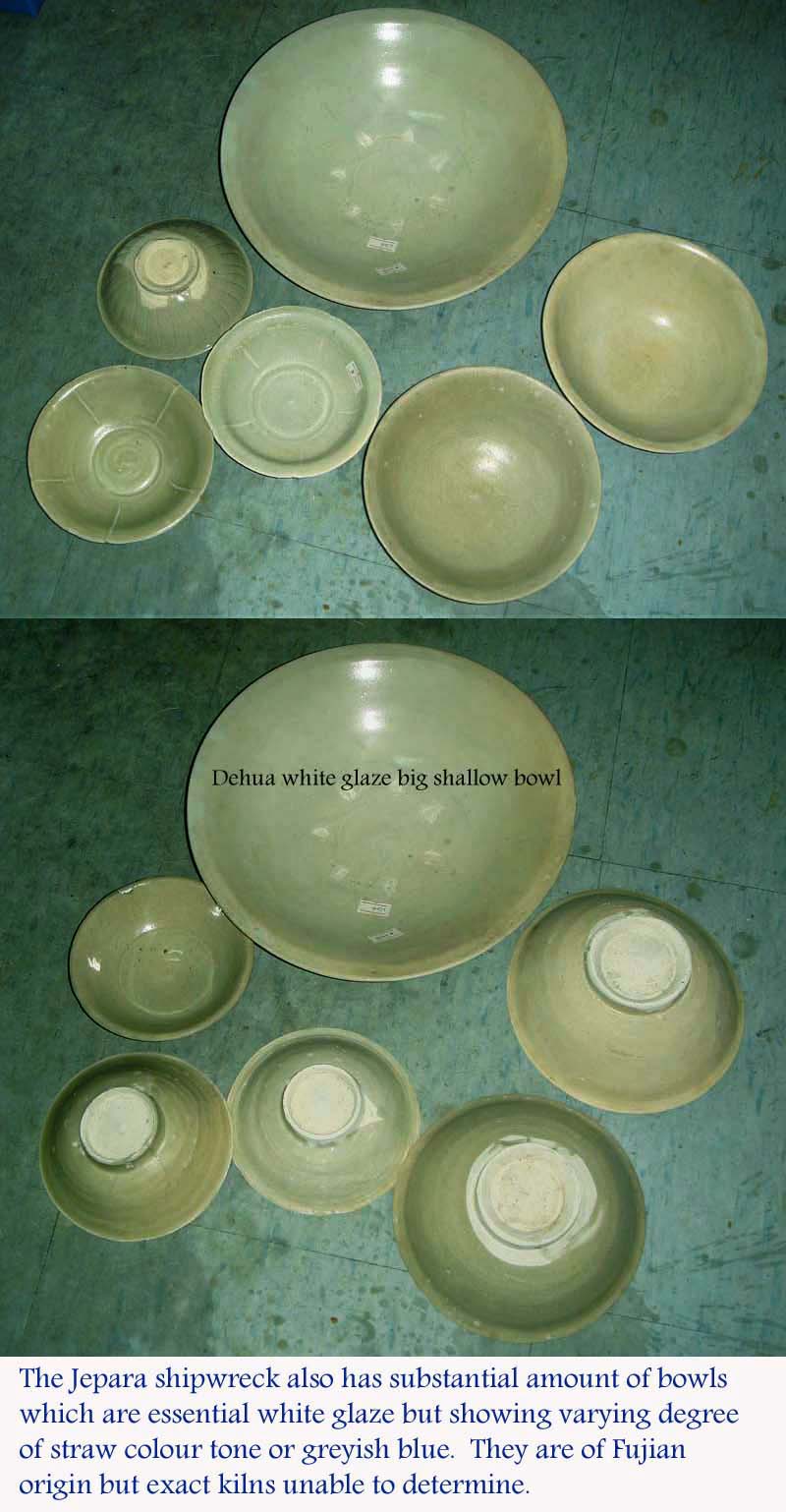
Black/Brown and Lead-glaze wares
Cizao kilns in Jinjiang was a major producer of black/brown and lead green glaze wares. The late Northern Song "Flying Fish Wreck" fond near Sabah carried some quantity that can be attributed to Cizao kiln.
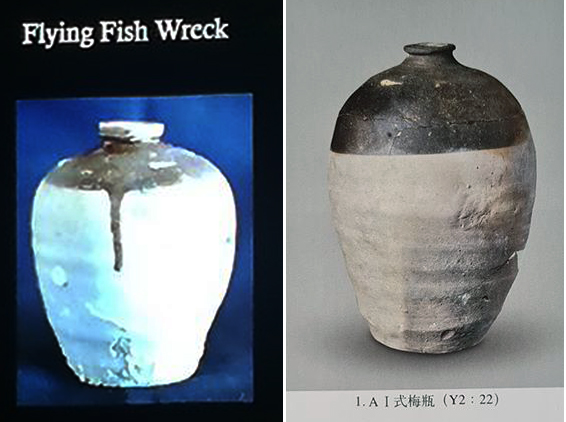
Some Southern Song Cizao brown and lead green glaze ware were found in the Nanhai 1 wreck.
Cizao brown glaze wares from Nanhai 1 wreck
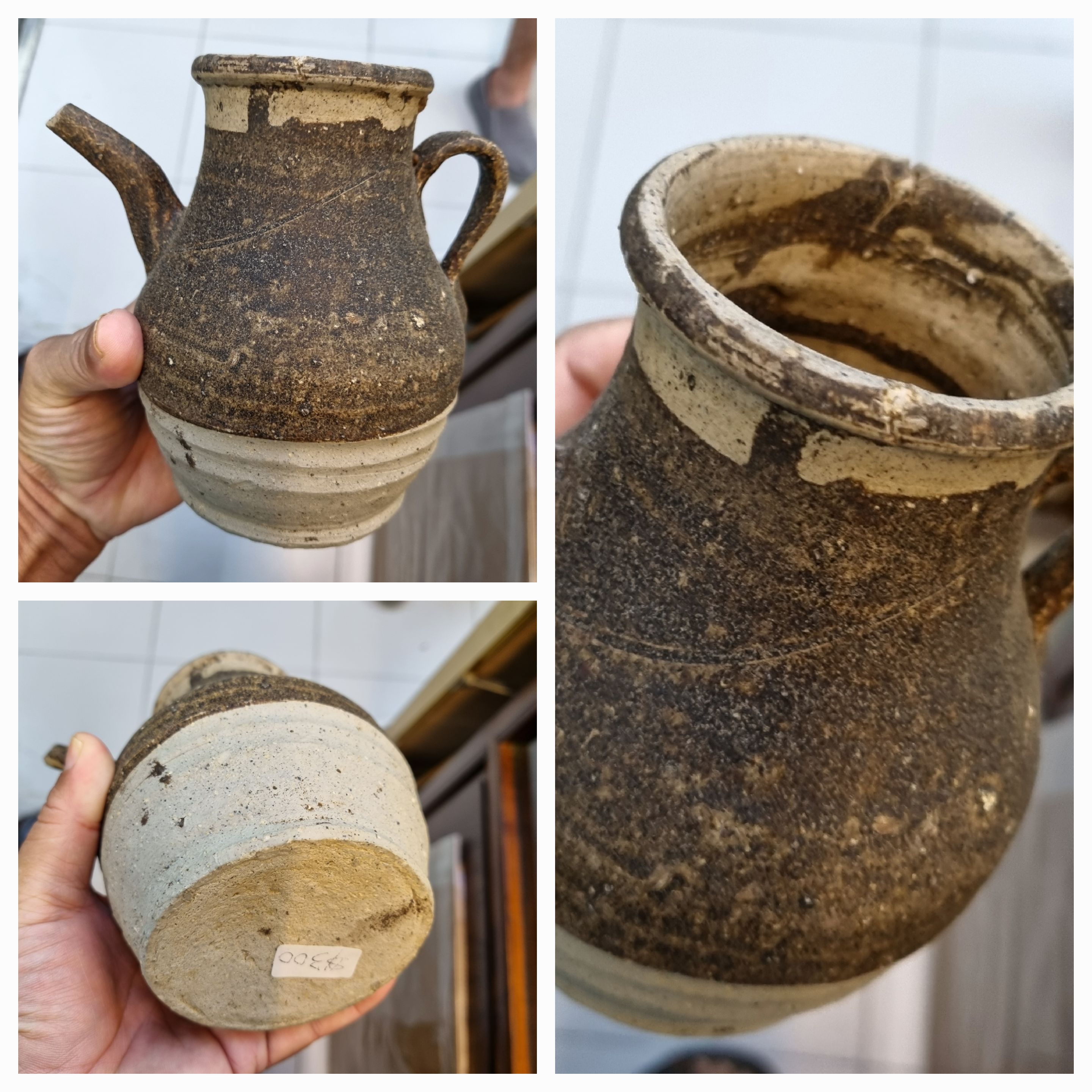
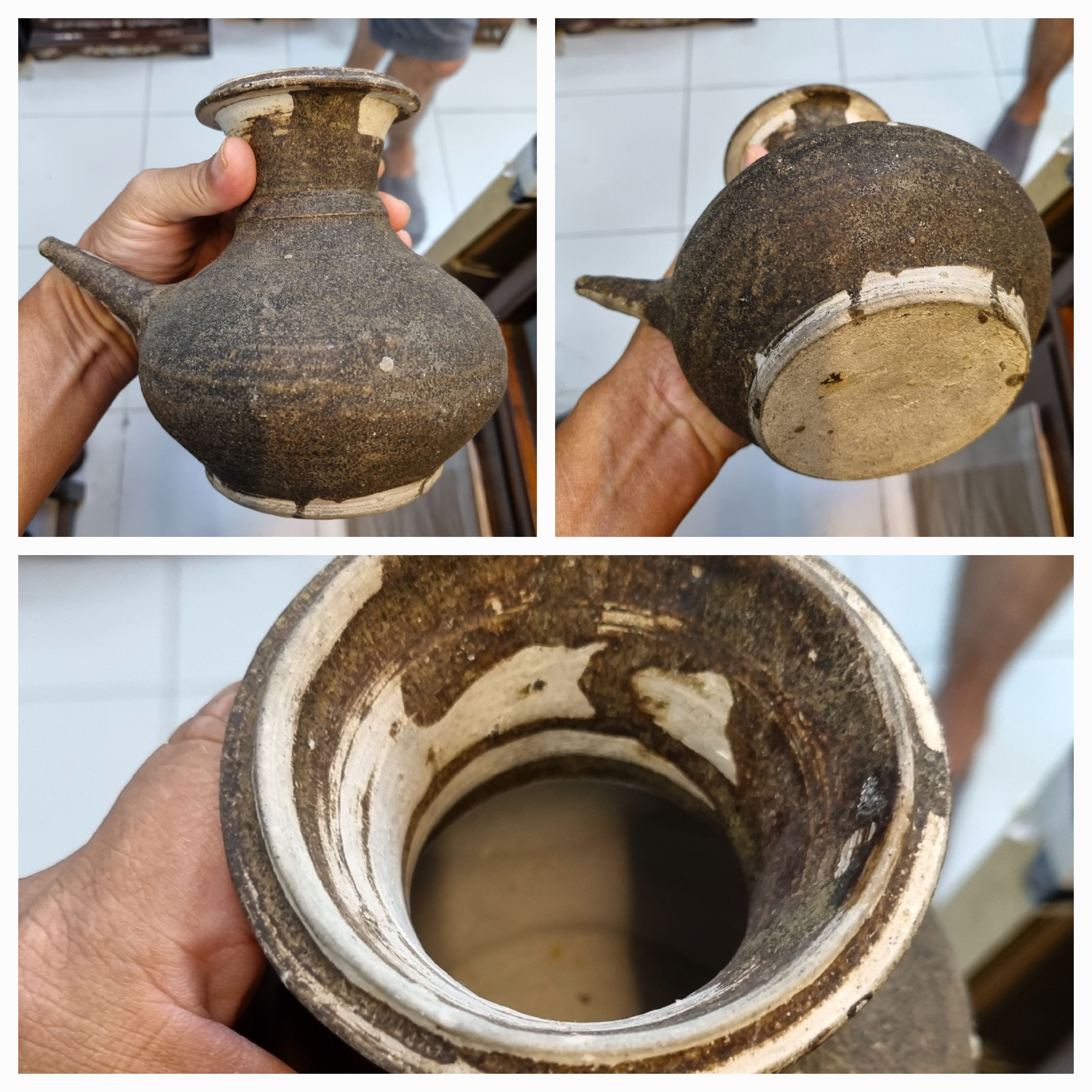
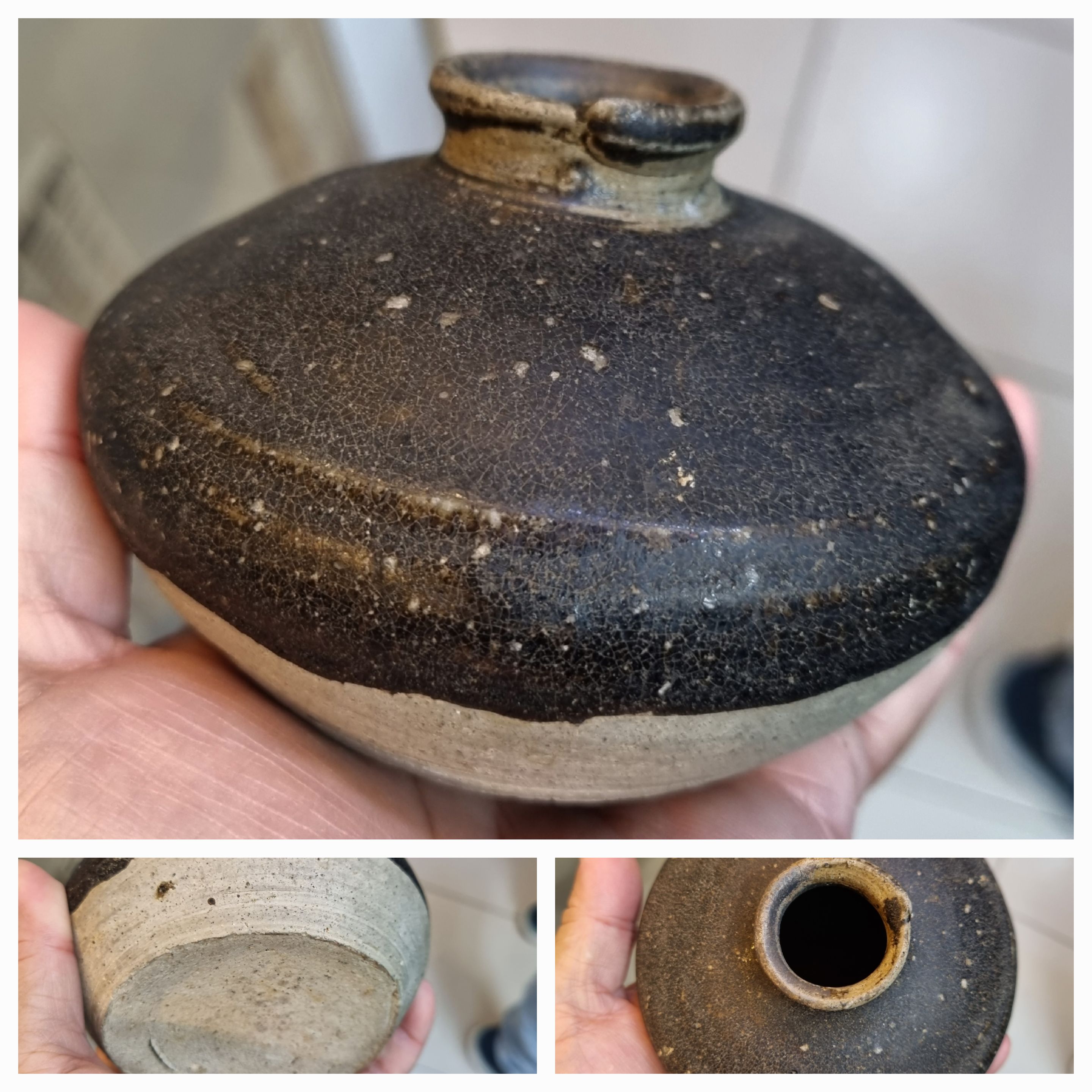
Cizao brown glaze vessels found in Indonesia
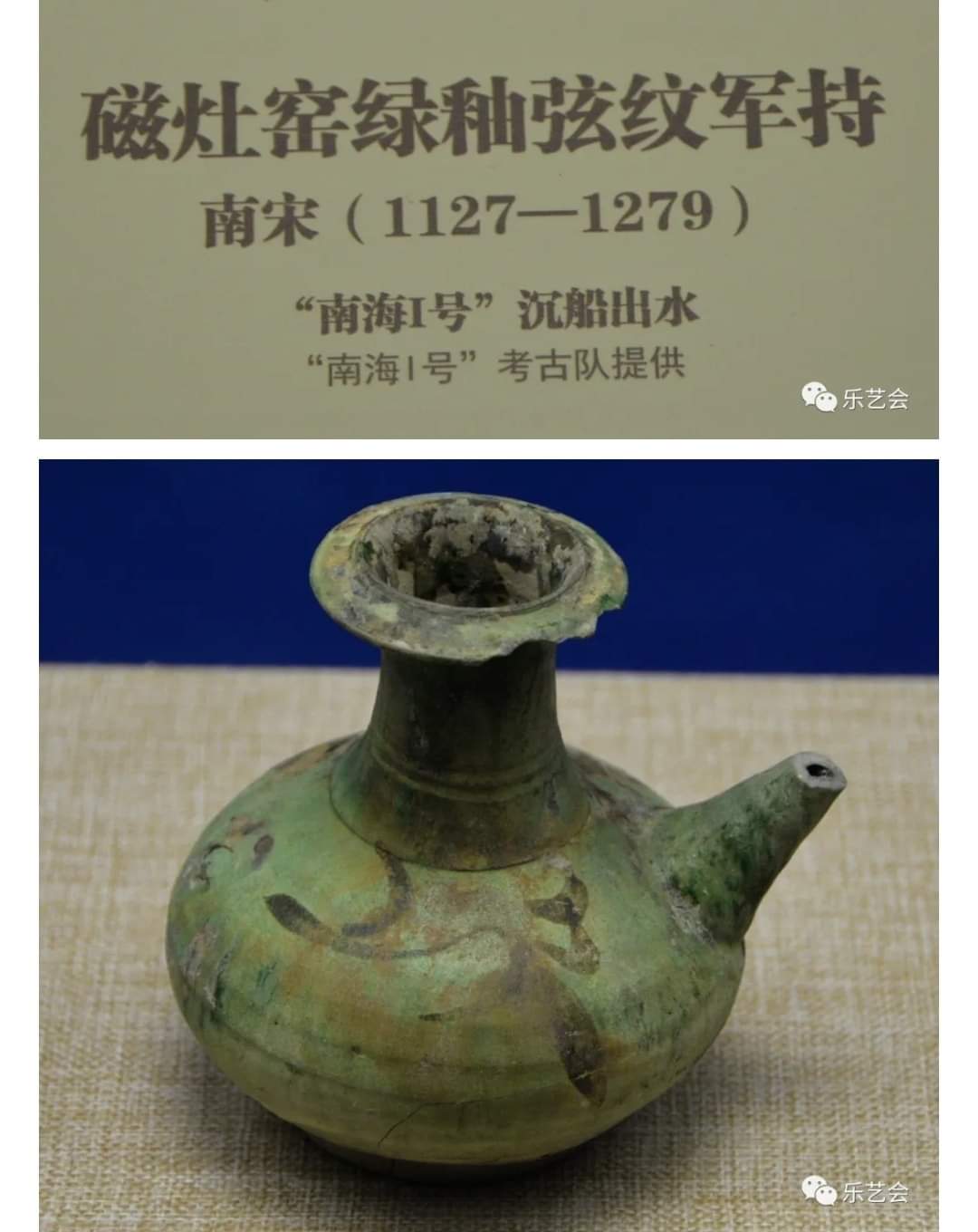
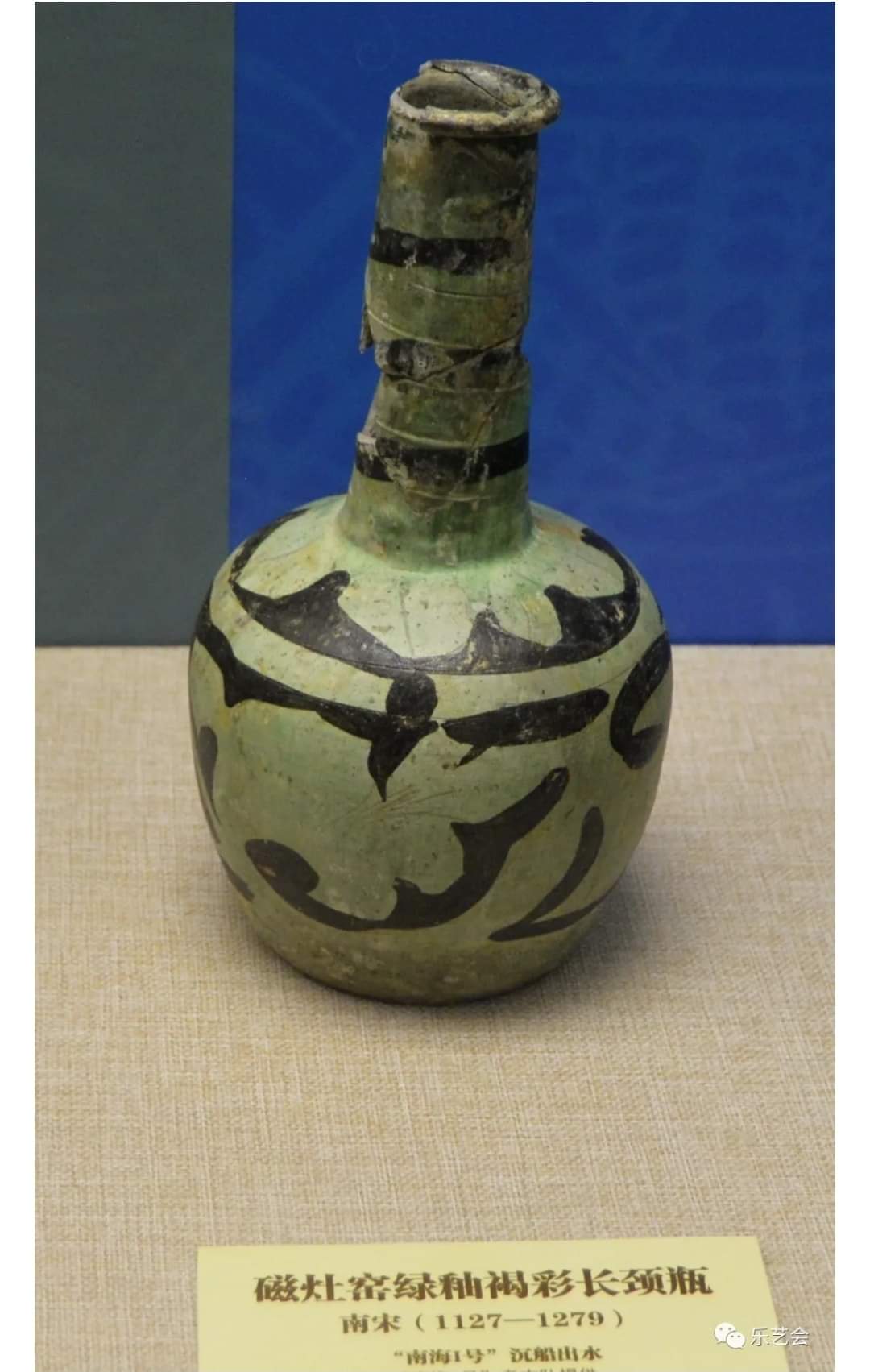
Green lead glaze vessels with iron-brown decoration from Nanhai 1 wreck
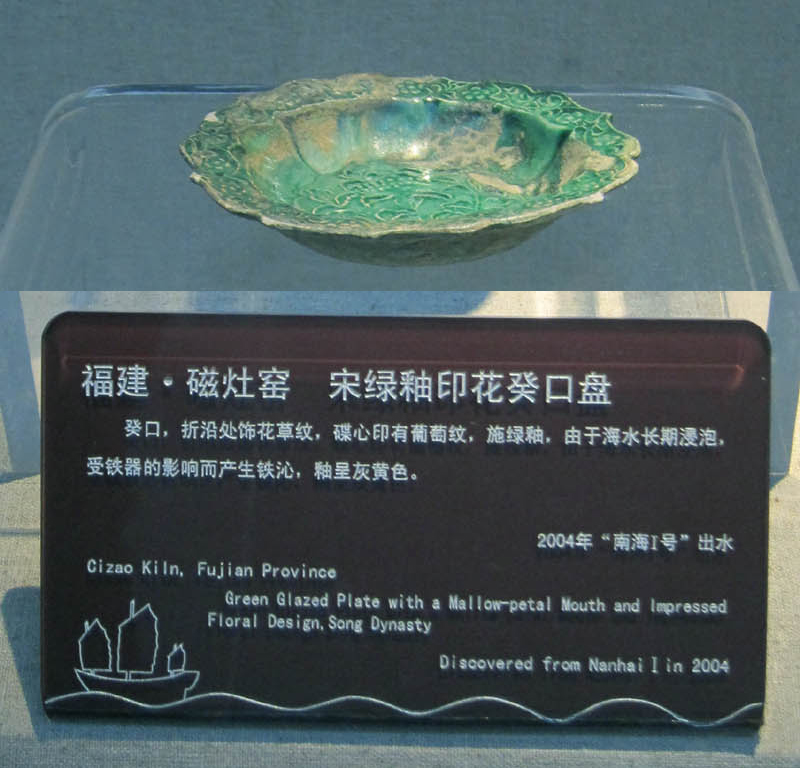
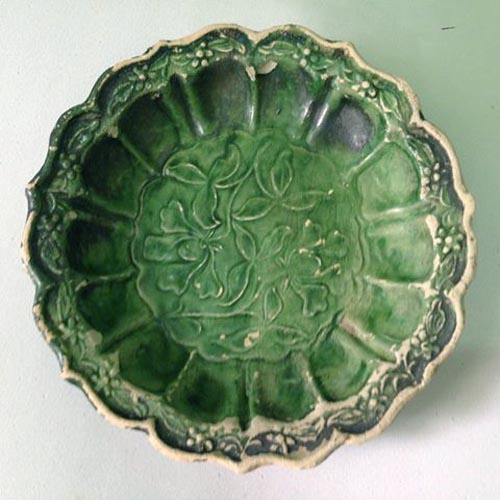 |
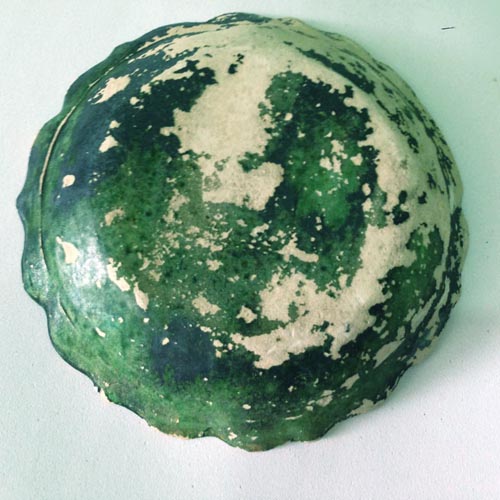 |
Lead glaze dish from the Nanhai 1 wreck
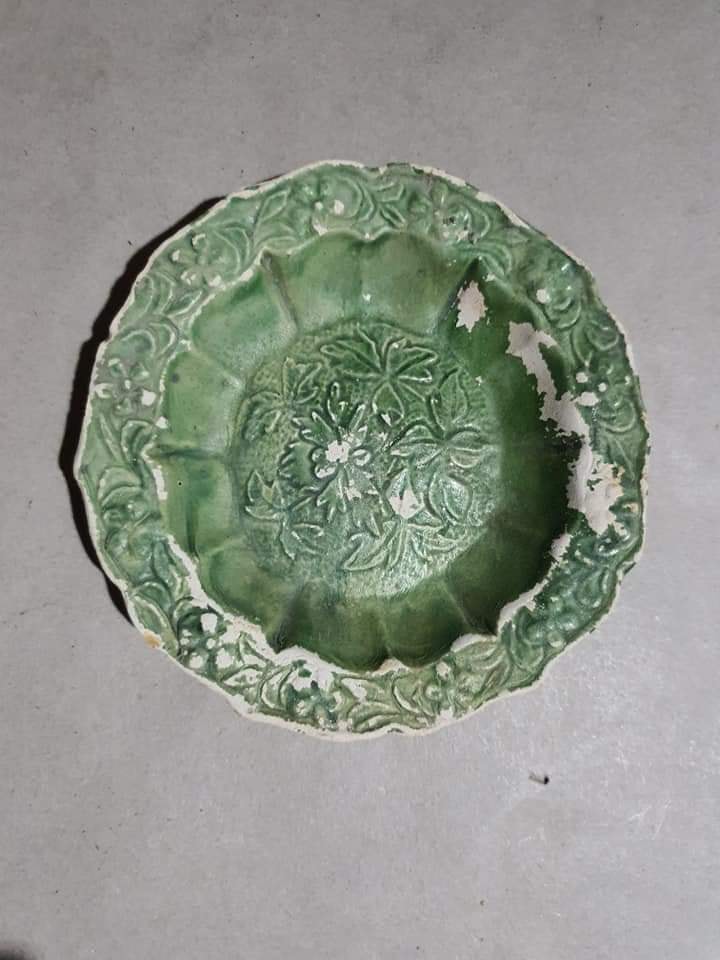 |
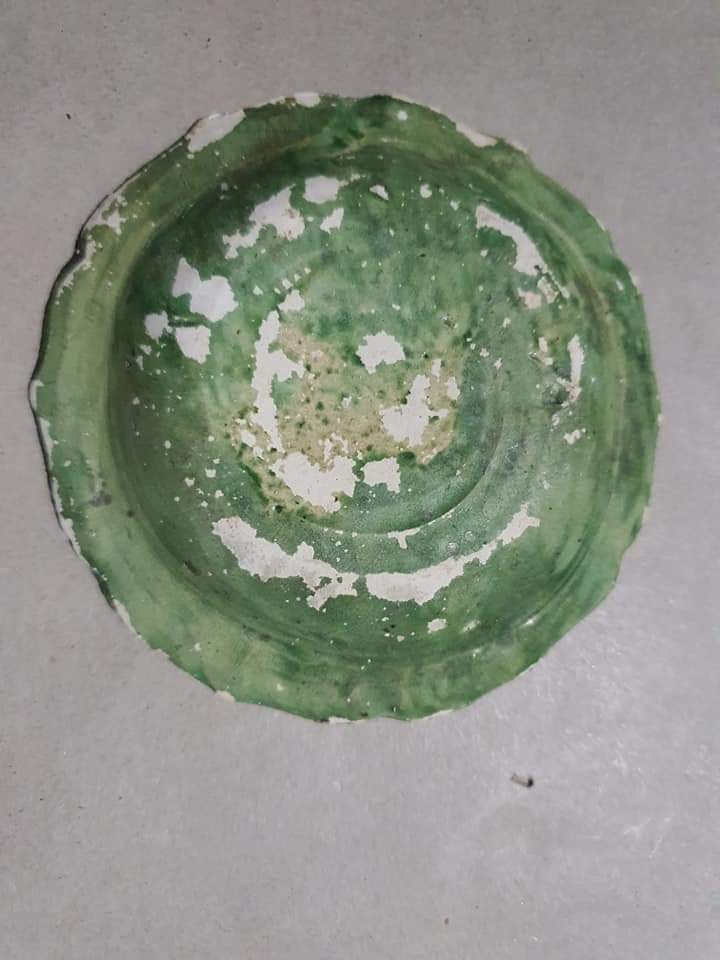 |
| Examples from an Indonesian collection | |
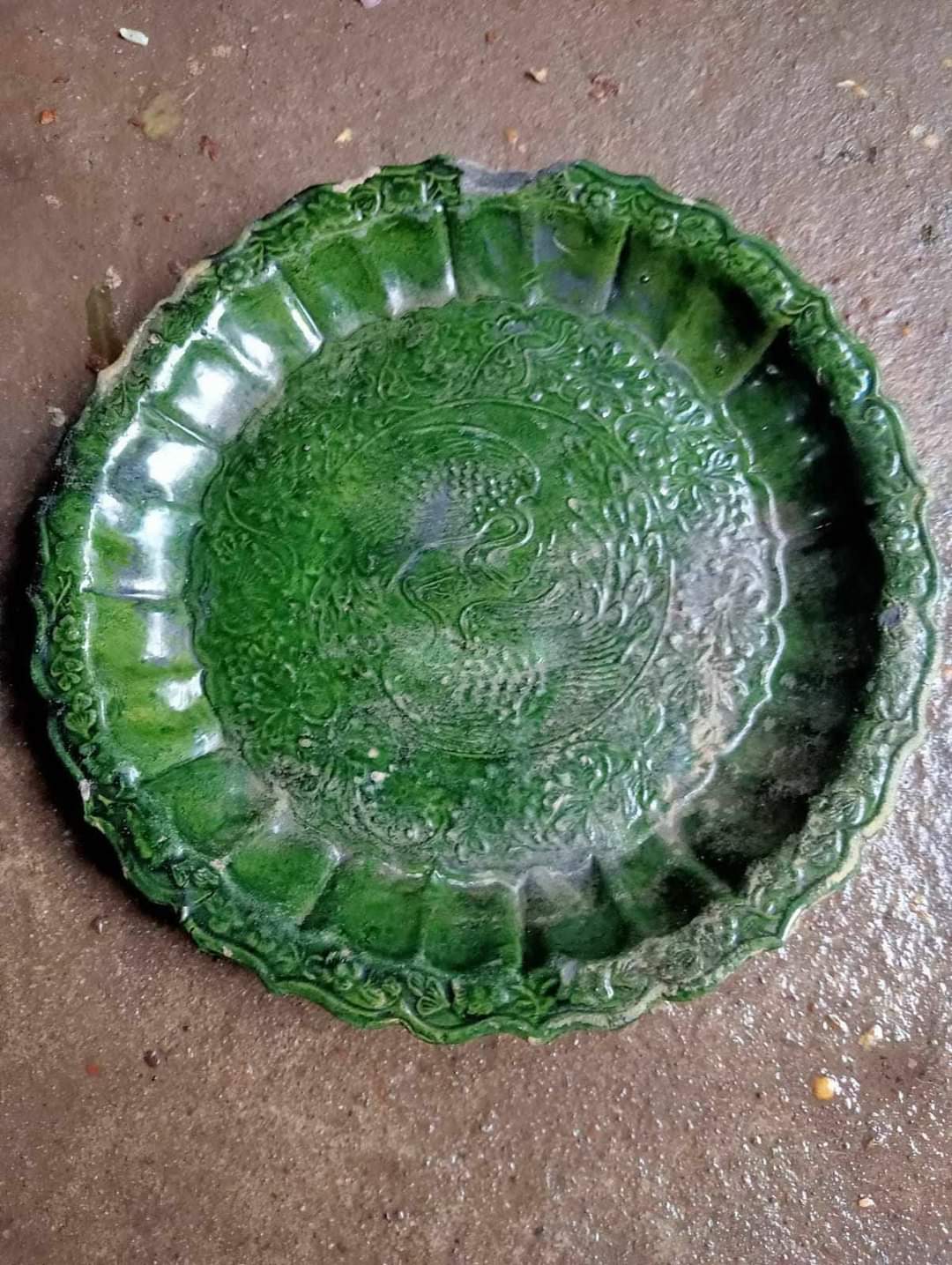 |
|
| Example found in Sumatra Jambi | |
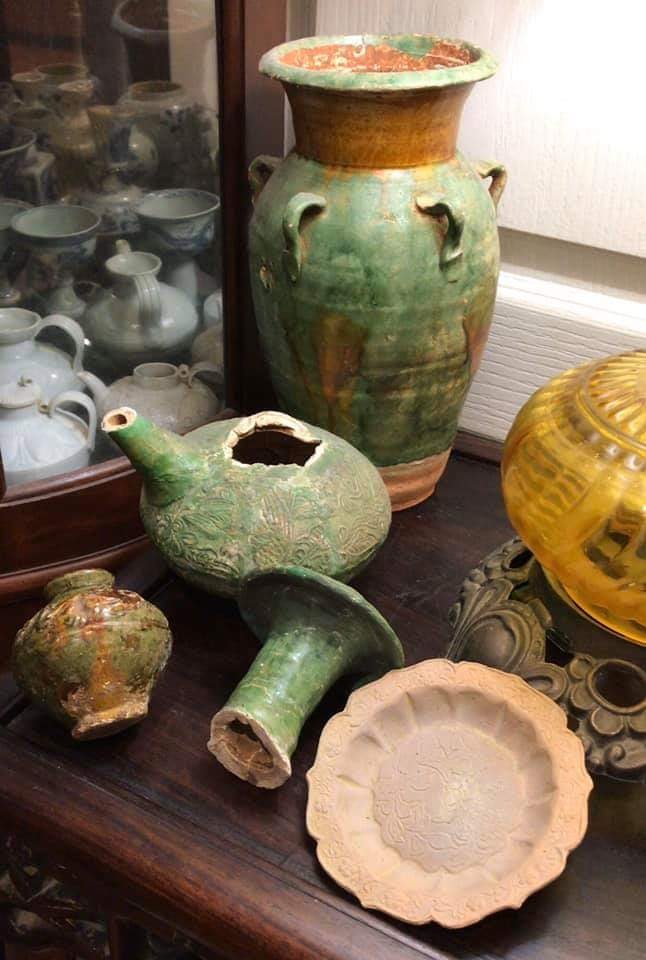
Cizao examples found in Indonesia Sulawesi
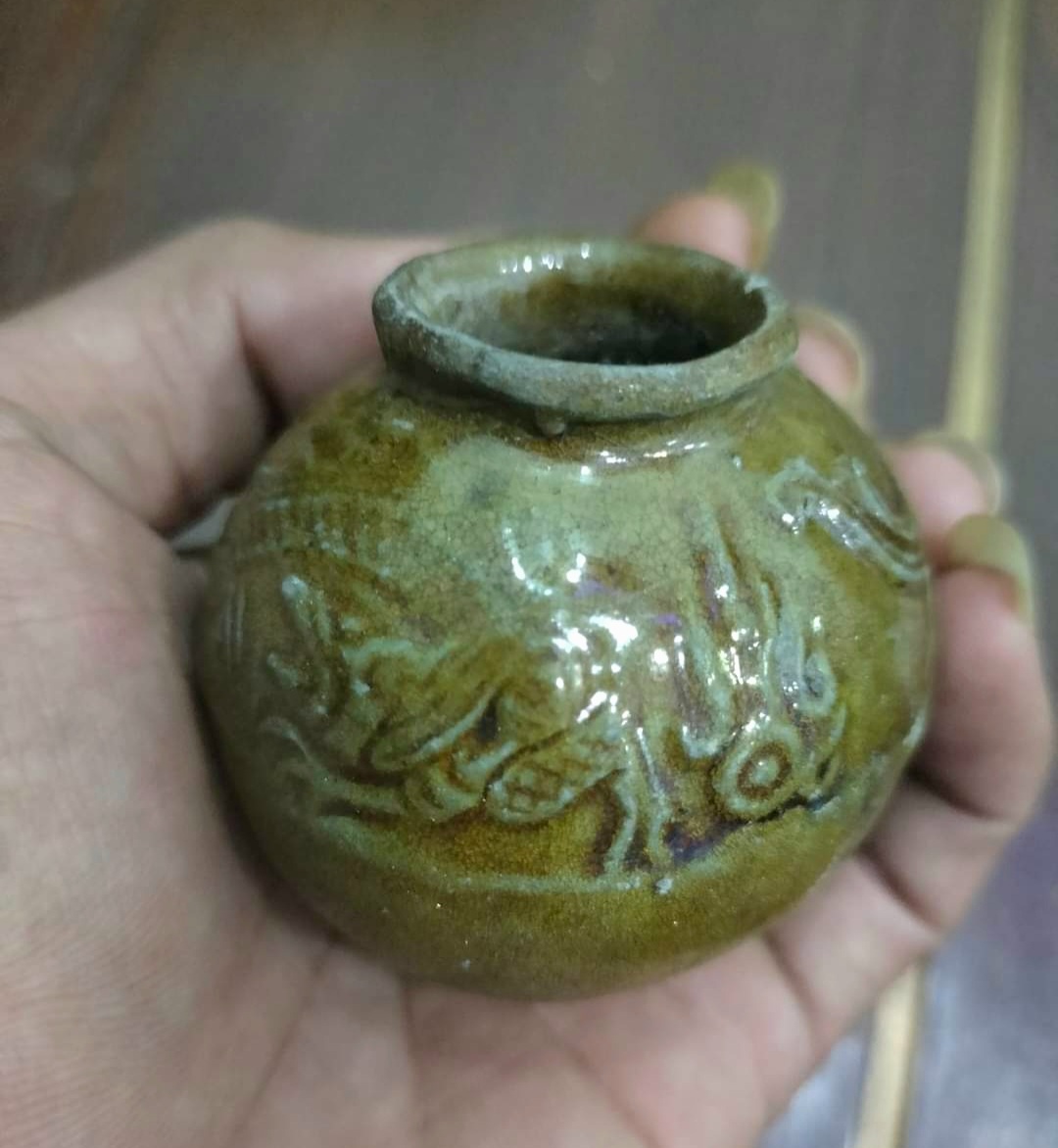 |
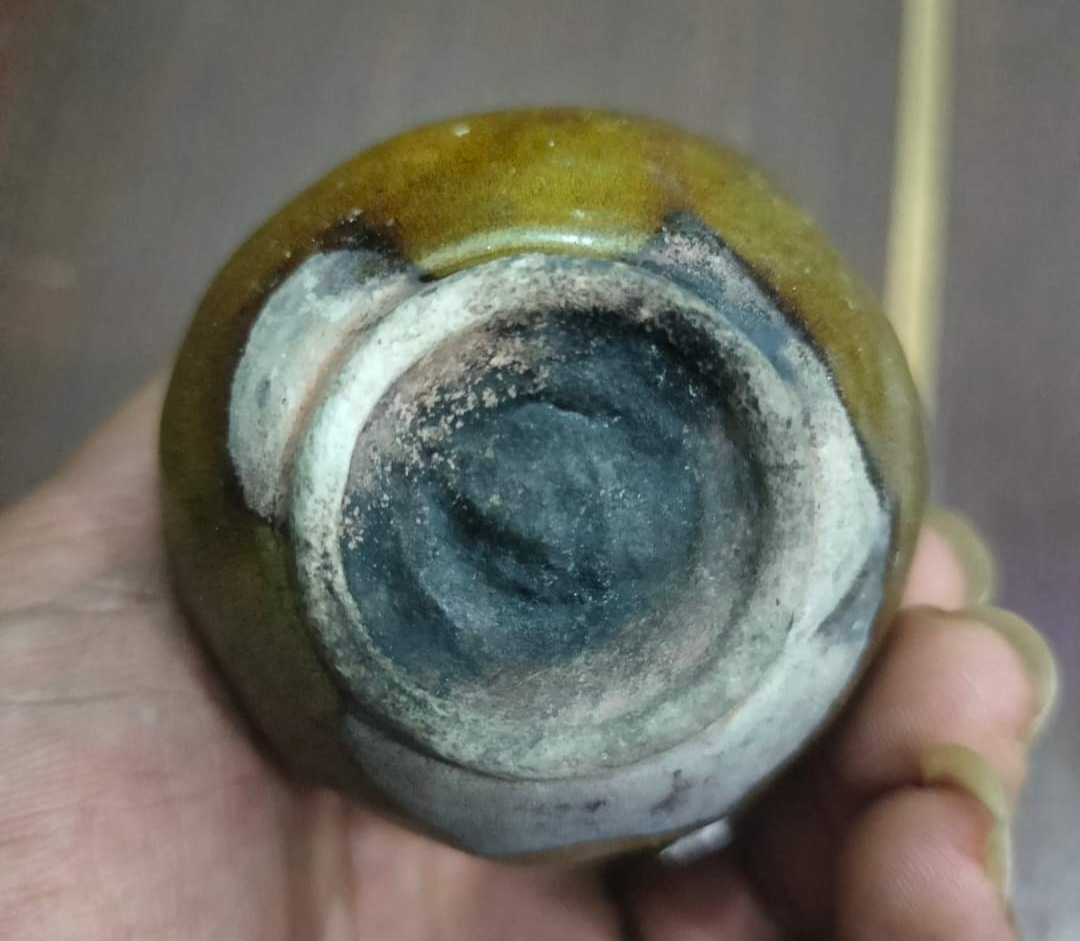 |
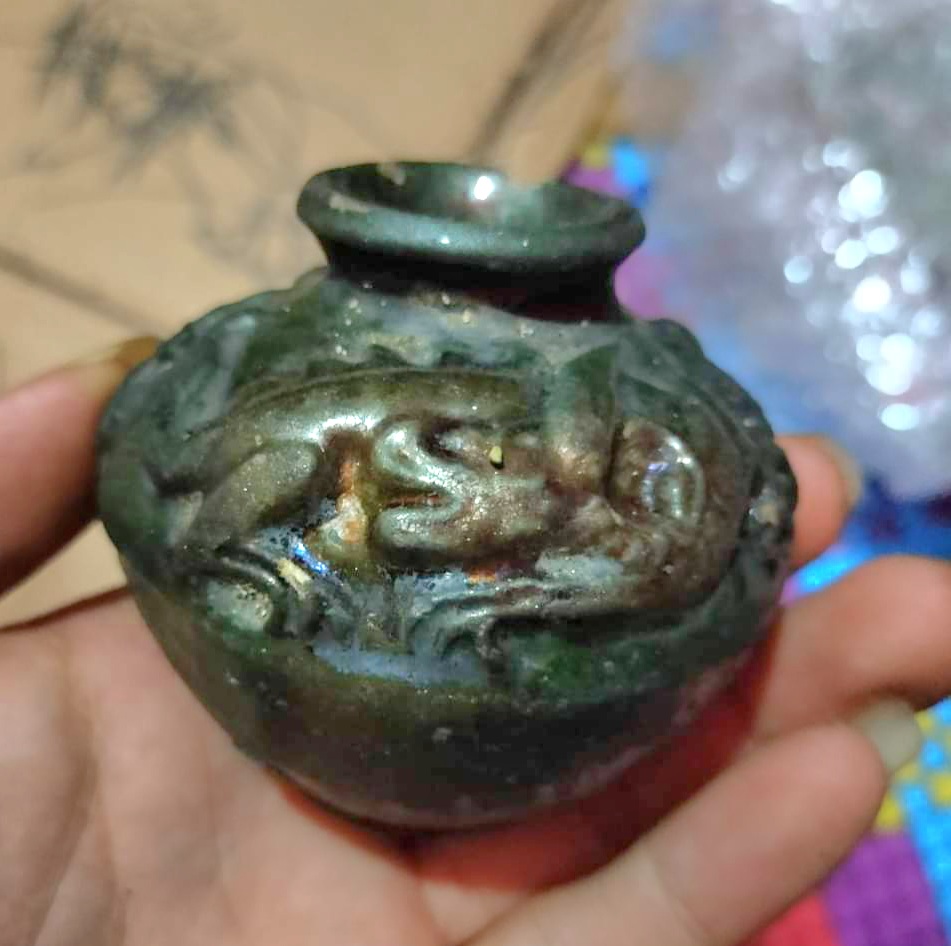 |
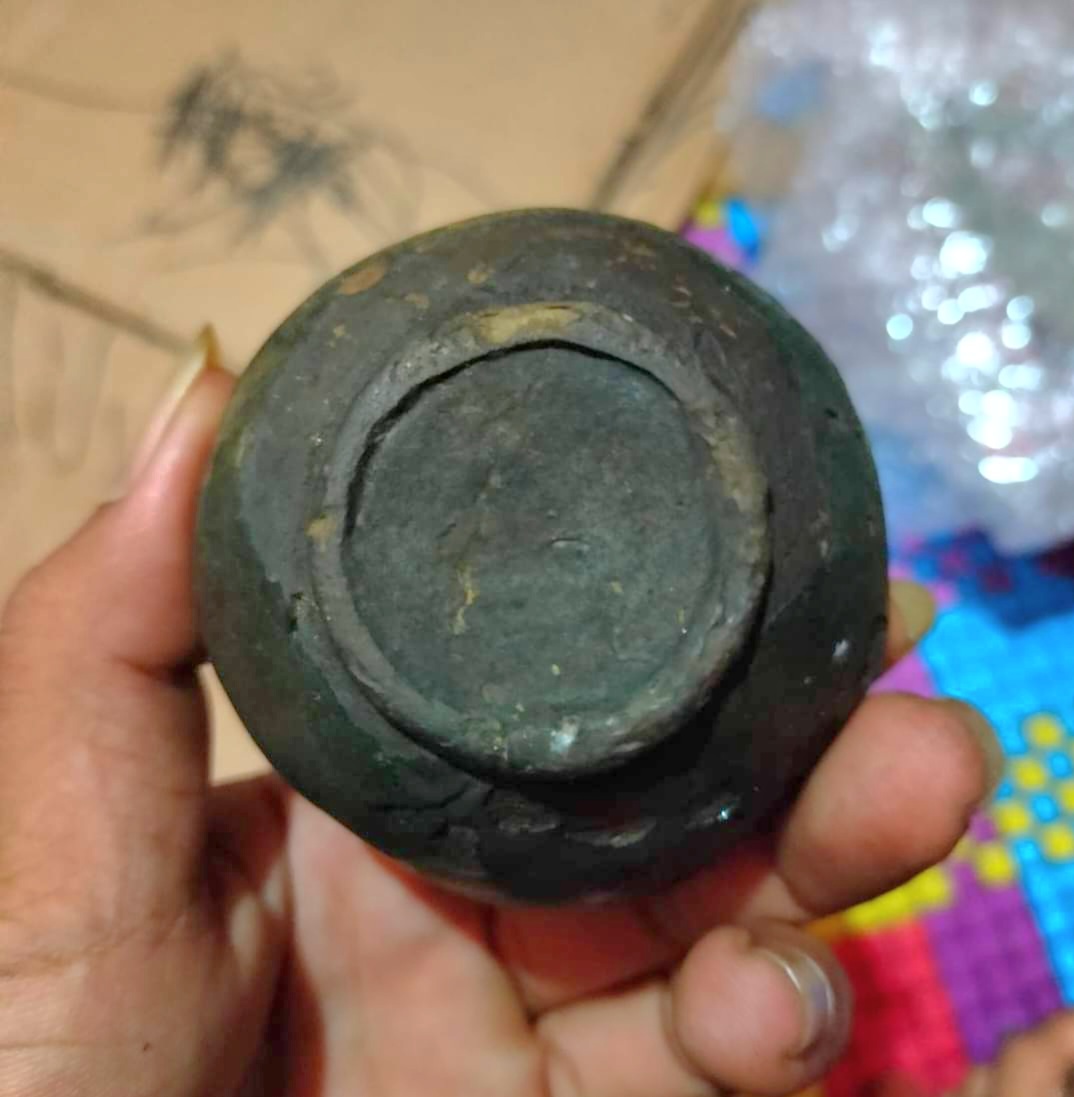 |
| Two Southern Song lead-glaze jarlets with moulded dragon decoration from Cizao Kiln |
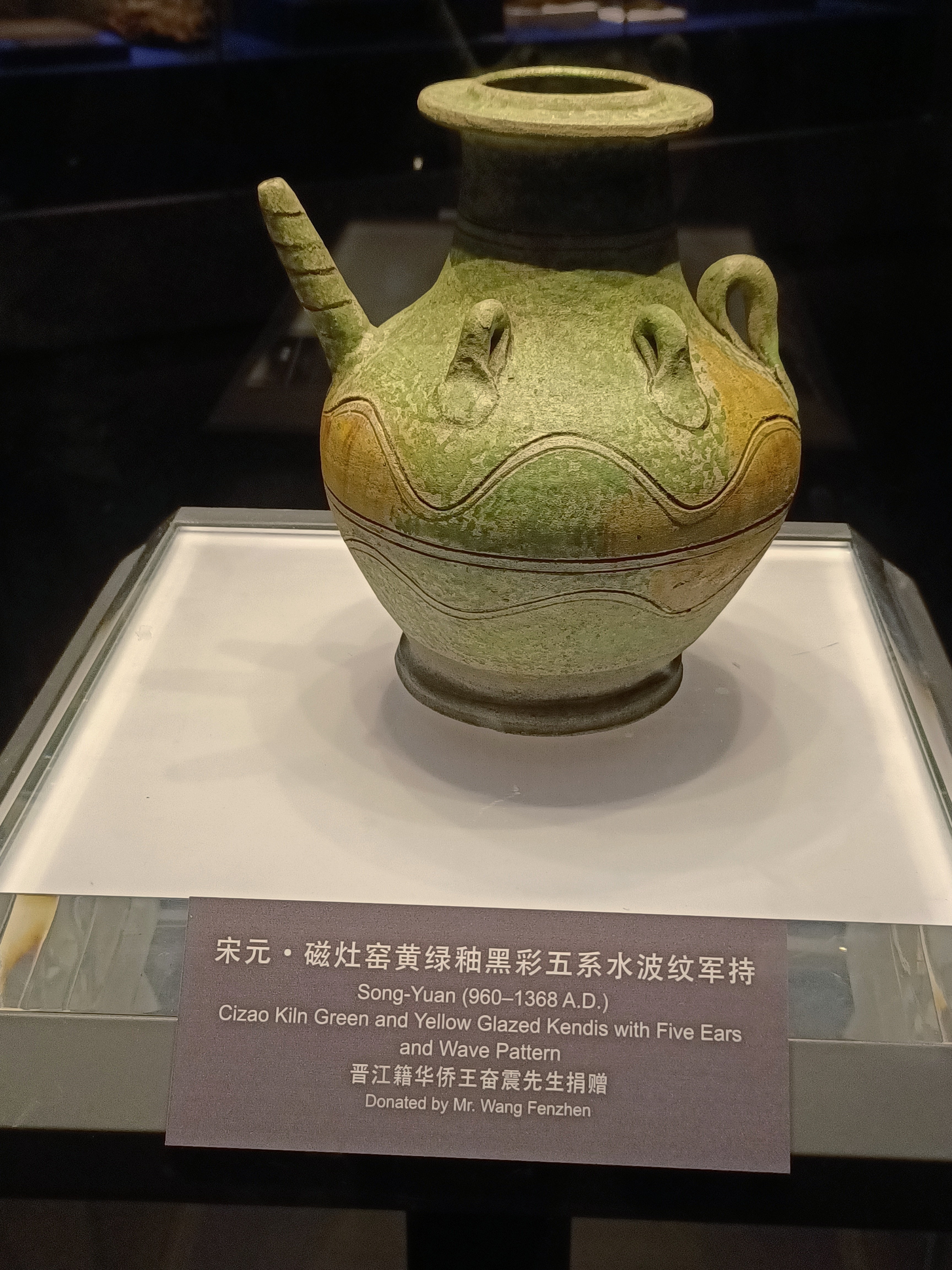 |
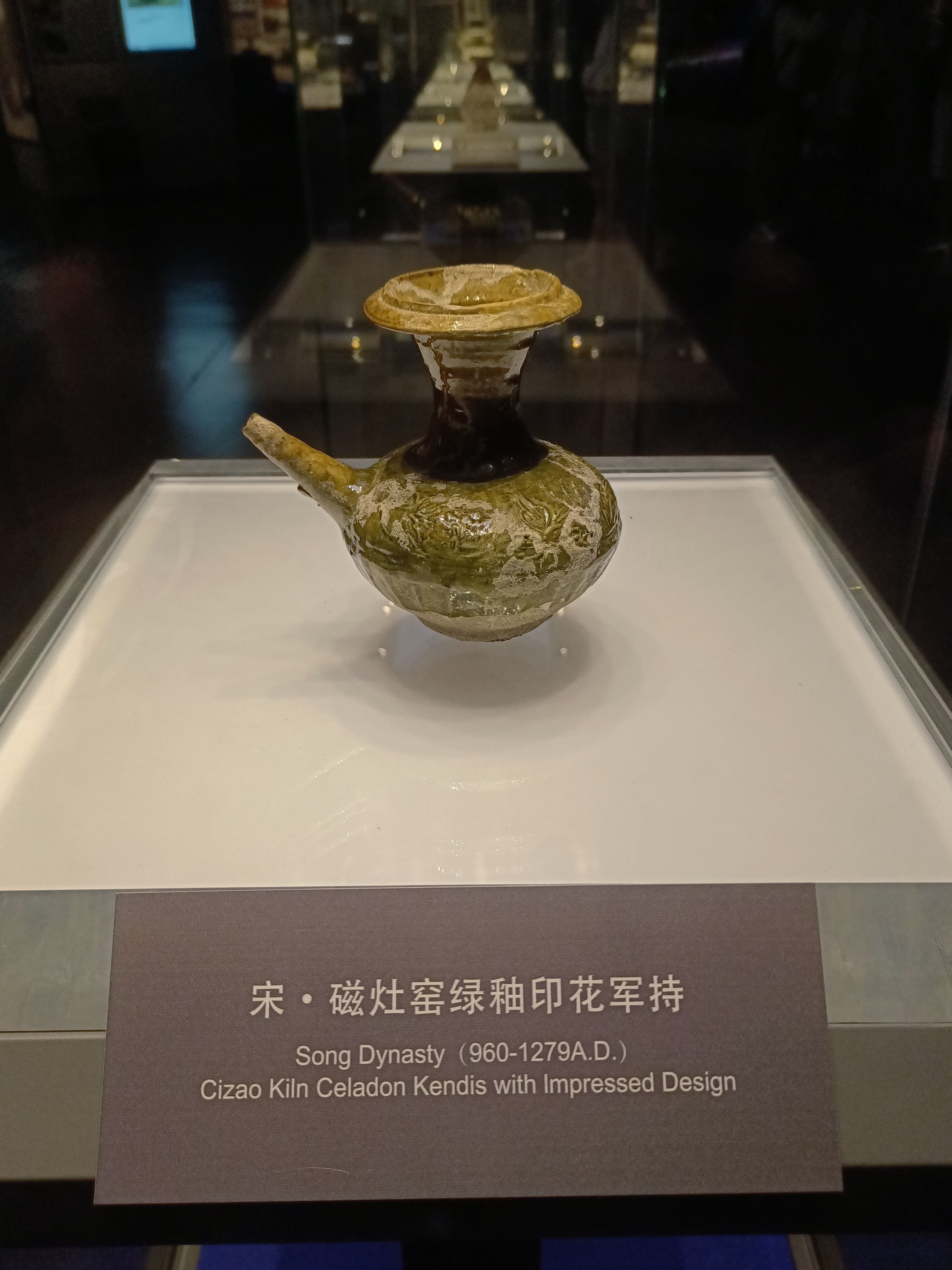 |
Wares with Iron black/Brown painted decoration
Among the export ceramics in the "Flying Fish wreck", there are some basin shape vessels with iron-brown painted fish decoration under a yellowish green glaze. So far, most known examples were found in Japan. Cizao kiln in Fujian Quanzhou has been identified as the production site. Based on the examples recovered from the kiln, there are also those with floral and calligraphic inscription. We should note that such painted decoration are also produced in other kiln sites in Fujian. For example, those from Fujian Fuqing shared close similarities.
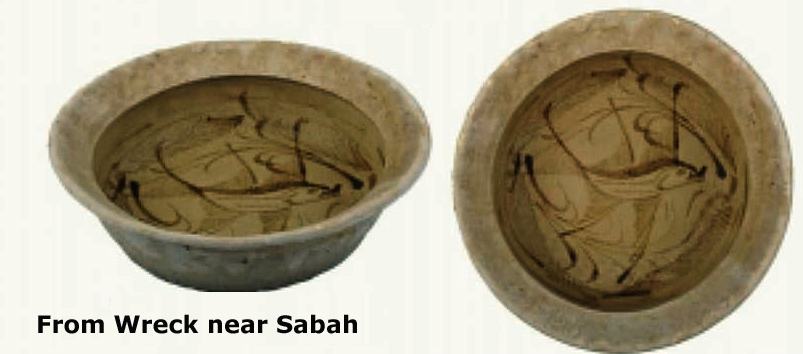
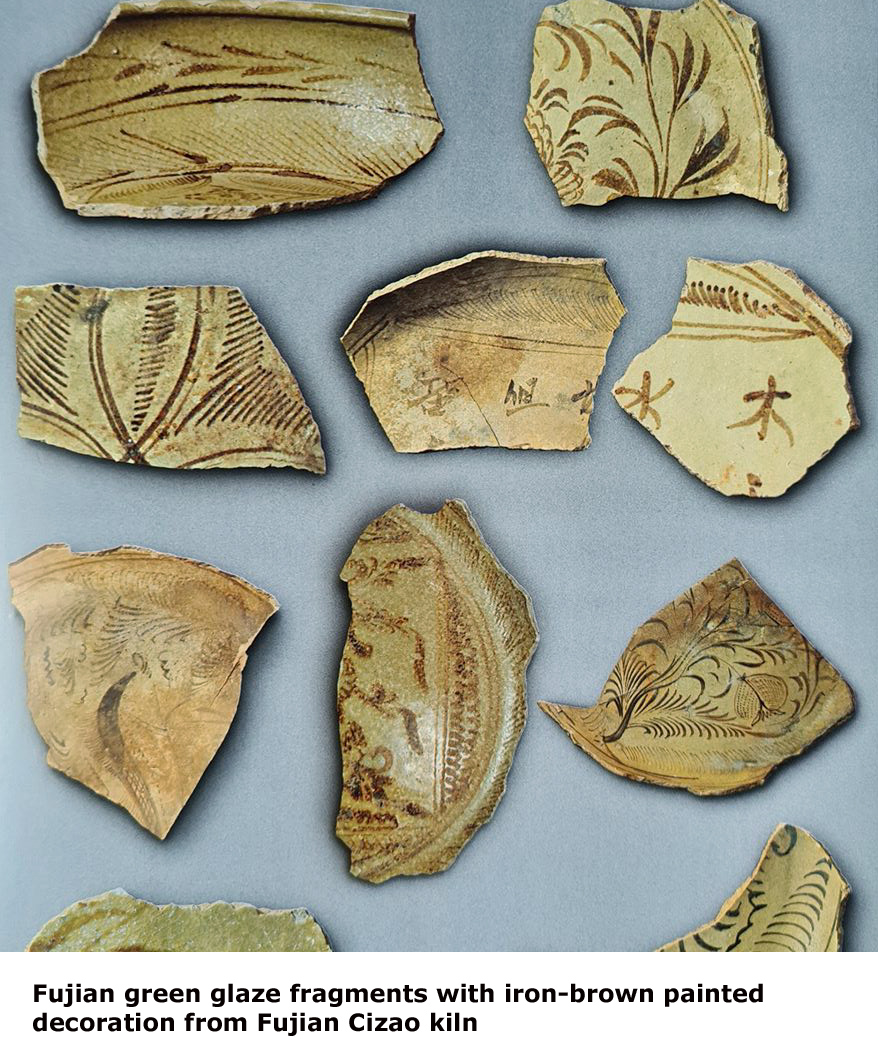
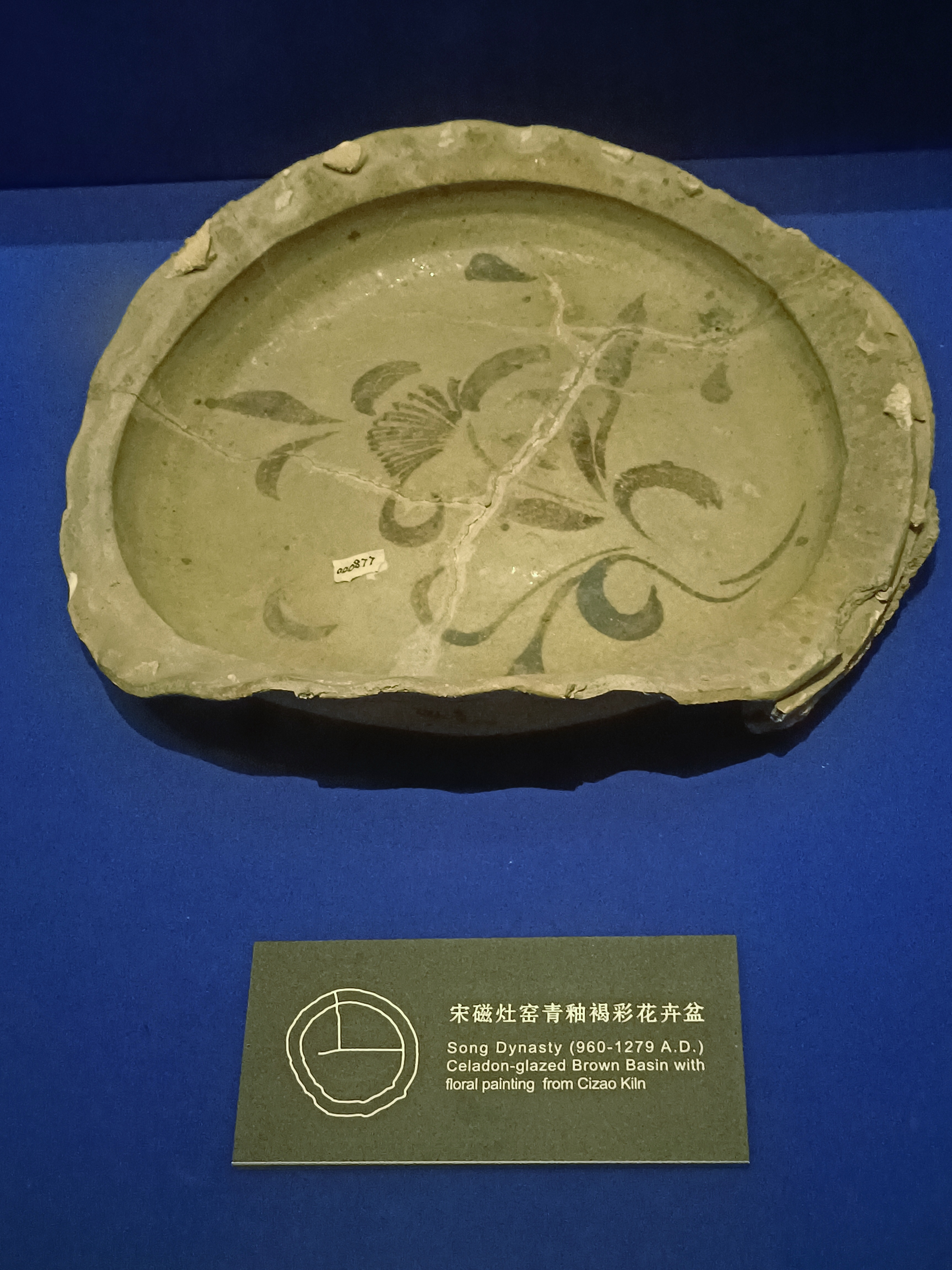
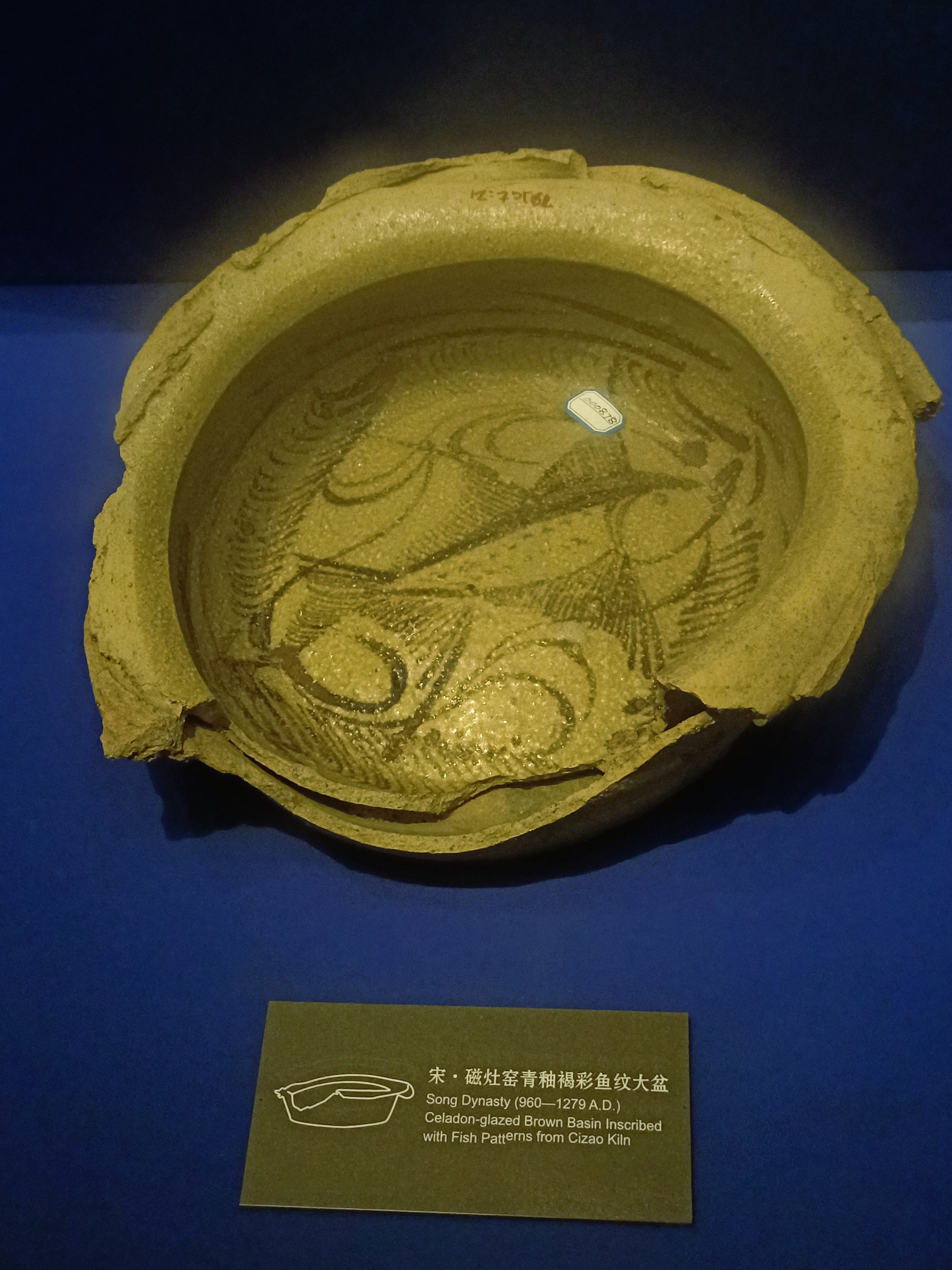
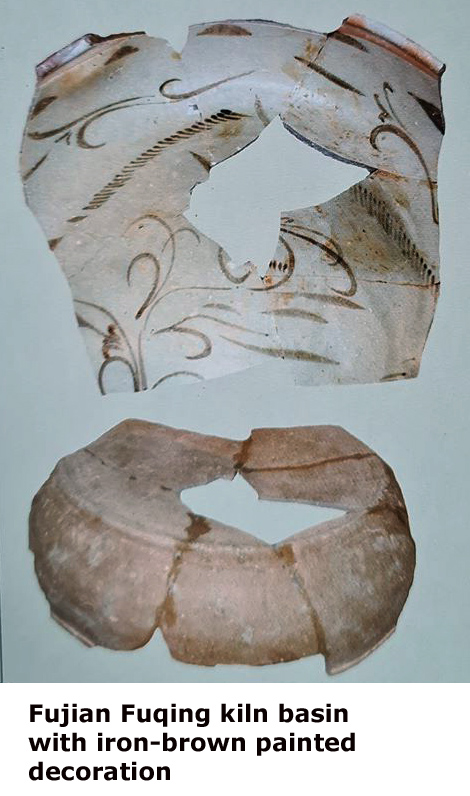
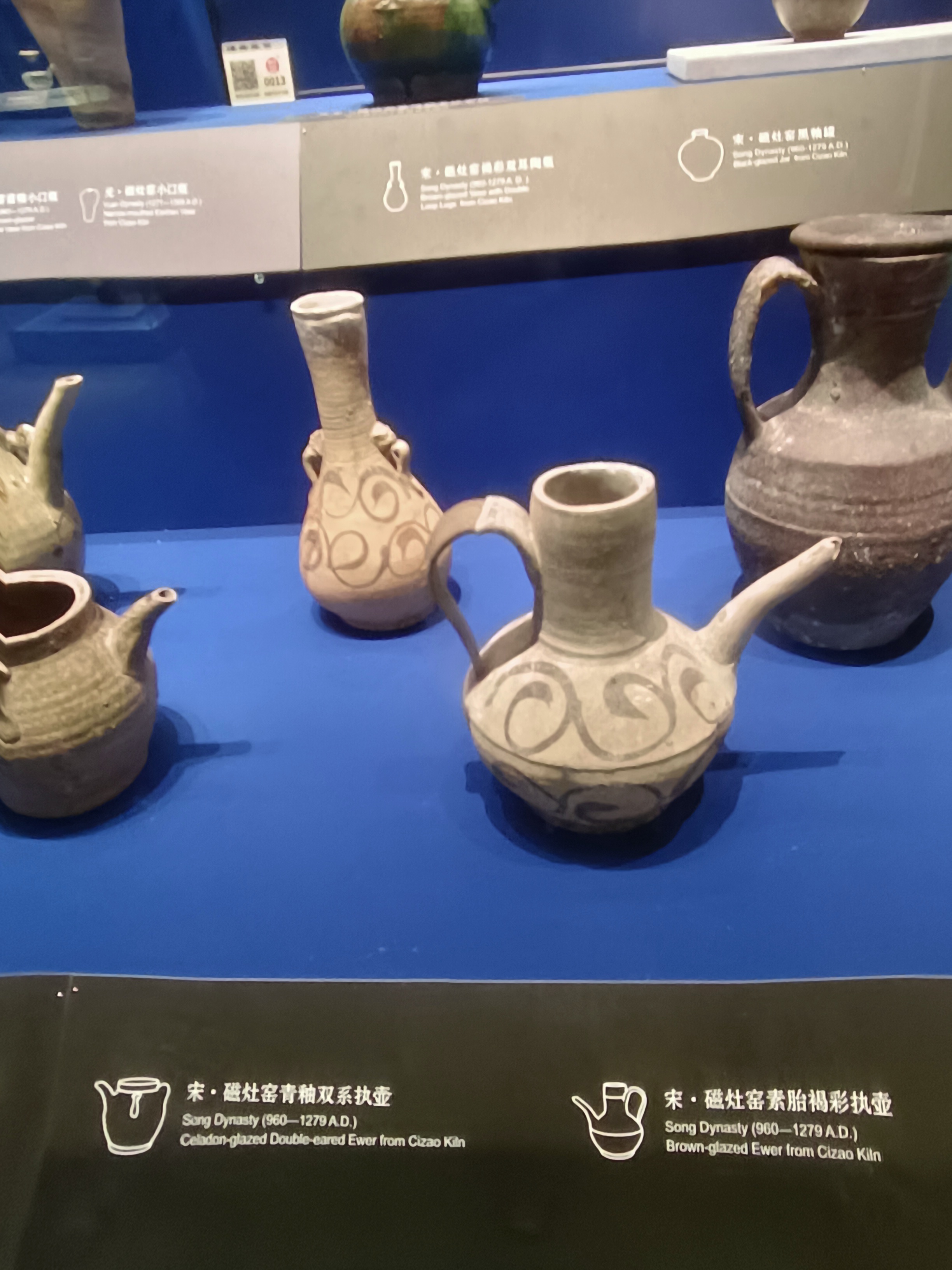
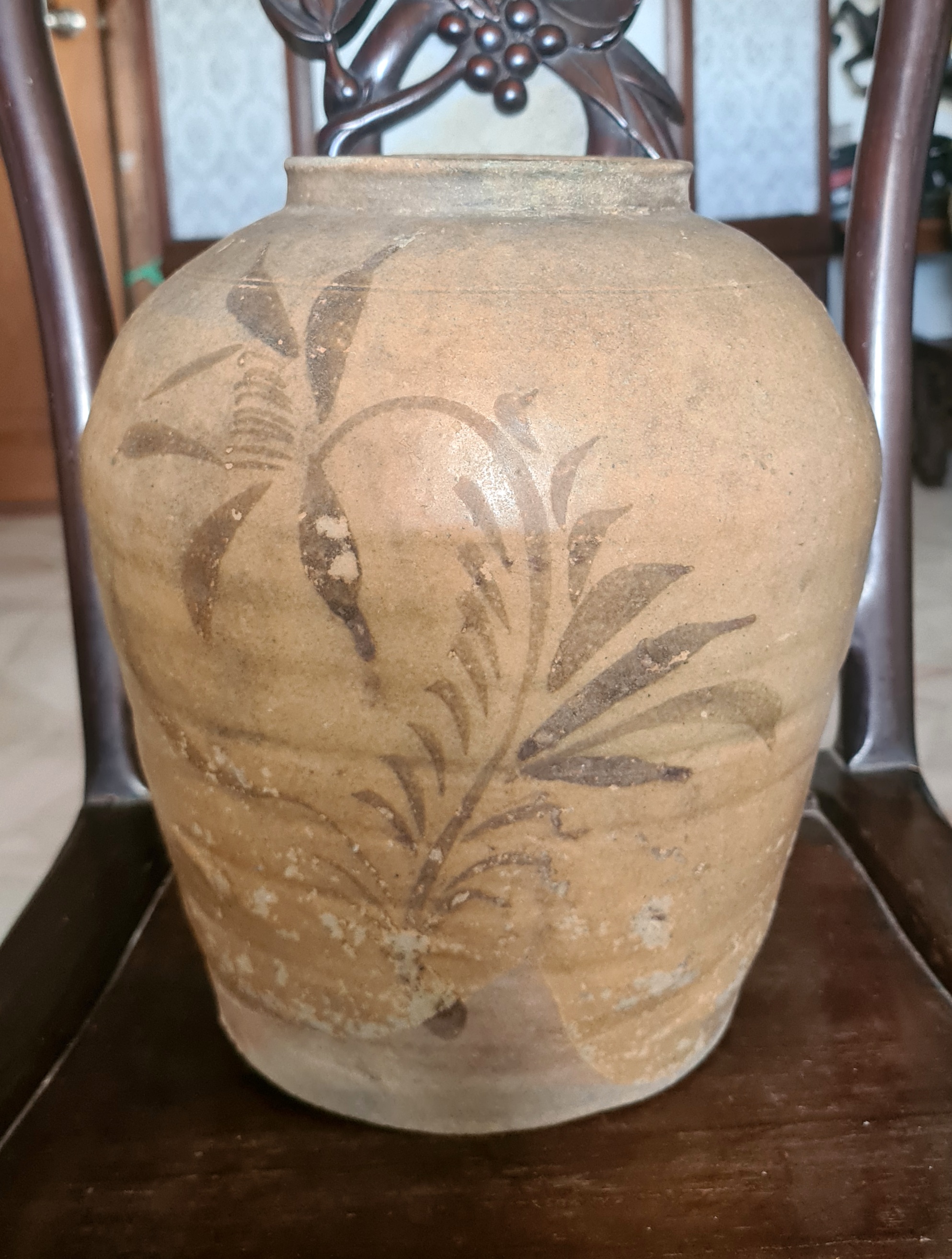
Late Northern Song Example found in Indonesia
Cizao wares with iron-black painted decoration continued to be produced during the Southern Song period.
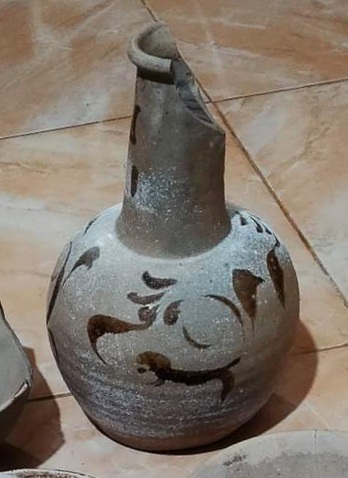
Southern Song example found in Indonesia
Other Fuian kilns also started producing iron-brown painted wares. The most important source of reference could be found in the Java Sea and Philippines Breaker Shoal wreck. Many pieces appeared to have iron-black motif on a whitish paste body. In fact, on closer examination, traces of lead glaze green and yellow glaze were found on some of the better preserved examples. Hence, they are lead yellow/green glaze wares with iron-black painted decoration. In the past, Wuyi Shan kiln has been suggested as the production site. But from a recent publication on Fuqing kiln, I noticed that those from the Minnan Fuqing kiln are characteristically more similar to those from the abovementioned wrecks.
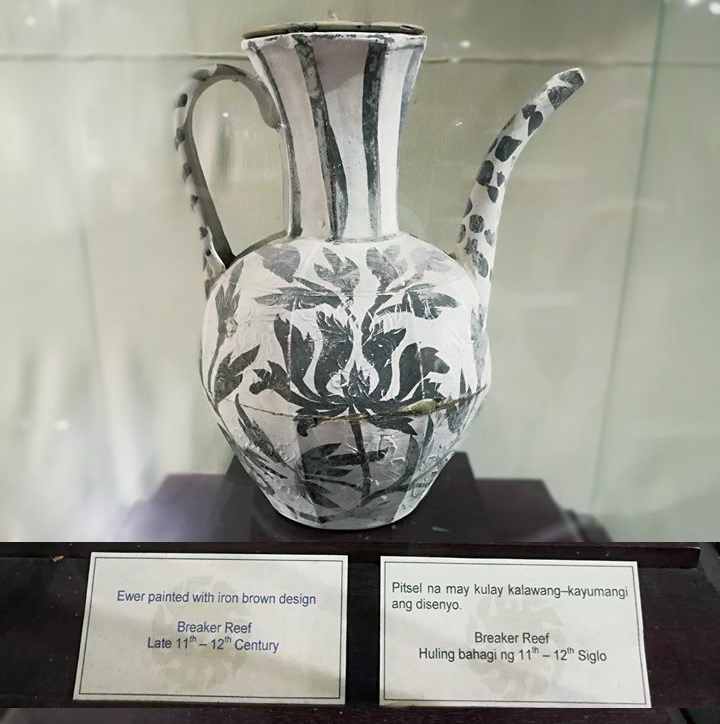
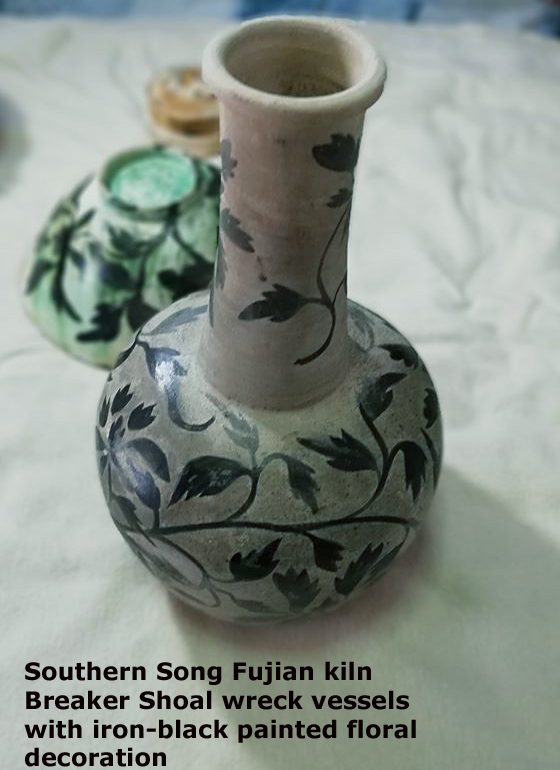
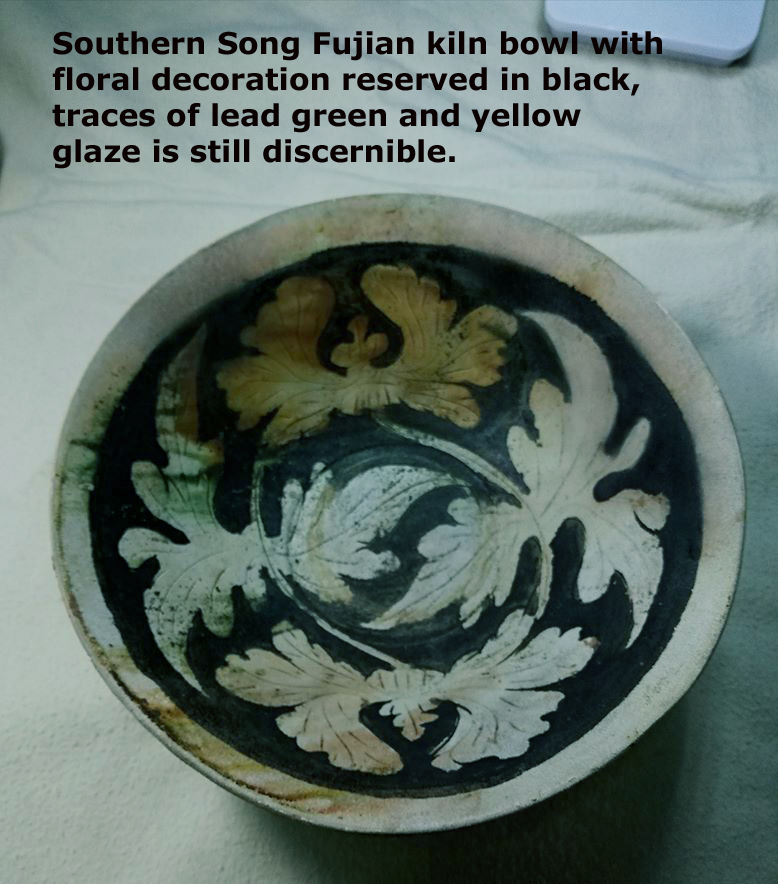
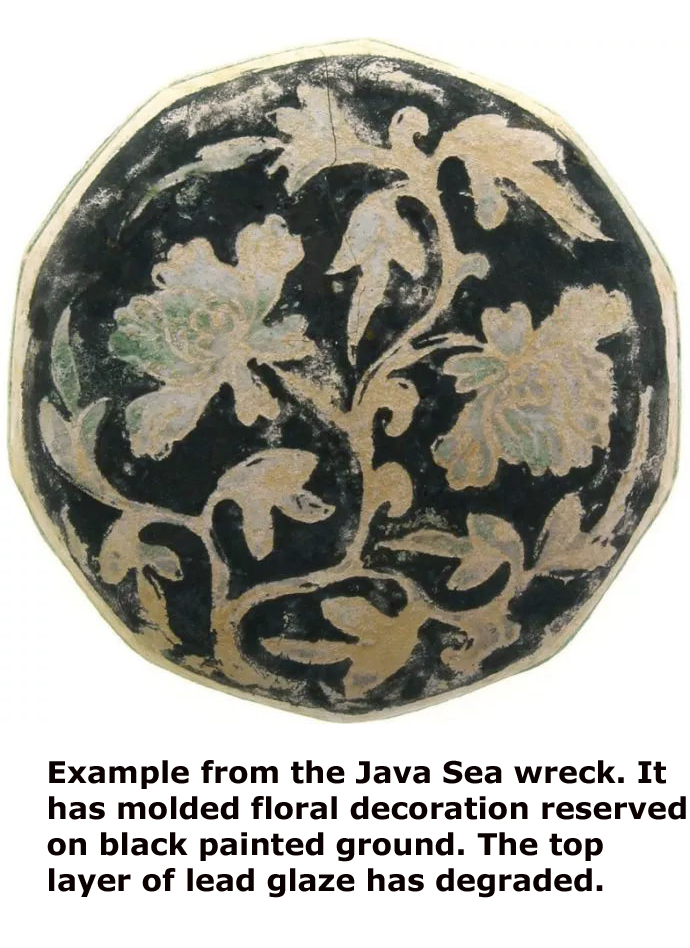
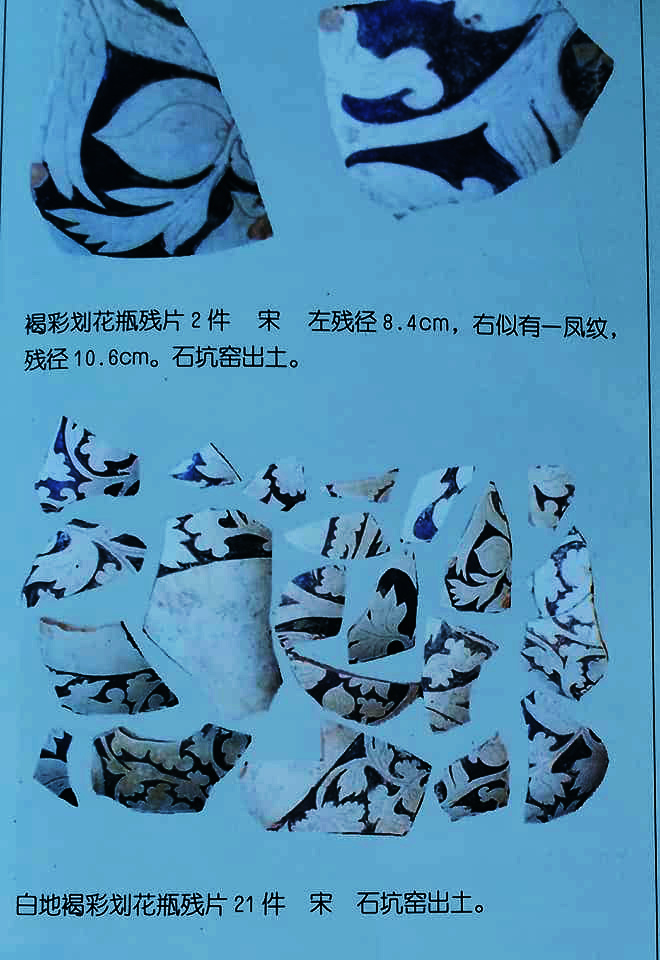
Examples recovered from Fuqing Shikeng kiln
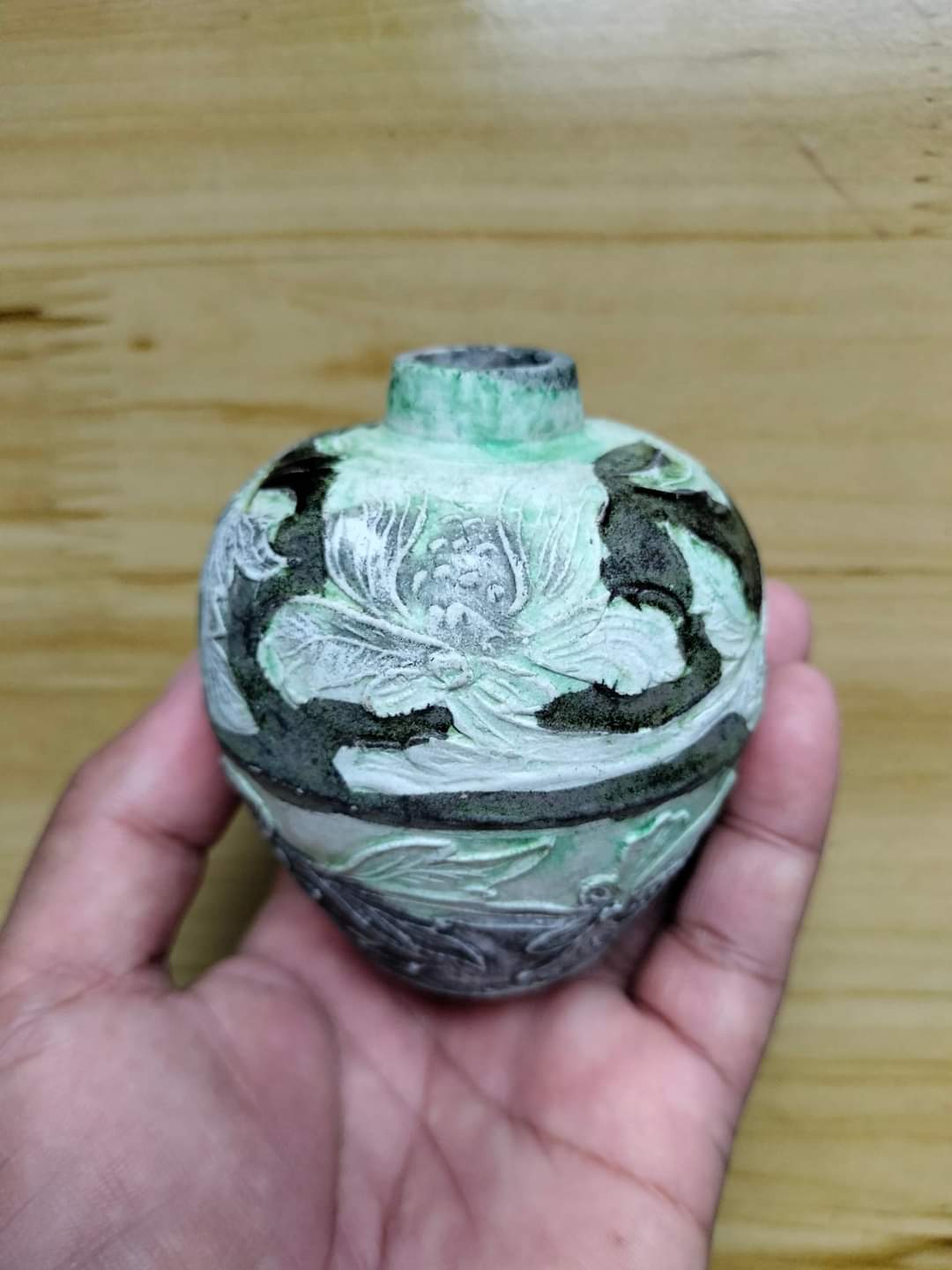 |
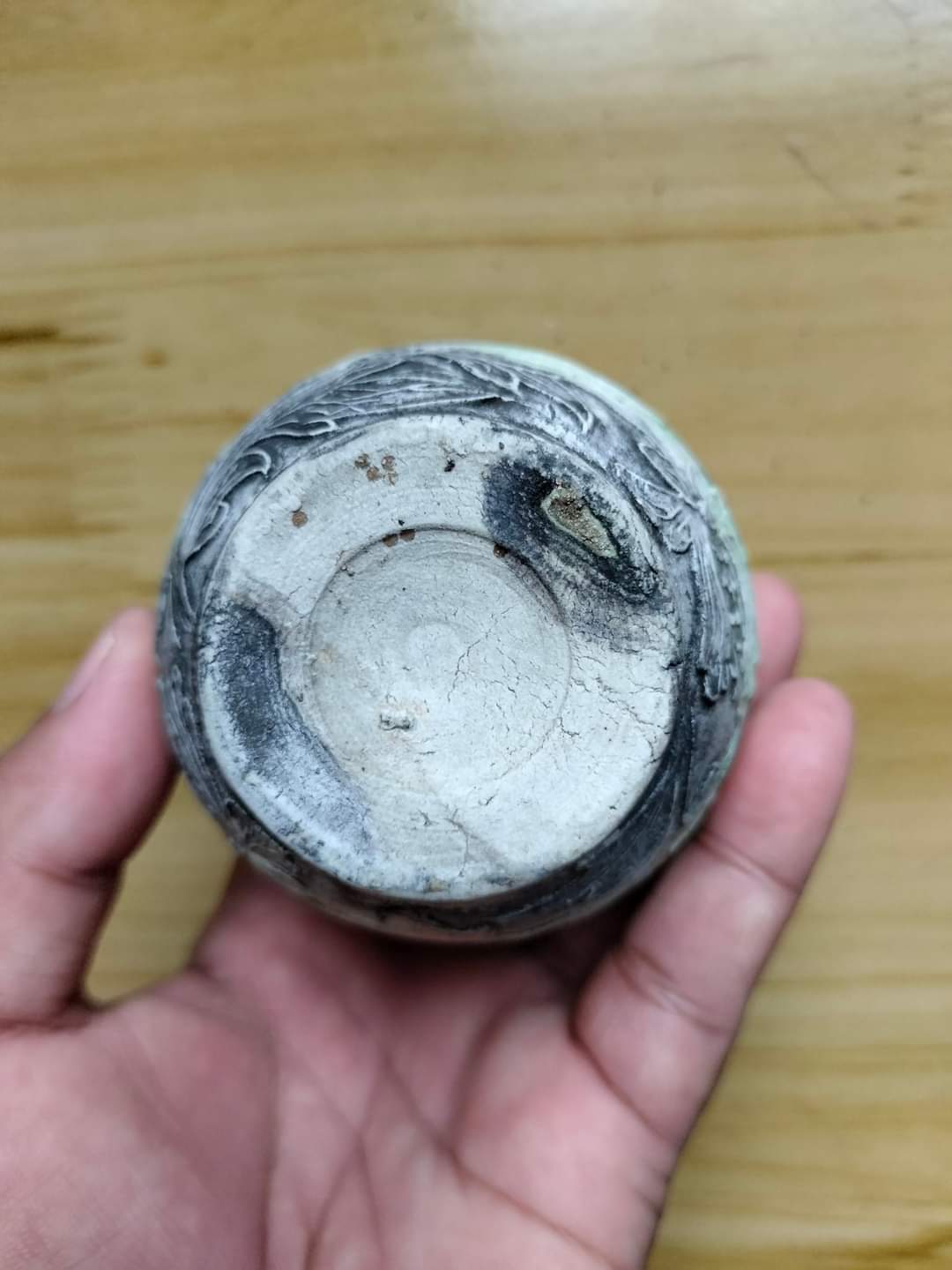 |
| Jarlet with moulded floral decoration with degraded lead green glaze from a site in Sumatra |
Black (Temmoku) wares
Archaeological evidence clearly showed that Fujian black glazed temmoku wares were introduced later than the green glazed wares. The most famous black temmoku wares were produced in the Jianyang kiln. Jian temmoku were highly praised and treasured by the tea connoisseurs from both China and overseas, especially Japan which has some of the best extant pieces in museum and private collections. Due to the strong overseas demand, coastal kilns especially those in Fuqing and Minhou emerged as major exporters. Visually they are different from Jian temmoku bowls. Majority have a light grayish paste and the glaze is not as thick/glossy and the hares' fur effects are not as distinct and attractive. For more on Jian and Jian type temmoku wares, please read this.
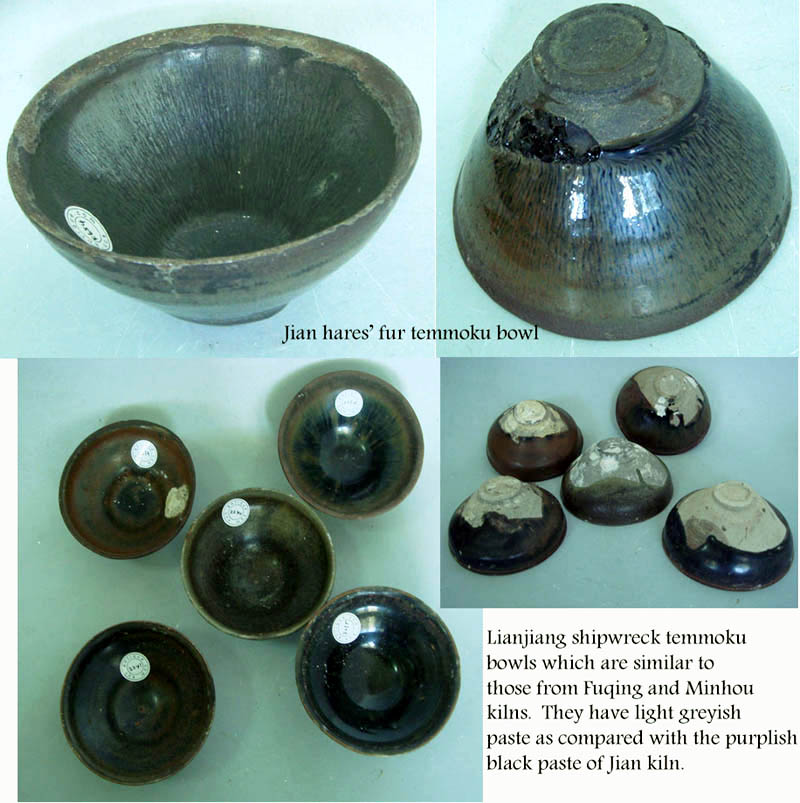
Yuan Fujian Trade Ceramics
Green glaze wares continued to be produced during the Yuan period. But there is a noticeable drop in the quality and export volume. Longquan and Jingdezhen became formidable competitors and dominated the overseas market with better quality celadon and white/qingbai/shufu/blue and white wares respectively.
In Fujian, Putian kilns emerged as an important exporter of celadon wares during the Yuan period. The bowls and plates usually have an unglazed ring on the inner base and decorated with impressed floral motif. Many of such celadon wares were recovered from the Karang Cina wreck near Belitung in 2003.
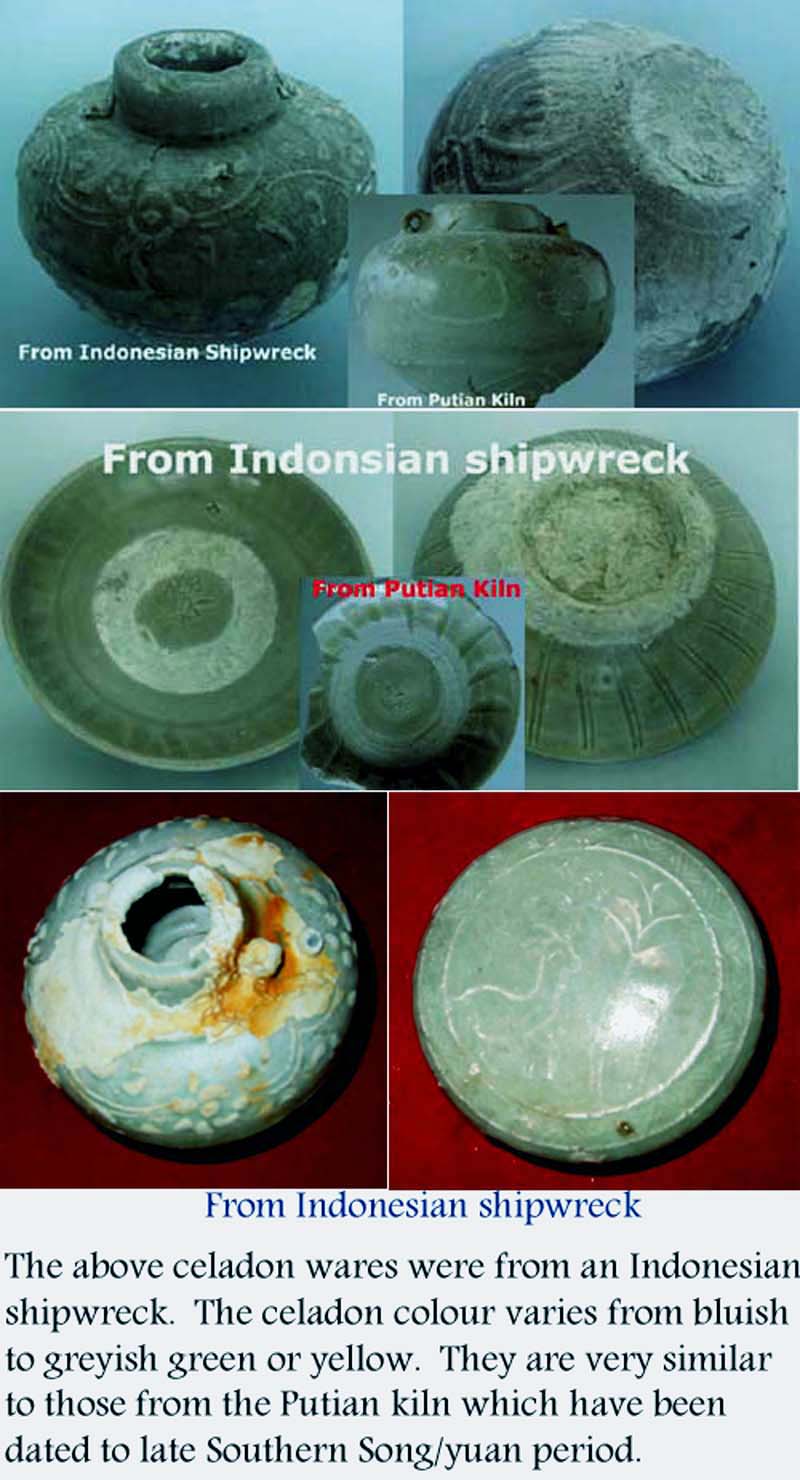
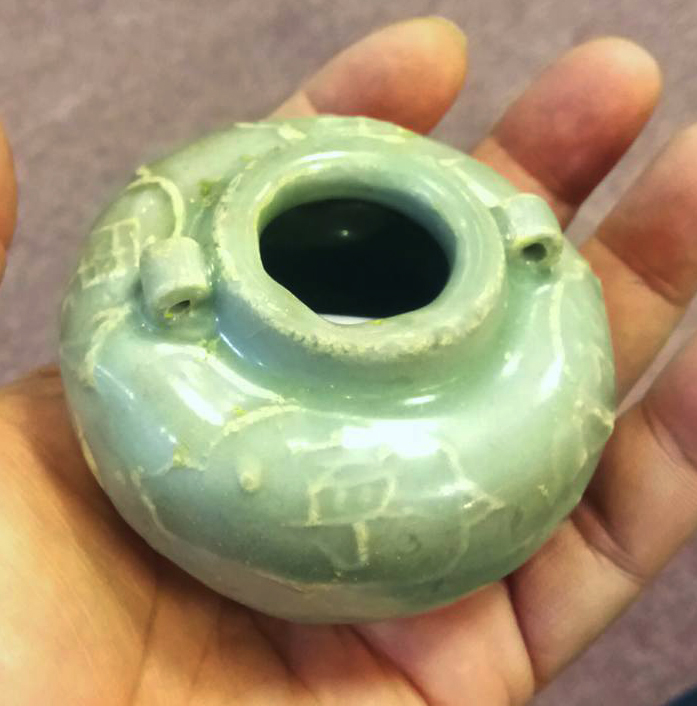
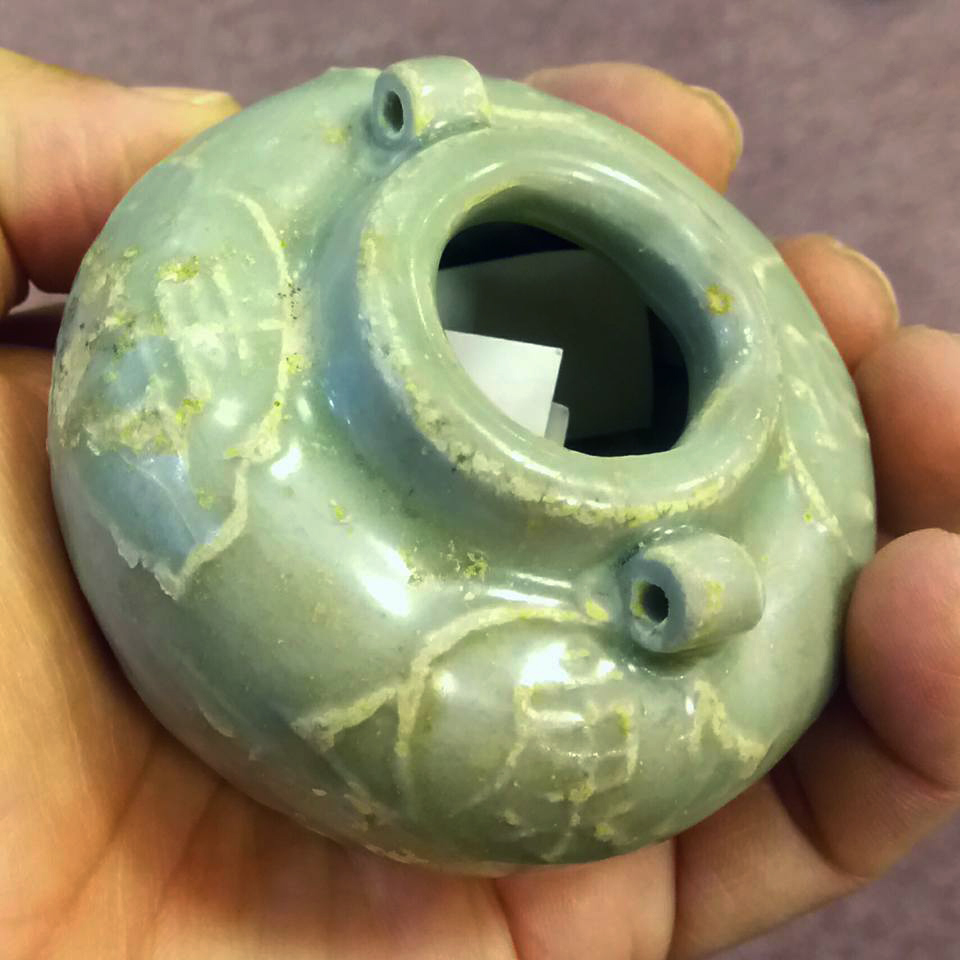
| Rare Putian jarlet with impressed Chinese characters Fu Shou Kang Ning {福寿康宁)i.e. Good Fortune, Longevity and health |
|
|
Dehua kiln continued to be a major producer of export ceramics. Interestingly by this point of time, the glaze has a consistently milky white colour tone. Those with the bluish Qingbai colour constituted the minority and seldom encountered. It should be noted that Putian kiln also produced similar white glaze and may be mistaken for Dehua. However, generally they are of poorer quality and the paste more rough. Anxi kiln was another kiln that produced milky white ware.
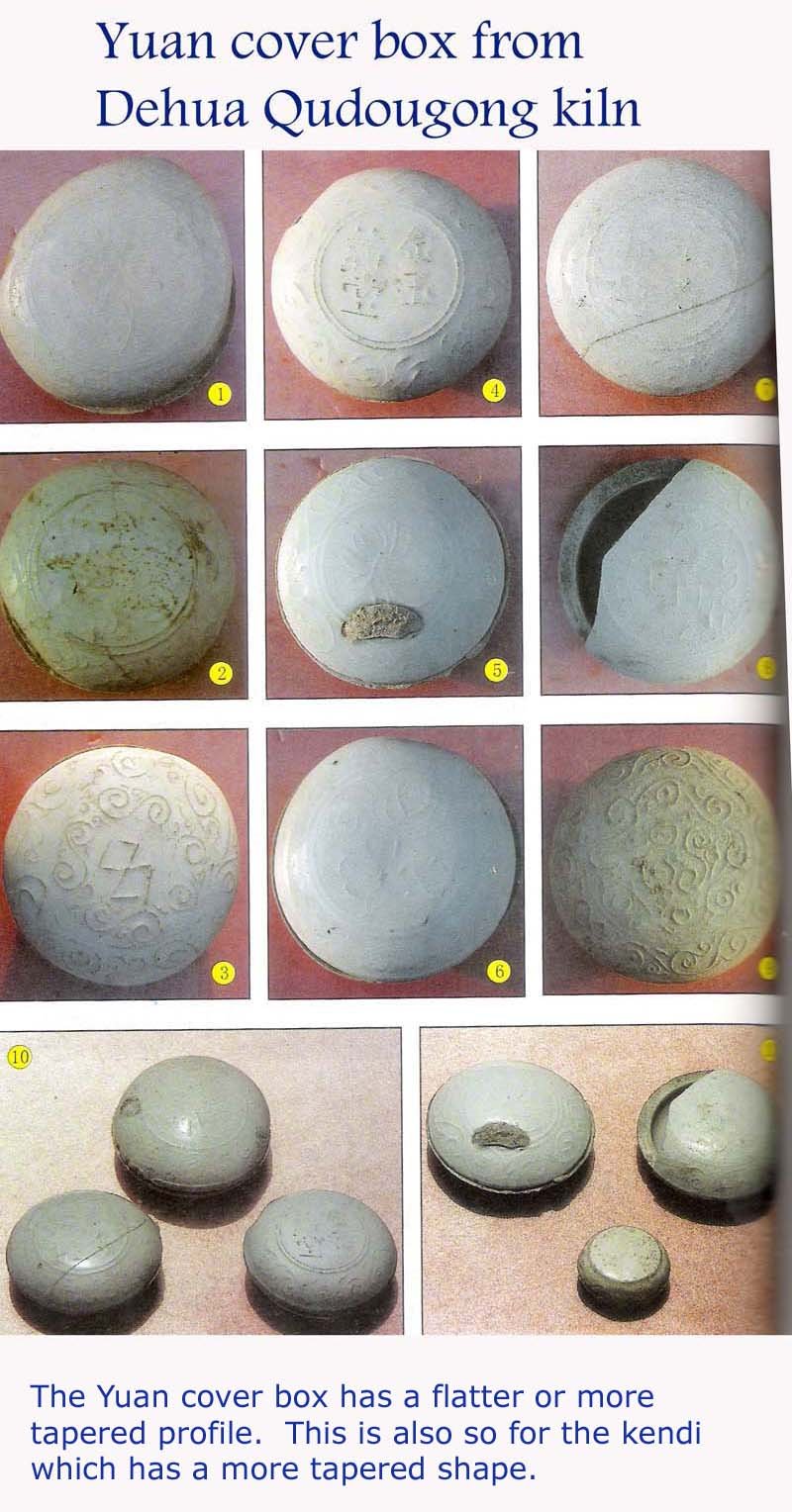
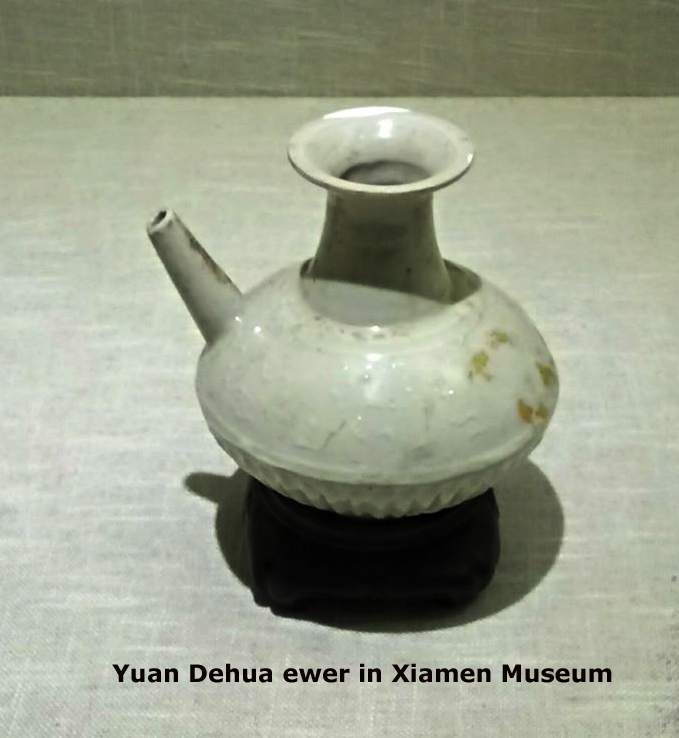
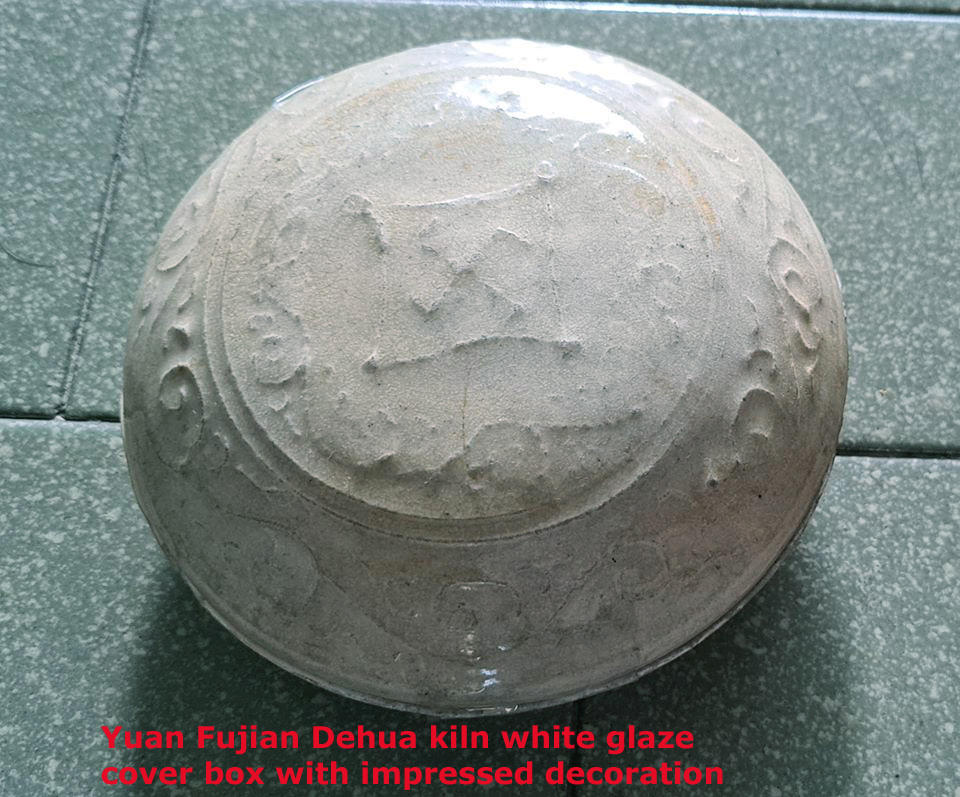
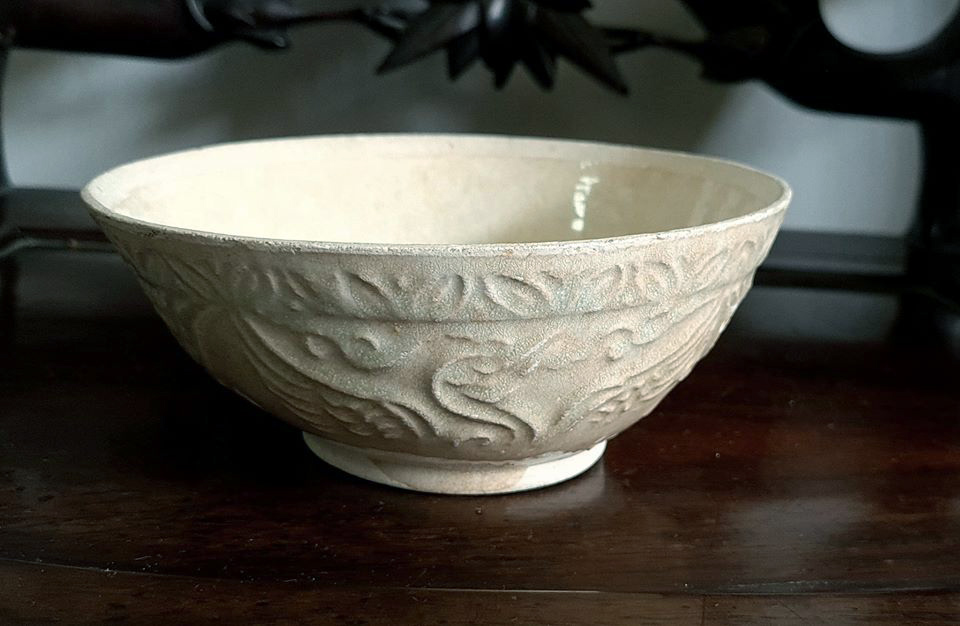
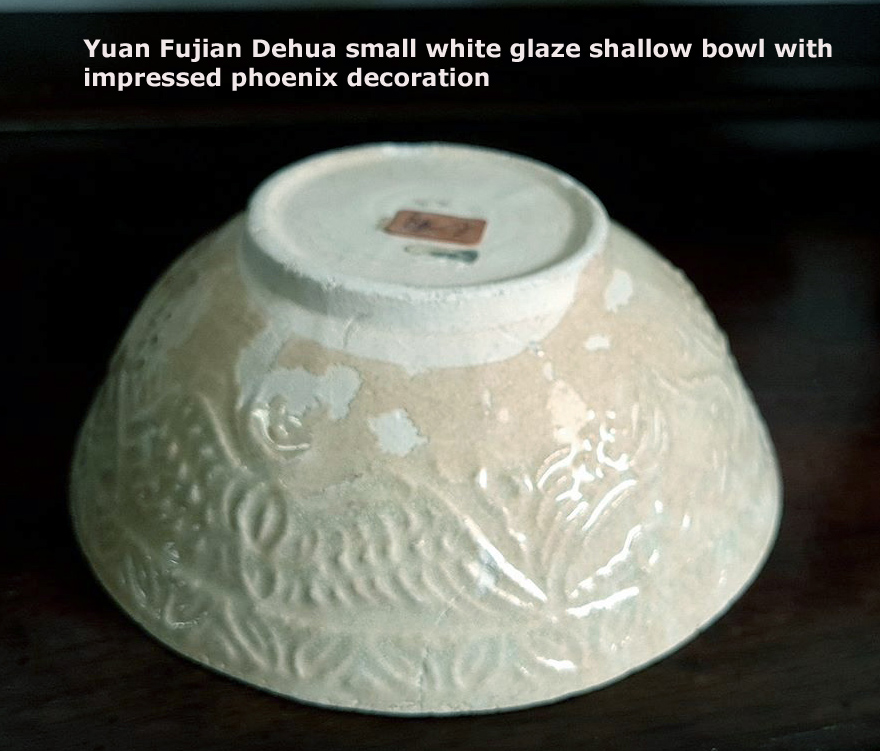
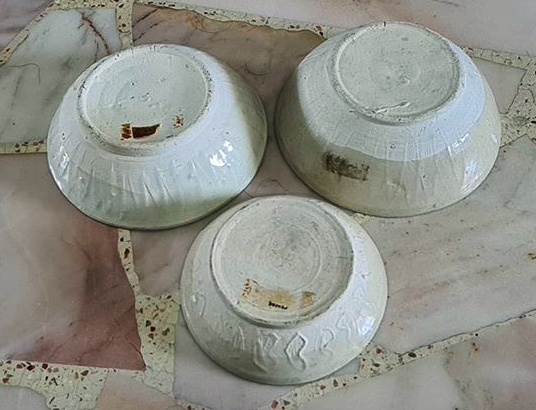
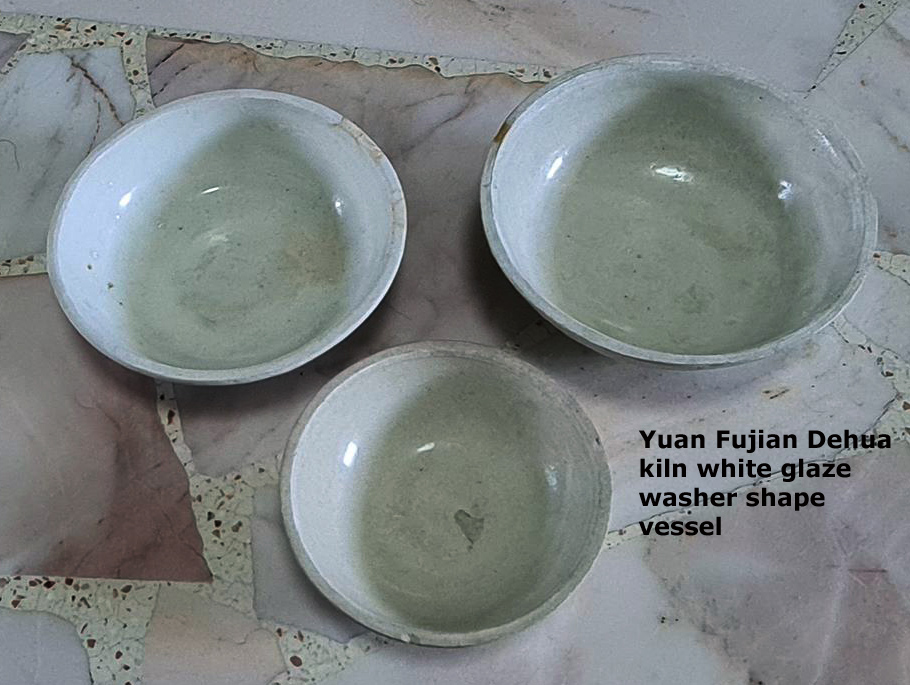
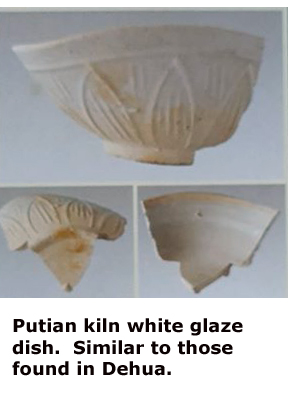
Putian kiln also produced large quantity of qingbai bowls and dishes with impressed decoration. Typically they have an unglaze rim, evidently fired in inverted position, a popular firing method during Yuan period.
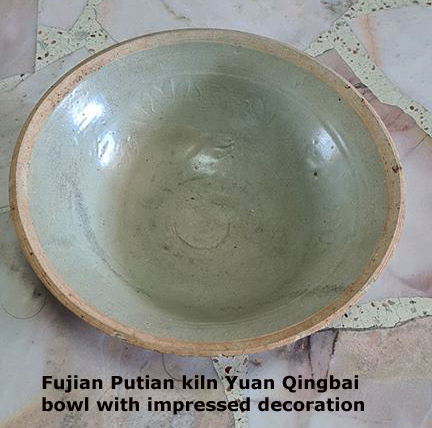
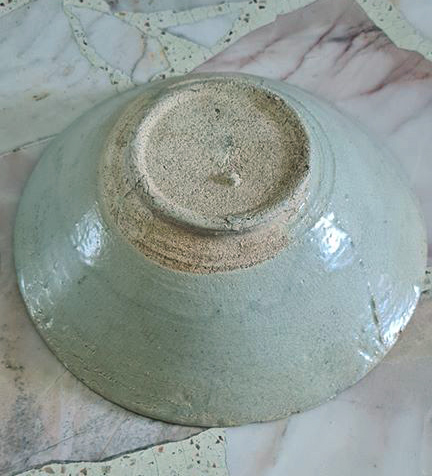
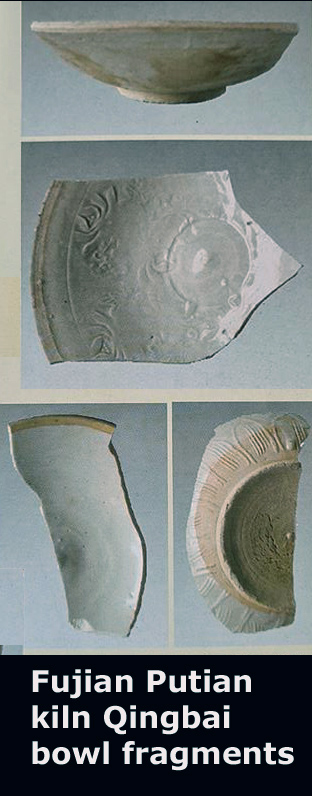
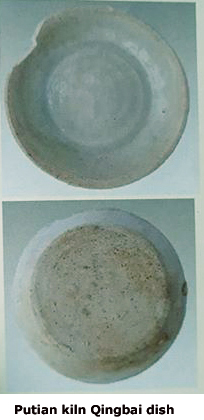
Quanzhou Cizao kiln continued to be an important exporter of brown glaze ware. In 2013, a Yuan wreck was discovered in Binh Chau, Quang Ngai province in Central Vietnam. Among the cargo, there were numerous brown glaze wares from Cizao kiln. Among them, there were also some unique Cizao brown glaze jar with deeply carved motif left unglazed.
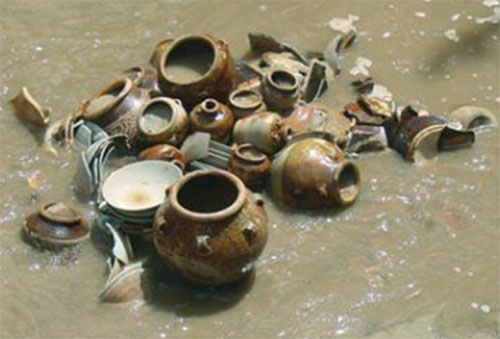
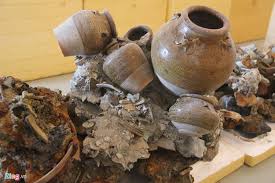
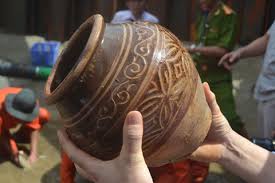
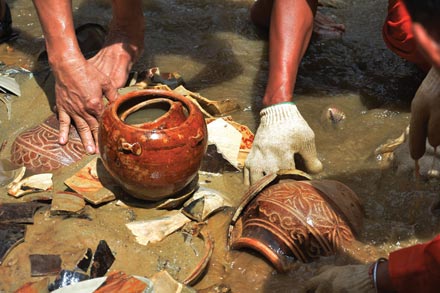
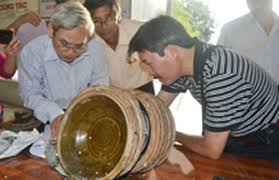
Yuan Cizao brown glaze wares from Vietnam Binh Chau wreck
Yuan period Cizao kiln low fired lead green/yellow glaze wares were commonly found in Southeast Asia. The quantity exported were large and there was wide range of vessels such as kendi, censers, basins, plates, jars and ewers.
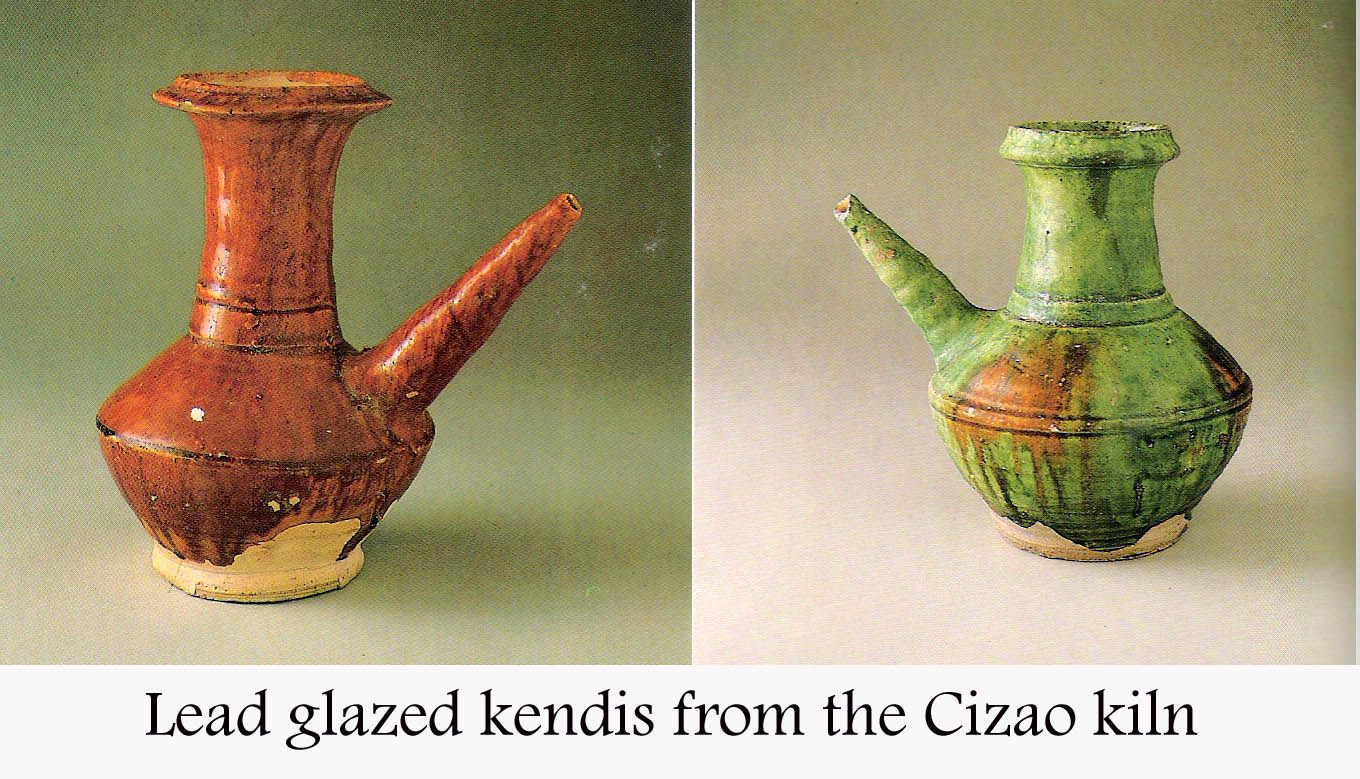
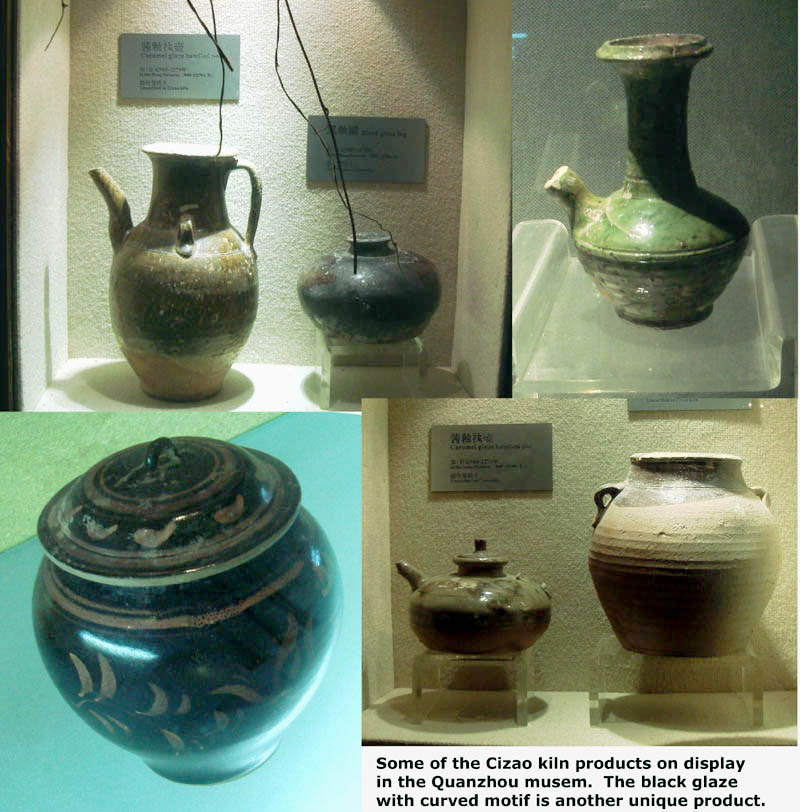
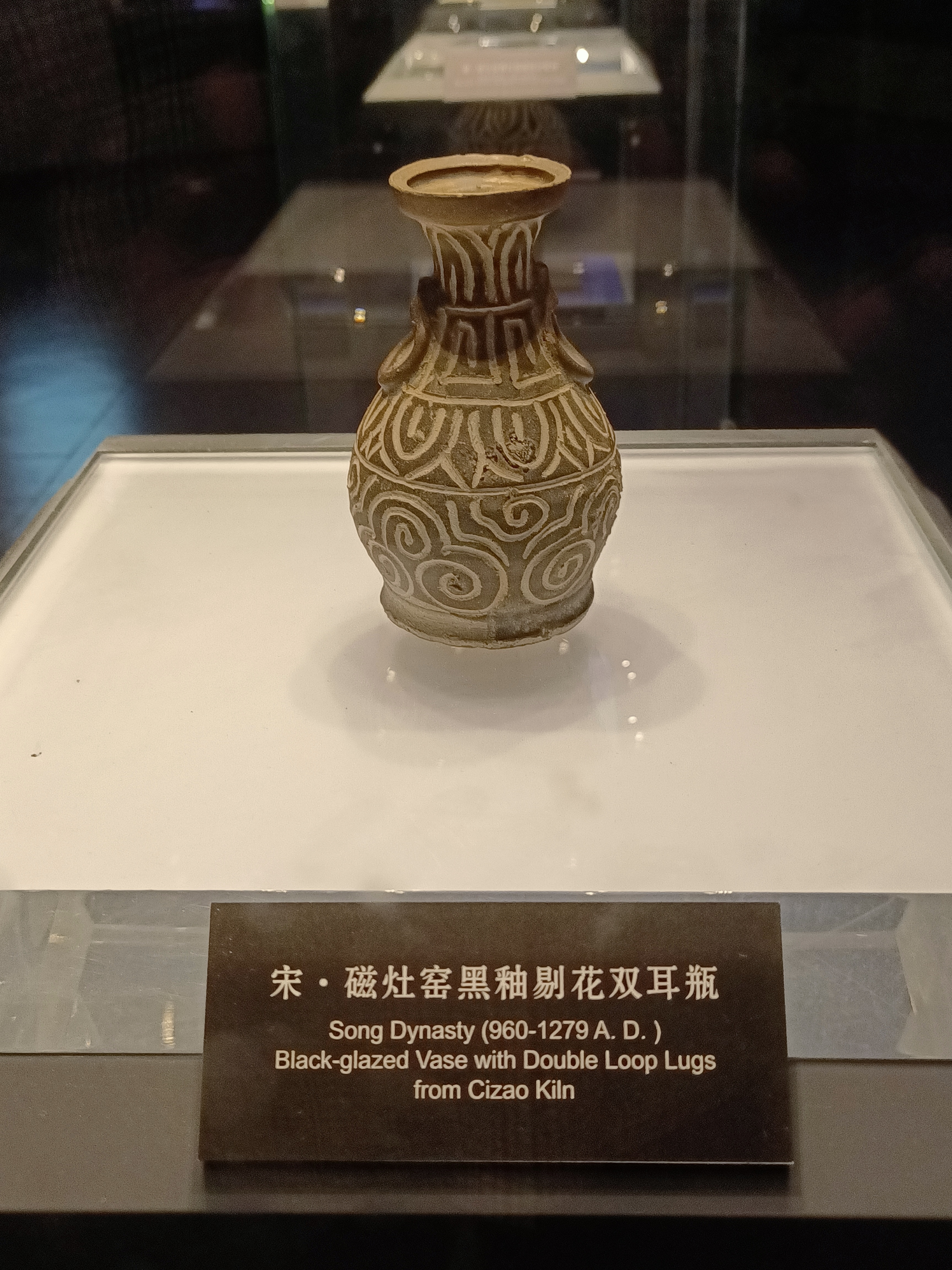
Besides those glazed in monochrome, there were also examples with multi-colour glazes. I came across an interesting and beautiful piece which the Indonesian collector said was excavated from Trowulan.
Late Song/Yuan Cizao sancai
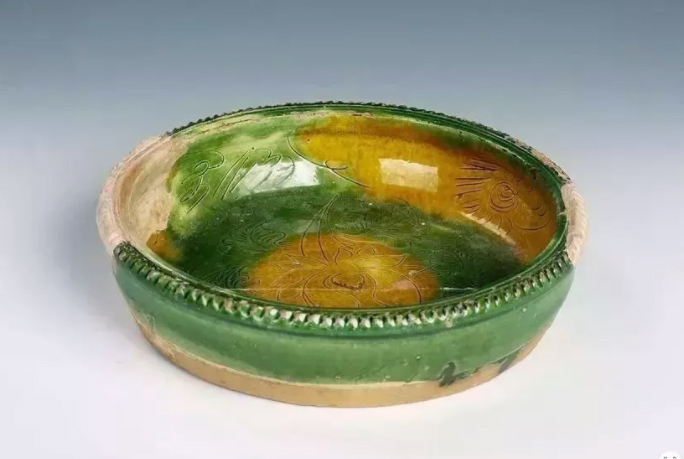
| Yuan Cizao sancai basin with incised decoration. Artefact was recovered in 2016 from an ancient Mid Yuan/Early Ming distribution centre in Jiangsu Taicang Fan Cun Jing (江苏太仓樊村泾). Taicang was an important port during the Yuan/Ming period. |
Ming/Qing Fujian Trade Ceramics
During the early Ming period, ceramics production dropped drastically due to the Hongwu imperial ban on export of ceramics. However when the ban was lifted in 1567 A.D, it heralded another peak in Fujian ceramics production. Yuegang was designated as an international trading port. Zhangzhou capitalised on its proximity to Yuegang and produced blue and white/overglaze enamelled wares, commonly termed Swatow wares. This was a distinctive category of Ming blue and white which attracted strong demand from Southeast Asia consumers.
In Dehua, the potters continued to improve on its white glaze wares and finally introduced the ivory white glaze wares, termed blanc de chine wares in the West. They were much treasured by the European consumers, especially the best which were produced during the late Ming to Early Qing period (17th to early 18th century).
The chaotic transition from Ming to Qing period resulted in the decline and finally demise of Zhangzhou wares. However, kilns in Dehua and neighbouring Yongchun/Anxi expanded further. Besides blanc de chine wares, Dehua potters also started to produce blue and white wares. The early Dehua blue and white wares essentially imitated their Jingdezhen counterpart. However, by Qing Qianlong period Dehua blue and white developed its unique decorative features. Besides Jingdezhen, Dehua became another major supplier of blue and white wares.
Swatow (Zhangzhou) blue and white
Following a lull in Fujian ceramics production from late Yuan to Mid Ming, a distinctive group of Blue and whites and overglaze enamelled wares were produced in the Zhangzhou region. They were characterised by grits adhesion on the outer base. The main market was Southeast Asia but smaller quantity were also found in west asia and East coast of Africa. For more details on the rise of Zhangzhou kilns and the products produced, please read : A General survey of Swatow (Zhangzhou) wares .
The earliest Zhangzhou wares were likely produced during the late Jiajing period. The motifs were executed using calligraphic strokes. The Philippines San Isidro likely carried the earliest production of Zhangzhou ware. They continued to be produced till early Wanli period as substantiated by the finds in the Nan ao 1 shipwreck near Chaozhou .
Ming Jiajing Zhangzhou wares from Nan ao wreck
From mid Wanli period onward, the motif was executed mainly using the outline and wash method and kraak style panelled composition. Such examples were found in the 1600 A.D Ming Wanli San Diego wreck in Philippines and Binh Thuan wreck in Central Vietnam.
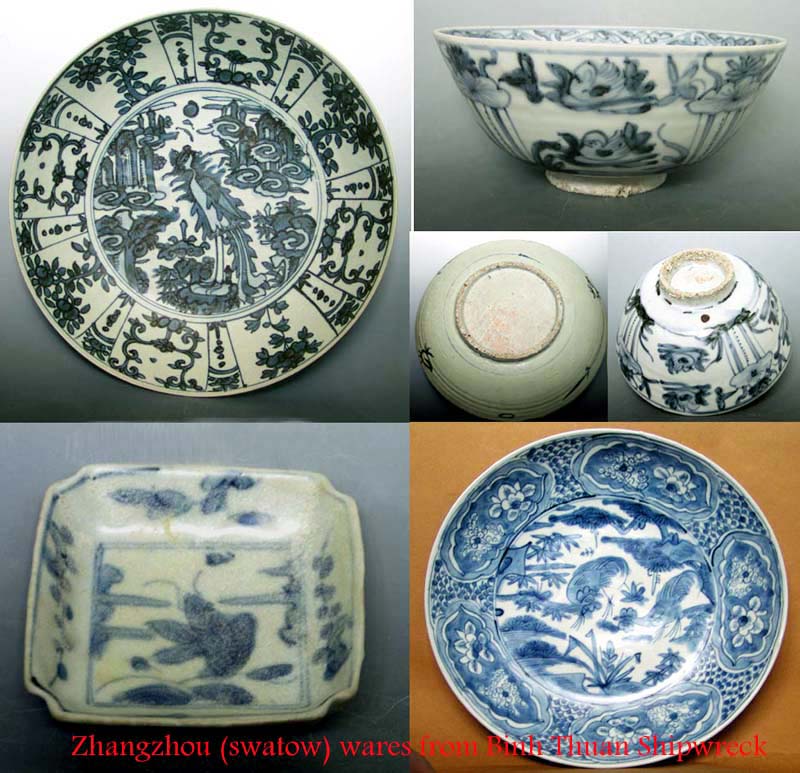
Dehua Blanc de chine wares
During the late Ming period, Dehua exported many varieties of blanc de chine wares: cups, censers, gu-vases, ewers, bowls, large plates, lamp, seated lions, figurines. Blanc de chine ware has a silky ivory white tone and the porcelain is translucent. In this aspect, they were different from the early Dehua wares with the white,bluish white or yellowish white glaze. During the 17th/18th century, many Dehua blanc de chine were exported to Europe. Dehua ivory colour tone blanc de chine was well received in Europe and were widely collected by royal families and nobles.
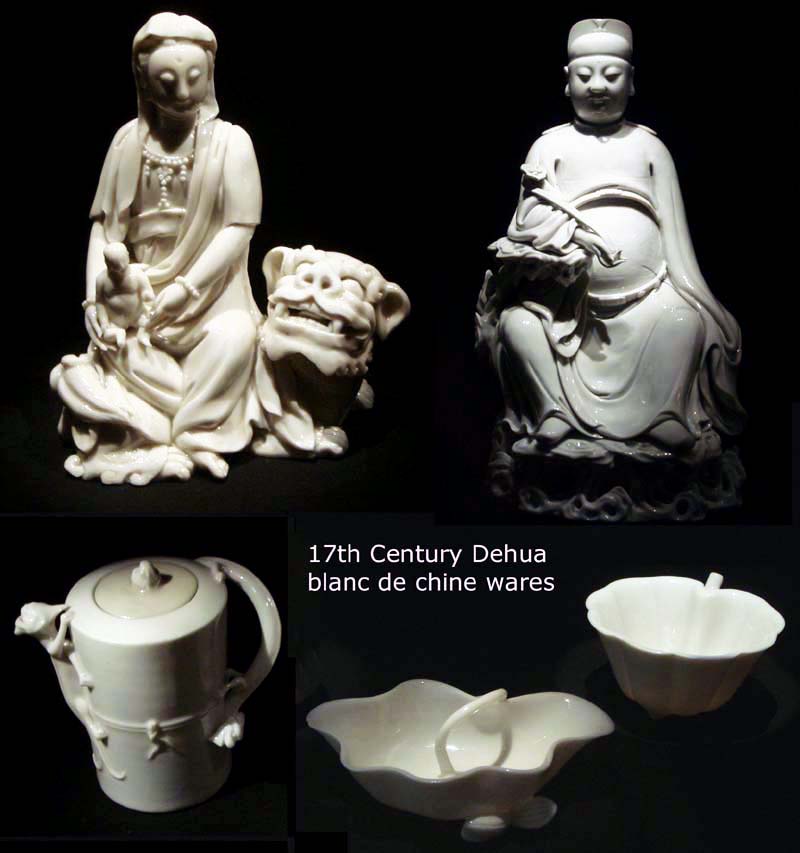
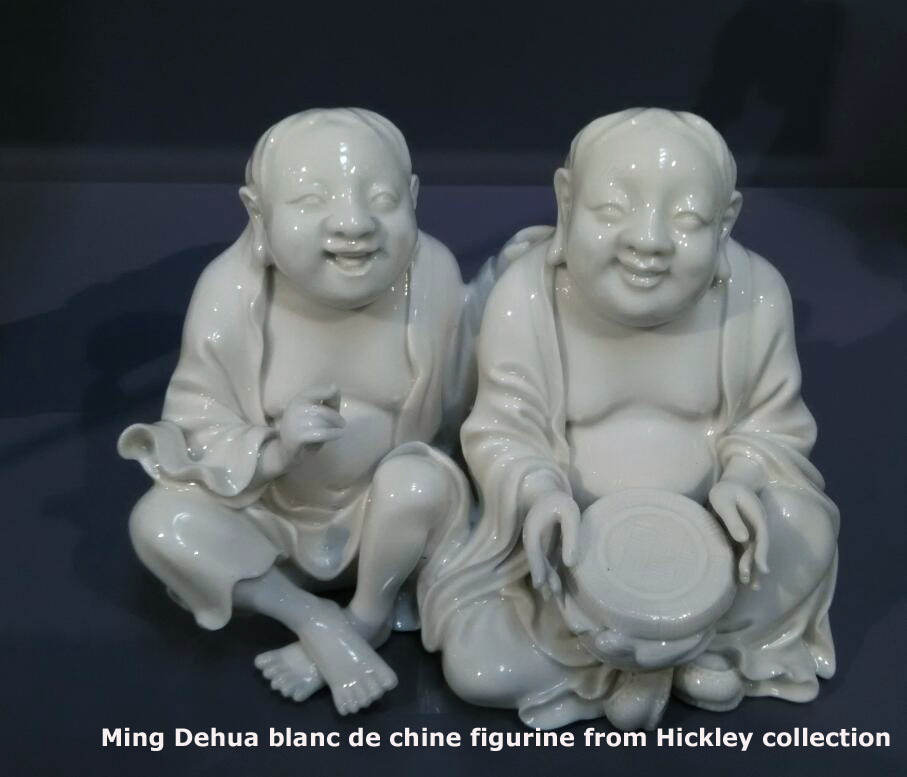
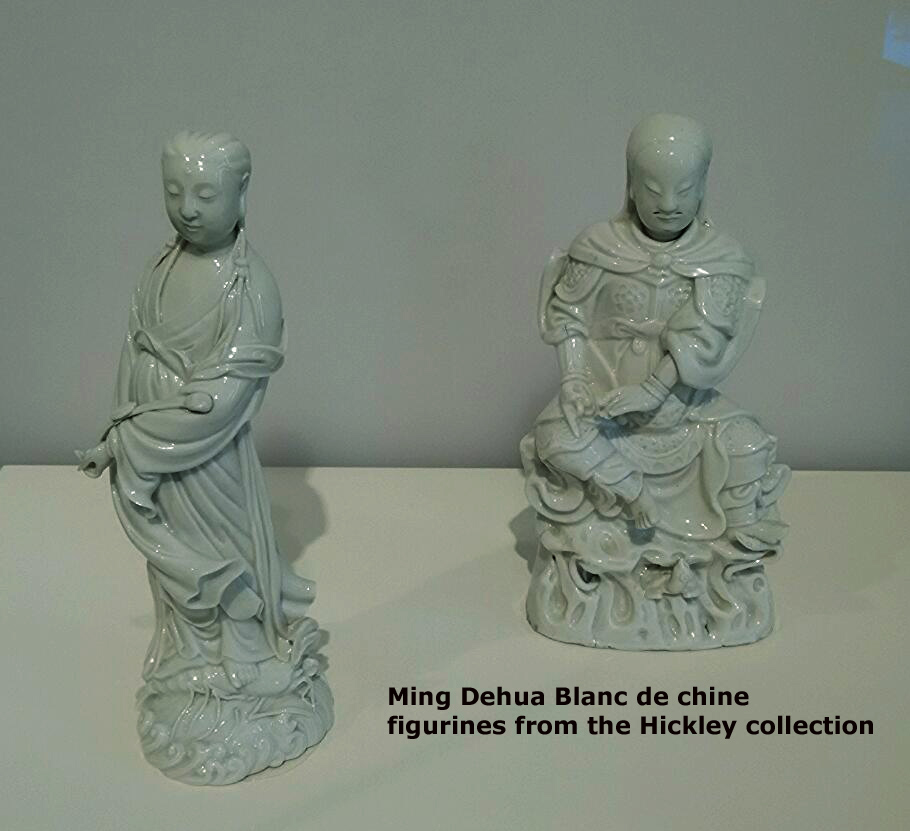
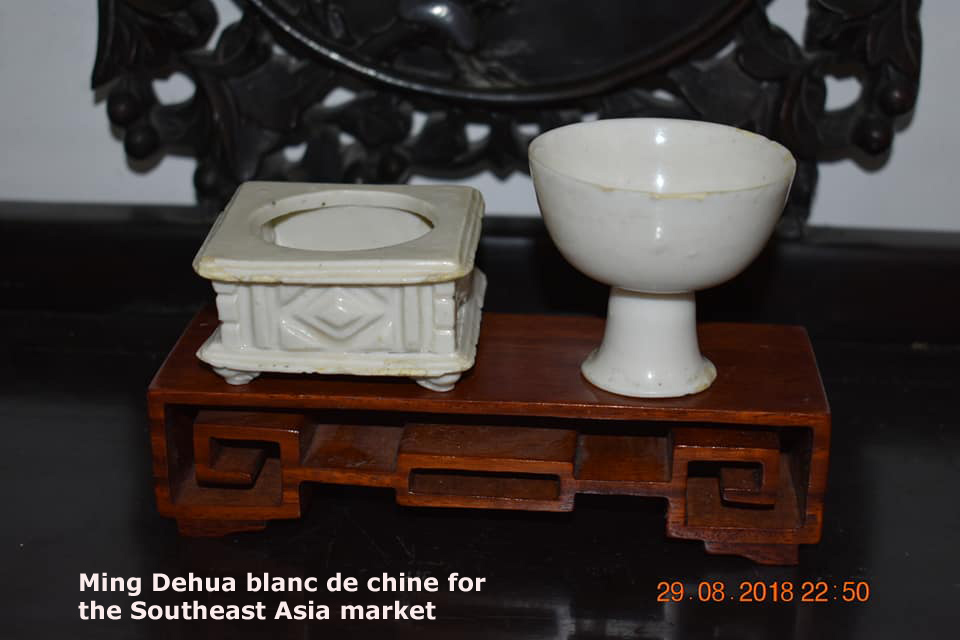
Those from the Early Qing period still retained the ivory tinge glaze but by late Qing, it became a grayish white colour tone.
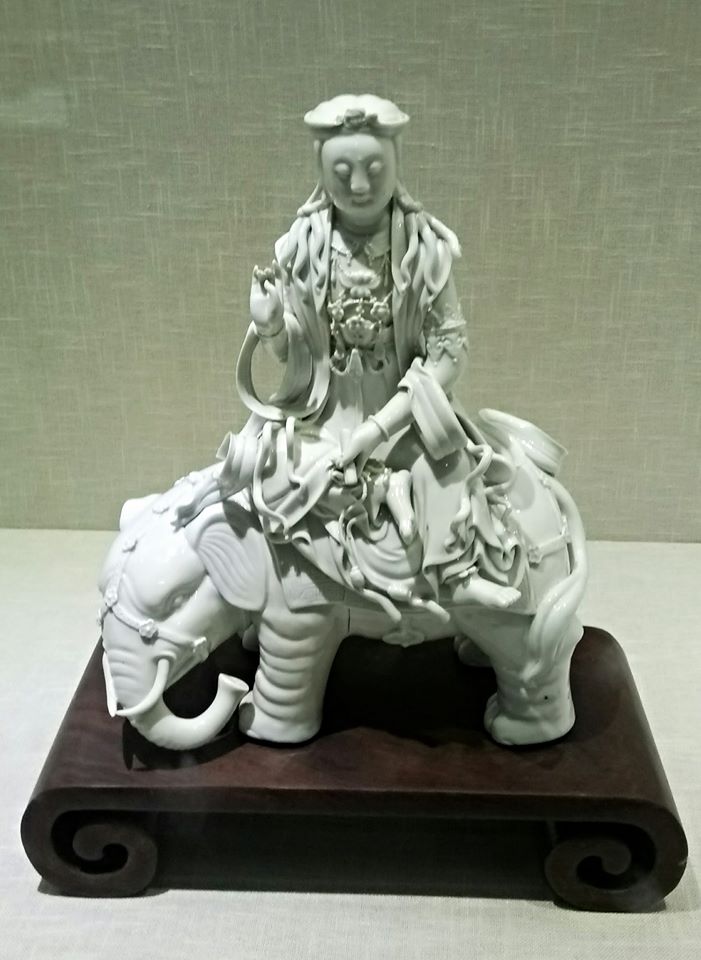
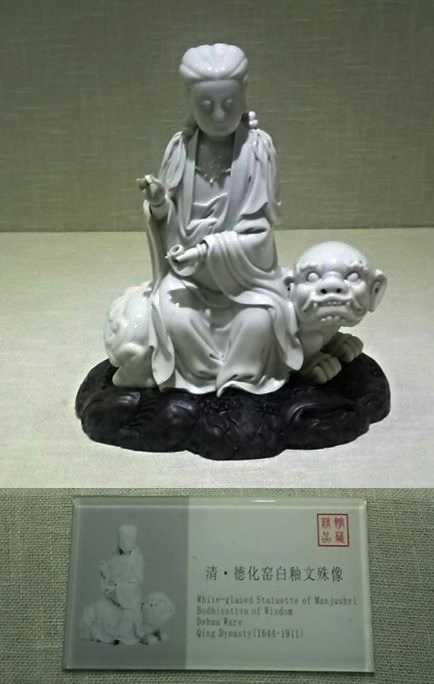
Qing Dehua Blue and white in Xiamen Museum
Qing Dehua blue and white
According to archeological findings, Dehua started production of blue and white by the late Ming Period. However, blue and white ceramics produced were probably very small compared with the blanc de chine wares. But from Qing Kangxi the production of blue and white increased. During the 18th/19th century, Dehua blue and white became major export items. In fact, so far, more than 200 kiln sites producing blue and white have been discovered. The neighouring kilns in Yongchung and Anxi also produced similar types. Generally, those from the Dehua kilns are of better quality. For more, please read : Dehua blue and white.
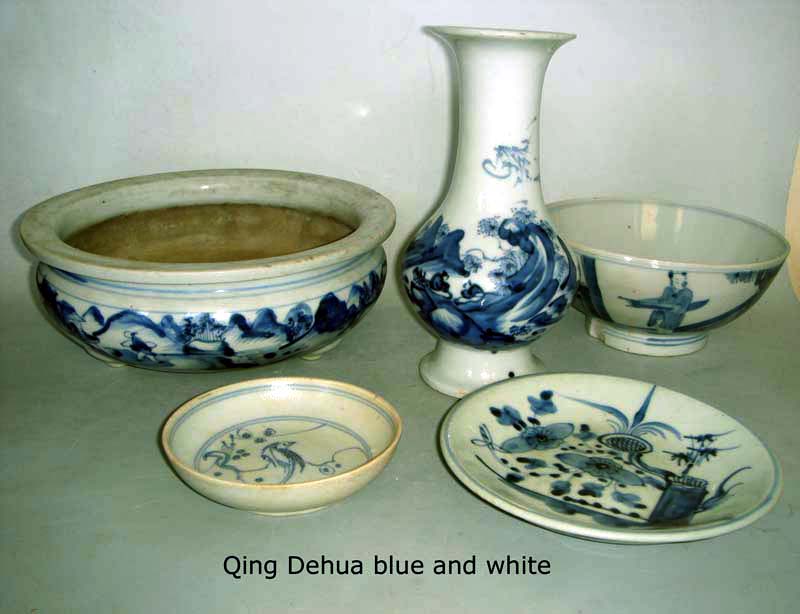
In 1999, Tek Sing cargo which consisted of more than 350,000 mainly Qing Daoguang Dehua/Yongchung/Anxi blue and whites were recovered. The size of the blue and white is an indication of the popularity of the wares. For more on Tek Sing cargo and information on Dehua blue and white, please read: Tek Sing shipwreck (Dehua) blue and white.
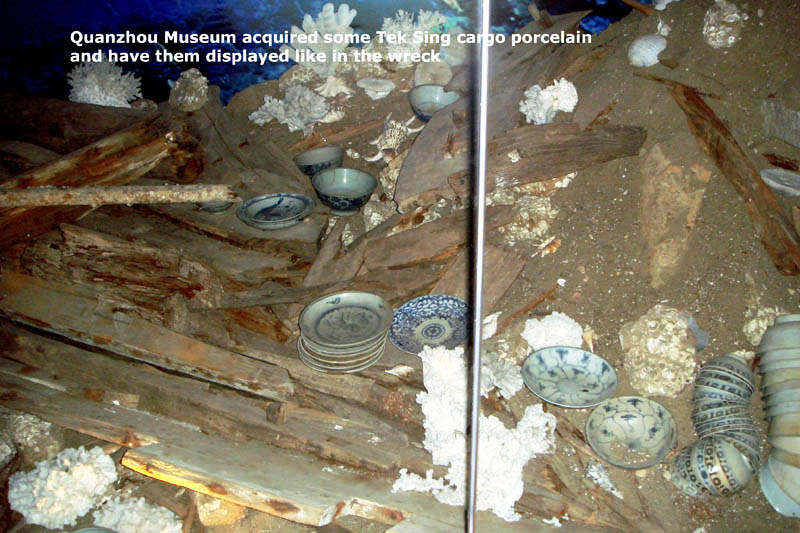
Written by NK Koh (22 Jun 2008), updated 5 Nov 2013, updated 14 Apr 2020, updated 27 Aug 2022, updaed 8 Jun 2024
References:
1. The Jepara Wreck by Atma Djuana and Edmund Edwards Mckinnon
2. Chronology of Longquan Wares of the Song and Yuan Period by Kamei Meitoku. Article published in the book "New Light on Chinese Yue and Longquan wares" edited by Chumei Ho.
3. 福建陶瓷考古概论 (曾凡著)
4. 德化窑 published by Dehua Museum